Quiz - 01
Ramkinkar Baij - Journey through silent transformation and expressions
Send your answer to : ngma.virtual@gmail.com by 02nd June 2020 11:59 PM
Note: 1) Must mention QUIZ No., Your Name in your reply2) Reply Should contain only correct answers (for example 1(b), 2(d), 3(a) etc.)
1. Ramkinkar Baij was an iconicÖ..?
- (a) sculptor
- (b) architect
- (c) physician
- (d) musician
2. After completing his studies at Kala Bhavana he became a faculty member. Where was he teaching?
- (a) JNU
- (b) Santiniketan
- (c) Delhi University
- (d) Village School
3. In which year Ramkinkar Baij made his way to Kala Bhavana?
- (a) 1926
- (b) 1970
- (c) 1925
- (d) 1926
4. Ramkinkar started his art education at Kalabhavan under the guidance of?
- (a) Upendra Maharathi
- (b) R N Tagore
- (c) Benodebehari Mukherjee
- (d) Nandalal Bose
5. Ramkinkar was invited to participate in the Salon des Rťalitťs Nouvelles?
- (a) 1950
- (b) 1970
- (c) 1957
- (d) 1979
Ministry of Culture, Government of India
-

Ramkinkar Baij (1906 - 1980) - one of the most outstanding artists of modern India
-

Ramkinkar Baij challenges you with his personality and with the variety of his work that has proven to be equally engaging.
-

Ramkinkar Baij is widely recognised as one of the first bridge builders between Indian and Western modern art.
-

K.G. Subramanyan with Ramkinkar Baij
-

Ramkinkar as a student with Nandalal Bose
-

Ramkinkar with his relatives and Radharani
-

Ramkinkar in 1940
-

Ramkinkar with Nandalal Bose, K.G. Subramanyan, Krishna Reddy and others.
-

Old Kala Bhavan building, Santiniketan
-

Ramkinkar in 1940
-

Ramkinkar with Benodebehari Mukherjee
-

Nandalal Bose (standing) observing Ramkinkar and other students at work
-

Nandalal Bose with students including K.G.Subramanyan with Krishna Reddy
-

Ramkinkar with Nandalal Bose , Benodebehari and others in Santiniketan, 1936
-

Ramkinkar at work
-

Ramkinkar at Santiniketan
-

Shyamali, mud house in Uttarayan Complex, Santiniketan
-

Ramkinkar with 'Santhal Family'
-

Ramkinkar at work
-

Ramkinkar Baij
-

Ramkinkar in tribal identities
-

Ramkinkar Baij in a mood to create
-

Ramkinkar at work on Rabindranath Tagore, 1940
-

Ramkinkar with Binodini in Shilong
-

Ramkinkar (standing), Benodebehari Mukherjee and Leela Mukherjee with Binodini (right)
-

Ramkinkar with Radharani, 1977
-

Ramkinkar at work
-

Ramkinkar in thoughtful mood
-

Ramkinkar with students at Kala Bhavan, Santiniketan
-

Ramkinkar at work
-

Ramkinkar near his work
-

Ramkinkar with Dinkar Kowshik
-

Ramkinkar with Sarbari Ray Choudhury, 1975
-

Ramkinkar emphasized to become a standard bearer of humanity and a speaker for the down trodden and exploited.
-

Ramkinkar at work
-

Ramkinkar near his work
-

Ramkinkar - observation and emotional response
-

Ramkinkar Baij
-

Ramkinkar in his moment notations with an instinctive fusion of thoughts.
-

There is also another dimension of Ramkinkar that the watercolours bring into focus. He was for all his modernism a man who was most at home in rural settings where life was more in harmonywith nature and human
-

Ramkinkar with originality of his modernist vision
-

His ideas of art and modernism did not emanate from any theory but from his love for the world and his love for man.
-

Man for him was essentially the working man and his love for man was love for the working man.
-

His love itself remained undiminished. He always remained close to the men he painted and was extremely earnest in his commitments. Therefore, his angerwas always direct and never softened. The other side of his love for man was his bilief in humanity.
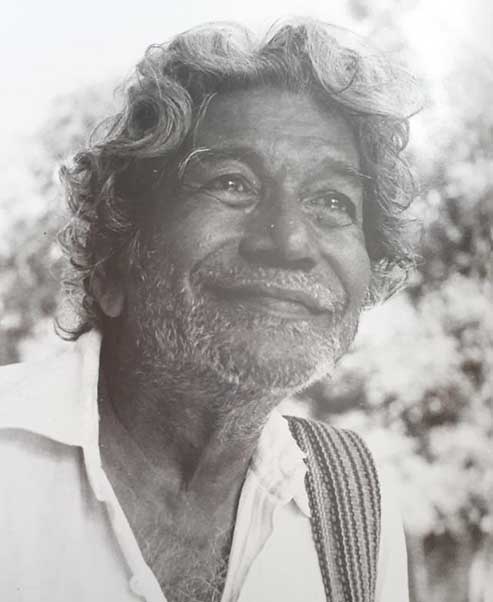
Ramkinkar Baij
(25.05.1906 Ė 02.08.1980)
A tribute to Ramkinkar Baij | One of the earliest modernists in Indian ArtĒ on his Birth Anniversary.
Artist's Profile
Ramkinkar Baij, one of the most seminal artists of modern India, was an iconic sculptor, painter and graphic artist. Ramkinkar Baij (1906-1980) was born in Bankura, West Bengal, into a family of little economic and social standing and grew by his sheer determination into one of the most distinguished early modernists of Indian art. In 1925, he made his way to Kala Bhavana, the art school at Santiniketan and was under the guidance of Nandalal Bose. Encouraged by the liberating, intellectual environment of Santiniketan, his artistic skills and intellectual horizons blossomed, thus acquiring greater depth and complexity. Soon after completing his studies at Kala Bhavana he became a faculty member, and along with Nandalal Bose and Benodebehari Mukherjee played a pivotal role in making Santiniketan one of the most important centres for modern art in pre-Independent India. Ramkinkar's monumental sculptures are established landmarks in public art. One of the earliest modernists in Indian art, he assimilated the idioms of the European modern visual language and yet was rooted in his own Indian ethos. He experimented restlessly with forms, moving freely from figurative to abstract and back to figurative, his themes were steeped in a deep sense of humanism and an instinctive understanding of the symbiotic relationship between man and nature. Both in his paintings and sculptures, he pushed the limits of experimentation and ventured into the use of new materials. For instance, his use of unconventional material, for the time, such as cement concrete for his monumental public sculptures set a new precedent for art practices. The use of cement, laterite and mortar to model the figures, and the use of a personal style in which modern western and Indian pre-classical sculptural values were brought together was equally radical.
Although, his work was passed over for quite a while, gradually it began to get both national and international attention. He was invited to participate in the Salon des Rťalitťs Nouvelles in 1950 and in the Salon de Mai in 1951. In the national honours began to come his way one after the other. In 1970, the Government of India honoured him with the Padma Bhushan for his irrefutable contribution to Indian art. In 1976 he was made a Fellow of the Lalit Kala Akademi. In 1976, he was conferred the honorary Doctoral Degree of ĎDesikottamaí by Visva Bharati, and in 1979 an honorary D.Litt by Rabindra Bharati University.
Ramkinkar made his last journey, after a period of illness, in Kolkata on the 2nd August, 1980.

Research Material
Team JATAN, NGMA New Delhi
Concept, Design & Development
S S Paul, Systems Manager, IT Cell, NGMA
Content Management
IT Cell
Title Image of Ramkinkar Baij
&
Resources for ĎJeevansmritií
Re-photographed from the book ĎRamkinkar Baij Ė A Retrospective, published by Delhi Art Gallery in collaboration with the National Gallery of Modern Art, New Delhi in conjunction with the Retrospective exhibition of Ramkinkar Baij in February, 2012
Page Flip
Software tool: Anyflip
-
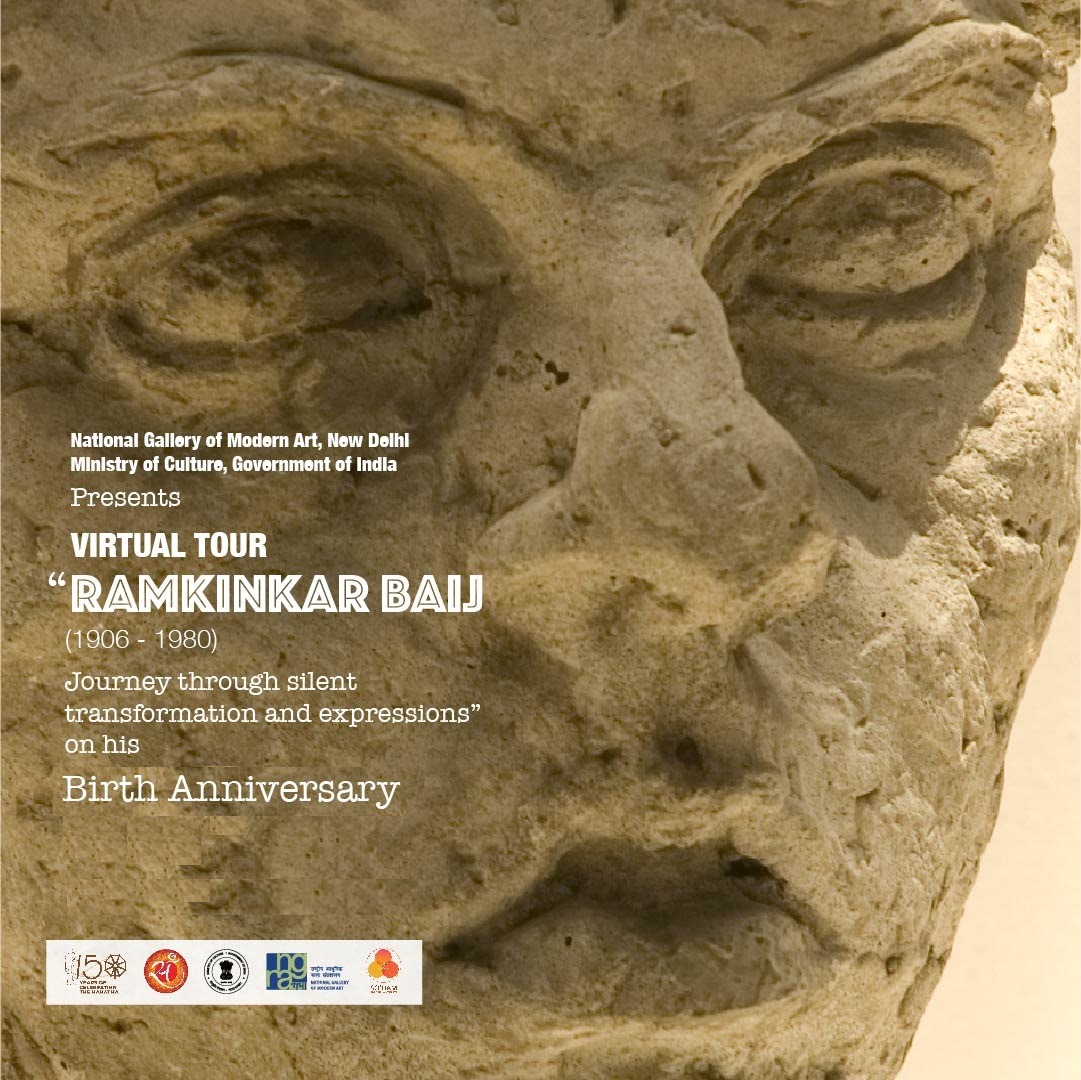 ××××
××××Concept Note
Virtual Tour
Ramkinkar Baij | Journey through silent transformation and expressions The Virtual Tour titled ďRamkinkar Baij | Journey through silent transformation and expressionsĒ is organized to commemorate the 115th Birth Anniversary of Ramkinkar Baij on 26th May 2020. Ramkinkar Baij, one of the most seminal artists of modern India, was an iconic sculptor, painter and graphic artist. In 1970, the Government of India honoured him with the Padma Bhushan for his irrefutable contribution to Indian art. Ramkinkar's monumental sculptures are established landmarks in public art. One of the earliest modernists in Indian art, he assimilated the idioms of the European modern visual language and yet was rooted in his own Indian ethos. He experimented restlessly with forms, moving freely from figurative to abstract and back to figurative, his themes were steeped in a deep sense of humanism and an instinctive understanding of the symbiotic relationship between man and nature. Both in his paintings and sculptures, he pushed the limits of experimentation and ventured into the use of new materials. For instance, his use of unconventional material, for the time, such as cement concrete for his monumental public sculptures set a new precedent for art practices. The NGMA takes pride in 639 works of art created by the iconic artist. This virtual tour presents the 520 works of art from the prominent artworks of Ramkinkar Baij from reserve collection of NGMA, grouped in a series of five different themes of (i) Portrait, (ii) Life Study, (iii) Abstract & Structural Composition, (iv) Nature Study & Landscape and (v) Sculptures. This virtual tour also showcases three sketch books from the collection of NGMA containing 182 works of art. I would urge our esteemed visitors to visit our web site to explore the complete works of art of Ramkinkar Baij through his silent transformation and expressions. I take pride of the tireless effort of our entire IT Cell to conceive and conceptualize the idea of launching Virtual Tours and designed and developed the same amidst lock down period to facilitate our esteemed visitors with the prestigious collection of NGMA. -
Portrait

Binodini, 1948 Acc. No. 2820 | Watercolour on paper
-
Portrait
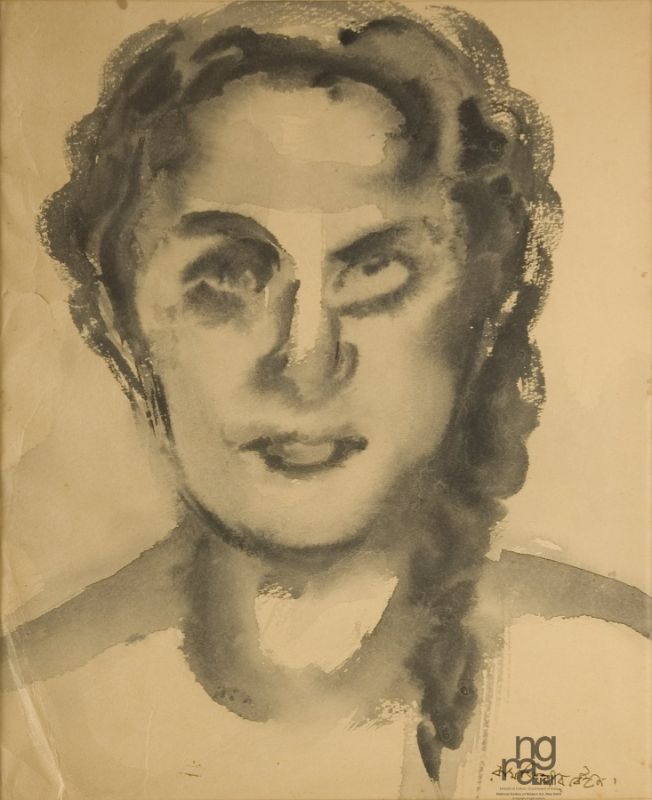 ×Ramkinkar Baijís artistic temperament was defined at Santiniketan an art institution known for providing an informed western modernistic environment to the students. Baij was immensely influenced by his austere surroundings, the ordinary people and nature that became the subject matter for painting and sculpture. In the above painting, the artist has depicted "Bani" delineated with dabs and dashes of black colour. The treatment is intended to exemplify an energetic and lively artistic temperament.
×Ramkinkar Baijís artistic temperament was defined at Santiniketan an art institution known for providing an informed western modernistic environment to the students. Baij was immensely influenced by his austere surroundings, the ordinary people and nature that became the subject matter for painting and sculpture. In the above painting, the artist has depicted "Bani" delineated with dabs and dashes of black colour. The treatment is intended to exemplify an energetic and lively artistic temperament. -
Portrait
 ×Ramkinkar Baij was immensely influenced by his austere surrounding, the ordinary people and the nature that it became its subject matter for painting and sculpture. Ramkinkar Baij was immensely influenced by his austere surrounding, the ordinary people and the nature that became his subject matter for painting and sculpture. In this panting, he has rendered a self-portrait with dabs and dashes of watercolour merging together in tonal variation and defining the contours of a face.
×Ramkinkar Baij was immensely influenced by his austere surrounding, the ordinary people and the nature that it became its subject matter for painting and sculpture. Ramkinkar Baij was immensely influenced by his austere surrounding, the ordinary people and the nature that became his subject matter for painting and sculpture. In this panting, he has rendered a self-portrait with dabs and dashes of watercolour merging together in tonal variation and defining the contours of a face. -
Portrait
 ×Ramkinker Baij's sculptures as well as paintings have a expressionist tendency. For his sculptures he used local materials generously and worked with the technique of modelling and carving. His work are characterised by tremendous energy. This zeal of his is reflected in all his works, be it any medium. His sculptures reflect an abstraction in form, a distorted anatomy, but highlights the characteristics defining the form. †
×Ramkinker Baij's sculptures as well as paintings have a expressionist tendency. For his sculptures he used local materials generously and worked with the technique of modelling and carving. His work are characterised by tremendous energy. This zeal of his is reflected in all his works, be it any medium. His sculptures reflect an abstraction in form, a distorted anatomy, but highlights the characteristics defining the form. † -
Portrait
 ×A cement bust in his signature style depicting the portrait of a lady named "Jaya".
×A cement bust in his signature style depicting the portrait of a lady named "Jaya". -
Portrait
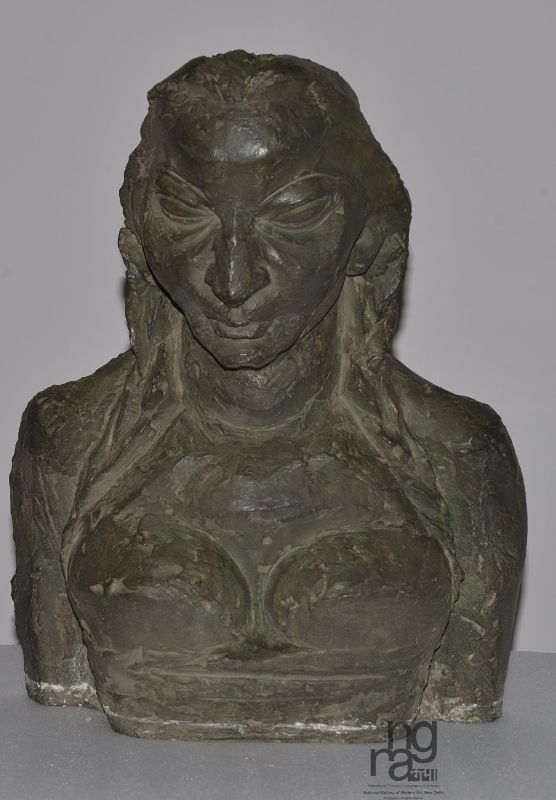 ×Ramkinker Baij√ʬ¬s sculptures as well as paintings have a expressionist tendency. For his sculptures he used local materials generously and worked with the technique of modelling and carving. His work are characterised by tremendous energy. This zeal of his is reflected in all his works, be it any medium. His sculptures reflect and abstraction in form, a distorted anatomy, but highlights the characteristics defining the form. This bust is the study showing the portrait of Priti Pandey.
×Ramkinker Baij√ʬ¬s sculptures as well as paintings have a expressionist tendency. For his sculptures he used local materials generously and worked with the technique of modelling and carving. His work are characterised by tremendous energy. This zeal of his is reflected in all his works, be it any medium. His sculptures reflect and abstraction in form, a distorted anatomy, but highlights the characteristics defining the form. This bust is the study showing the portrait of Priti Pandey. -
Portrait
 ×Ramkinker Baijís sculptures as well as paintings have a expressionist tendency. For his sculptures he used local materials generously and worked with the technique of modelling and carving. His work are characterised by tremendous energy. This zeal of his is reflected in all his works, be it any medium. His sculptures reflect and abstraction in form, a distorted anatomy, but highlights the characteristics defining the form, with a three dimensional quality given to it for the viewer to enjoy it from any given angle. This sculpture shows the study of the horse head by the artist.
×Ramkinker Baijís sculptures as well as paintings have a expressionist tendency. For his sculptures he used local materials generously and worked with the technique of modelling and carving. His work are characterised by tremendous energy. This zeal of his is reflected in all his works, be it any medium. His sculptures reflect and abstraction in form, a distorted anatomy, but highlights the characteristics defining the form, with a three dimensional quality given to it for the viewer to enjoy it from any given angle. This sculpture shows the study of the horse head by the artist. -
Portrait
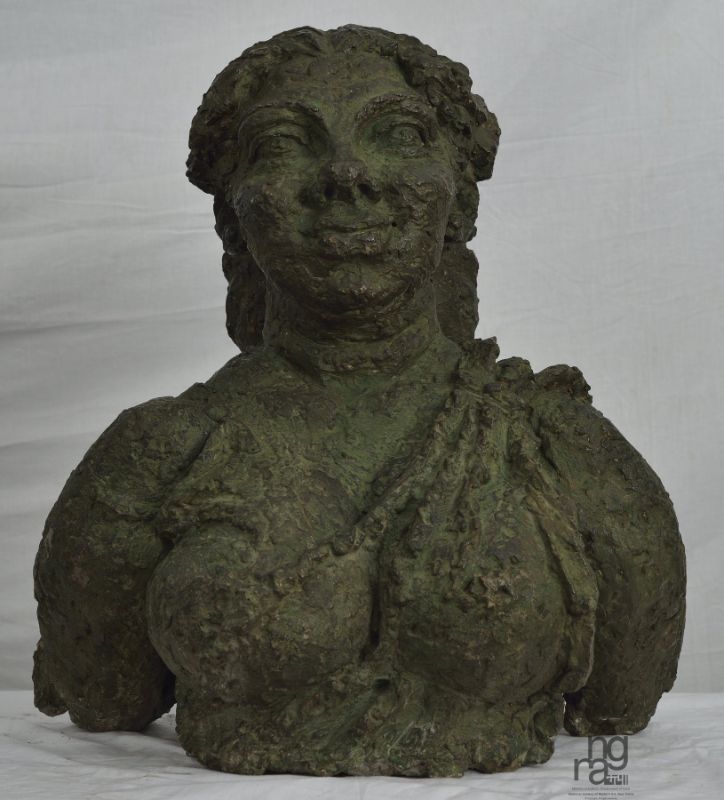 ×A cement bust in his signature style, depicting a Sri Lankan lady named Madhura Singha.
×A cement bust in his signature style, depicting a Sri Lankan lady named Madhura Singha. -
Portrait
 ×Ramkinker Baij's sculptures as well as paintings have a expressionist tendency. For his sculptures he used local materials generously and worked with the technique of modelling and carving. His work are characterised by tremendous energy. This zeal of his is reflected in all his works, be it any medium. He majorly worked in cement and concrete.† His studies of sculpture are interesting too, reflecting his techniques and zeal.
×Ramkinker Baij's sculptures as well as paintings have a expressionist tendency. For his sculptures he used local materials generously and worked with the technique of modelling and carving. His work are characterised by tremendous energy. This zeal of his is reflected in all his works, be it any medium. He majorly worked in cement and concrete.† His studies of sculpture are interesting too, reflecting his techniques and zeal. -
Portrait
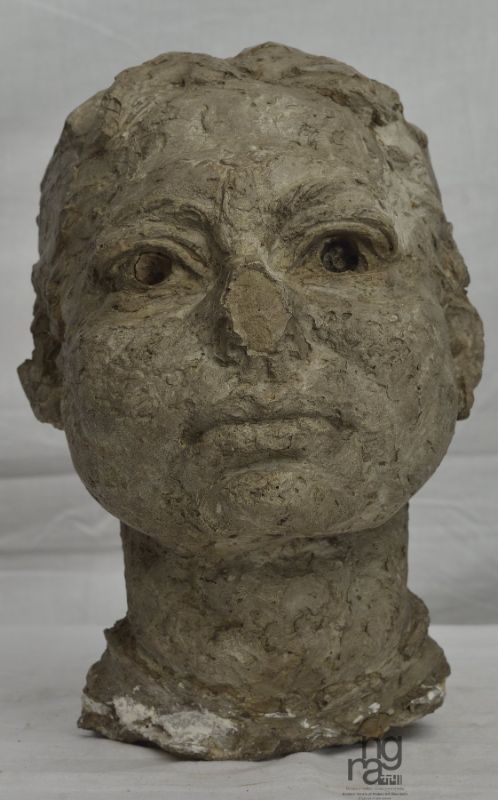 ×A cement bust in the signature style of the master. The bust depicts a woman named "Nilima Barua".
×A cement bust in the signature style of the master. The bust depicts a woman named "Nilima Barua". -
Portrait
 ×Ramkinker Baij's sculptures as well as paintings have a expressionist tendency. For his sculptures he used local materials generously and worked with the technique of modelling and carving. His work are characterised by tremendous energy. This zeal of his is reflected in all his works, be it any medium. †This sculptural bust, made in plaster shows the portrait of Mr. Gandhi.†
×Ramkinker Baij's sculptures as well as paintings have a expressionist tendency. For his sculptures he used local materials generously and worked with the technique of modelling and carving. His work are characterised by tremendous energy. This zeal of his is reflected in all his works, be it any medium. †This sculptural bust, made in plaster shows the portrait of Mr. Gandhi.† -
Portrait
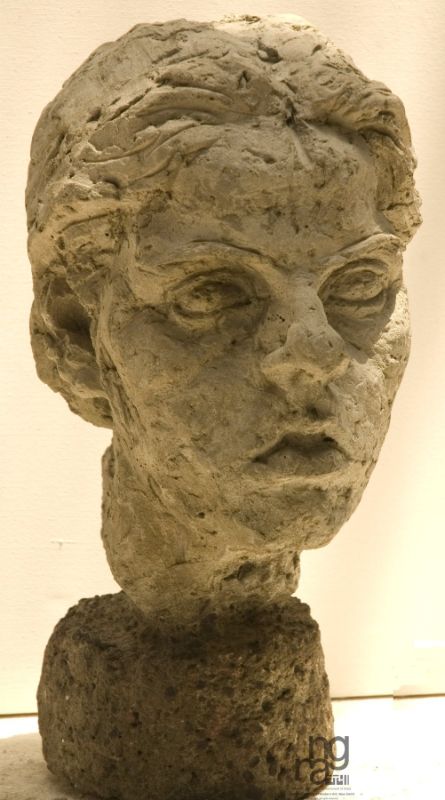 ×Ramkinker Baij as sculptures as well as paintings have a expressionist tendency. For his sculptures he used local materials generously and worked with the technique of modelling and carving. His work are characterised by tremendous energy. This zeal of his is reflected in all his works, be it any medium. His sculptures reflect and abstraction in form, a distorted anatomy, but highlights the characteristics defining the form. This sculpture the the portrait head study of Kiran Barua made in plaster.
×Ramkinker Baij as sculptures as well as paintings have a expressionist tendency. For his sculptures he used local materials generously and worked with the technique of modelling and carving. His work are characterised by tremendous energy. This zeal of his is reflected in all his works, be it any medium. His sculptures reflect and abstraction in form, a distorted anatomy, but highlights the characteristics defining the form. This sculpture the the portrait head study of Kiran Barua made in plaster. -
Portrait
 ×Ramkinker Baij as sculptures as well as paintings have a expressionist tendency. For his sculptures he used local materials generously and worked with the technique of modelling and carving. His work are characterised by tremendous energy. This zeal of his is reflected in all his works, be it any medium. His sculptures reflect and abstraction in form, a distorted anatomy, but highlights the characteristics defining the form. This sculpture is the portrait head study of Daniy Dalani.
×Ramkinker Baij as sculptures as well as paintings have a expressionist tendency. For his sculptures he used local materials generously and worked with the technique of modelling and carving. His work are characterised by tremendous energy. This zeal of his is reflected in all his works, be it any medium. His sculptures reflect and abstraction in form, a distorted anatomy, but highlights the characteristics defining the form. This sculpture is the portrait head study of Daniy Dalani. -
Portrait
 ×A cement bust of a lady named Rekha in his signature style. Her hair is fashioned into braids that fall behind.
×A cement bust of a lady named Rekha in his signature style. Her hair is fashioned into braids that fall behind. -
Portrait
 ×Ramkinker Baij's sculptures as well as paintings have a expressionist tendency. For his sculptures he used local materials generously and worked with the technique of modelling and carving. His work are characterised by tremendous energy. This zeal of his is reflected in all his works, be it any medium. His studies of sculpture are interesting too, reflecting his techniques and zeal. This bust sculpture is a study of a college girl.
×Ramkinker Baij's sculptures as well as paintings have a expressionist tendency. For his sculptures he used local materials generously and worked with the technique of modelling and carving. His work are characterised by tremendous energy. This zeal of his is reflected in all his works, be it any medium. His studies of sculpture are interesting too, reflecting his techniques and zeal. This bust sculpture is a study of a college girl. -
Portrait
 ×Ramkinkar Baij was a reclusive modernist artist who always remained on the fringes of the art market. He took a great interest in human figures, body language and in the general human drama. Modern Western art and pre and post-classical Indian art were his main points of reference. Although primarily known for his expressionistic sculpture, he was also a gifted painter. The sense of rhythm that his sculpture was noted for is manifested brilliantly in his paintings and sketches. His works in the Kalighat tradition interconnected with Cubism to achieve an unusual personal idiom. Both his sculpture and his paintings are unprompted and bold.
×Ramkinkar Baij was a reclusive modernist artist who always remained on the fringes of the art market. He took a great interest in human figures, body language and in the general human drama. Modern Western art and pre and post-classical Indian art were his main points of reference. Although primarily known for his expressionistic sculpture, he was also a gifted painter. The sense of rhythm that his sculpture was noted for is manifested brilliantly in his paintings and sketches. His works in the Kalighat tradition interconnected with Cubism to achieve an unusual personal idiom. Both his sculpture and his paintings are unprompted and bold.
-
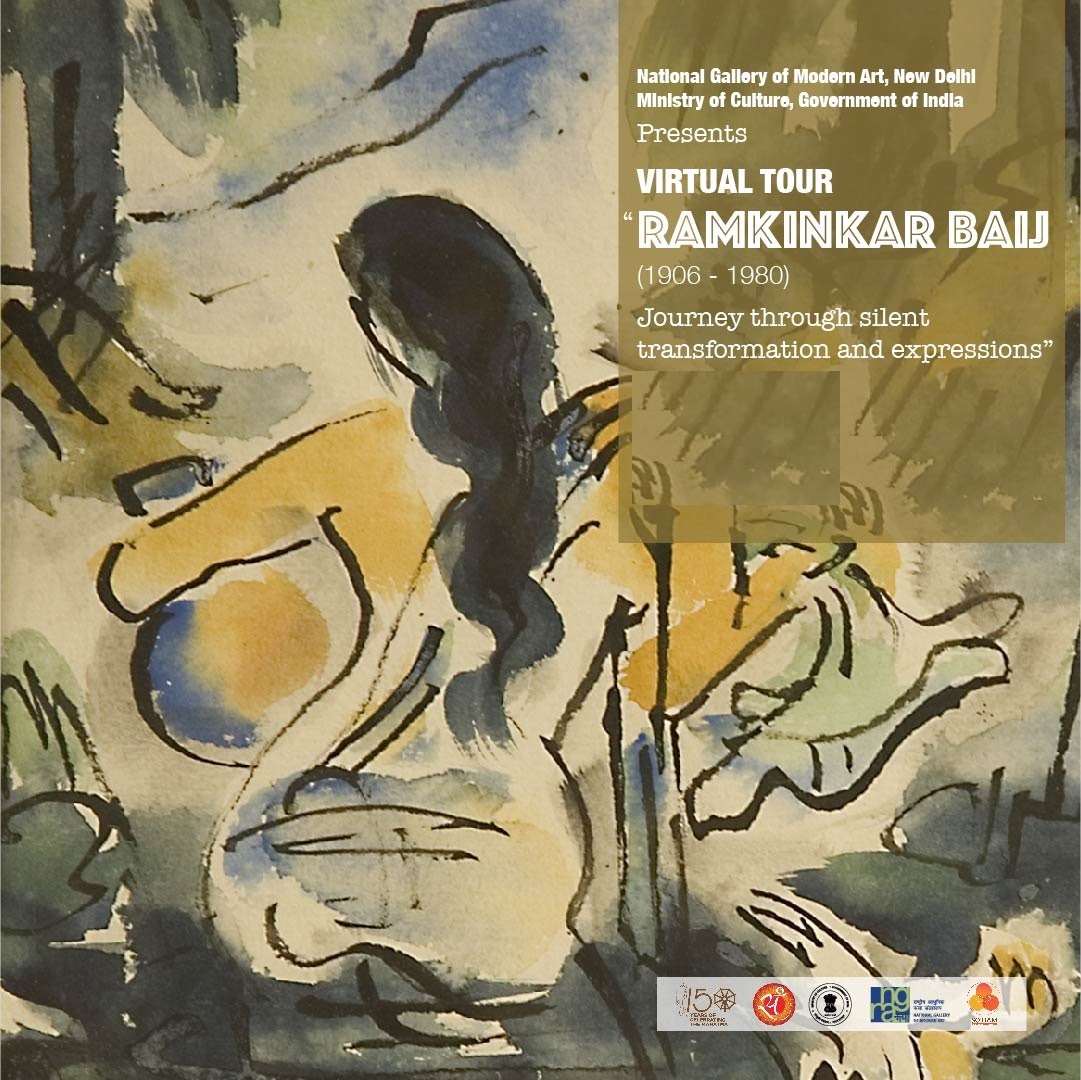 ××××
××××Concept Note
Virtual Tour
Ramkinkar Baij | Journey through silent transformation and expressions The Virtual Tour titled ďRamkinkar Baij | Journey through silent transformation and expressionsĒ is organized to commemorate the 115th Birth Anniversary of Ramkinkar Baij on 26th May 2020. Ramkinkar Baij, one of the most seminal artists of modern India, was an iconic sculptor, painter and graphic artist. In 1970, the Government of India honoured him with the Padma Bhushan for his irrefutable contribution to Indian art. Ramkinkar's monumental sculptures are established landmarks in public art. One of the earliest modernists in Indian art, he assimilated the idioms of the European modern visual language and yet was rooted in his own Indian ethos. He experimented restlessly with forms, moving freely from figurative to abstract and back to figurative, his themes were steeped in a deep sense of humanism and an instinctive understanding of the symbiotic relationship between man and nature. Both in his paintings and sculptures, he pushed the limits of experimentation and ventured into the use of new materials. For instance, his use of unconventional material, for the time, such as cement concrete for his monumental public sculptures set a new precedent for art practices. The NGMA takes pride in 639 works of art created by the iconic artist. This virtual tour presents the 520 works of art from the prominent artworks of Ramkinkar Baij from reserve collection of NGMA, grouped in a series of five different themes of (i) Portrait, (ii) Life Study, (iii) Abstract & Structural Composition, (iv) Nature Study & Landscape and (v) Sculptures. This virtual tour also showcases three sketch books from the collection of NGMA containing 182 works of art. I would urge our esteemed visitors to visit our web site to explore the complete works of art of Ramkinkar Baij through his silent transformation and expressions. I take pride of the tireless effort of our entire IT Cell to conceive and conceptualize the idea of launching Virtual Tours and designed and developed the same amidst lock down period to facilitate our esteemed visitors with the prestigious collection of NGMA. -
Life Study
 ×Ramkinkar Baij was immensely influenced by his austere surrounding, the ordinary people and the nature that became his subject matter for painting and sculpture. In this painting, he has depicted a man resting on womanís lap against a serene landscape, rendered with swift strokes of watercolour and fluid ink strokes delineating the contours of the figures.
×Ramkinkar Baij was immensely influenced by his austere surrounding, the ordinary people and the nature that became his subject matter for painting and sculpture. In this painting, he has depicted a man resting on womanís lap against a serene landscape, rendered with swift strokes of watercolour and fluid ink strokes delineating the contours of the figures. -
Life Study
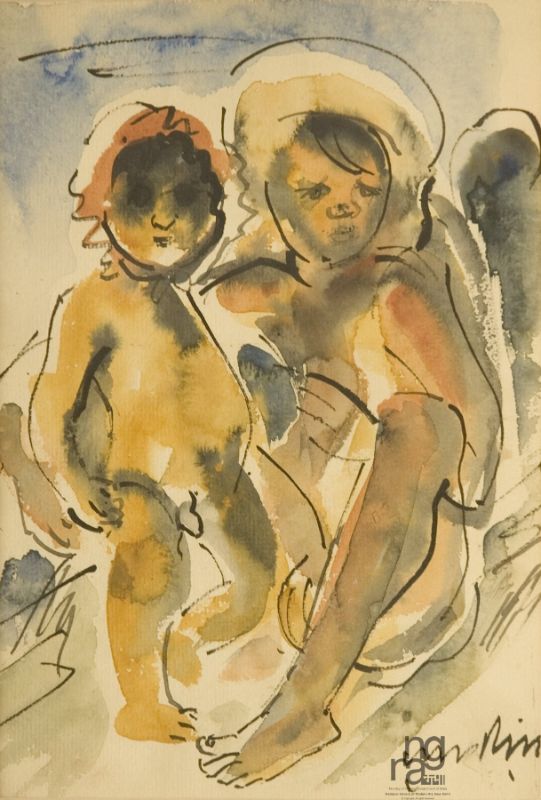 ×Ramkinkar Baij was immensely influenced by his austere surrounding, the ordinary people and the nature that became his subject matter for painting and sculpture. In this painting, he has depicted two children sitting together, rendered with swift strokes of watercolour in tonal variation and fluid strokes of ink defining the contours of the figures.
×Ramkinkar Baij was immensely influenced by his austere surrounding, the ordinary people and the nature that became his subject matter for painting and sculpture. In this painting, he has depicted two children sitting together, rendered with swift strokes of watercolour in tonal variation and fluid strokes of ink defining the contours of the figures. -
Life Study
 ×Ramkinkar Baijís artistic temperament was defined at Santiniketan an art institution known for providing an informed western modernistic environment to the students. Baij was immensely influenced by his austere surroundings, the ordinary people and nature that became the subject matter for painting and sculpture. In the above painting, the artist has depicted a group of bathers delineated with dabs and dashes of watercolour, outlined with black strokes. The treatment is intended to exemplify an energetic and lively artistic temperament.
×Ramkinkar Baijís artistic temperament was defined at Santiniketan an art institution known for providing an informed western modernistic environment to the students. Baij was immensely influenced by his austere surroundings, the ordinary people and nature that became the subject matter for painting and sculpture. In the above painting, the artist has depicted a group of bathers delineated with dabs and dashes of watercolour, outlined with black strokes. The treatment is intended to exemplify an energetic and lively artistic temperament. -
Life Study
 ×Ramkinkar Baij selected images for his sculptors and paintings from his rural surroundings. The poor and the downtrodden figured primarily as his subjects. Baij's watercolours mostly reflects his preoccupation with nature and the animal world. His work is characterized by tremendous energy, dynamism and the use of earthy colours. In the above painting, the artist has depicted a group of women carrying rice grass on their head in the foreground with dabs and dashes of watercolour in tonal variation delineating the form.
×Ramkinkar Baij selected images for his sculptors and paintings from his rural surroundings. The poor and the downtrodden figured primarily as his subjects. Baij's watercolours mostly reflects his preoccupation with nature and the animal world. His work is characterized by tremendous energy, dynamism and the use of earthy colours. In the above painting, the artist has depicted a group of women carrying rice grass on their head in the foreground with dabs and dashes of watercolour in tonal variation delineating the form. -
Life Study
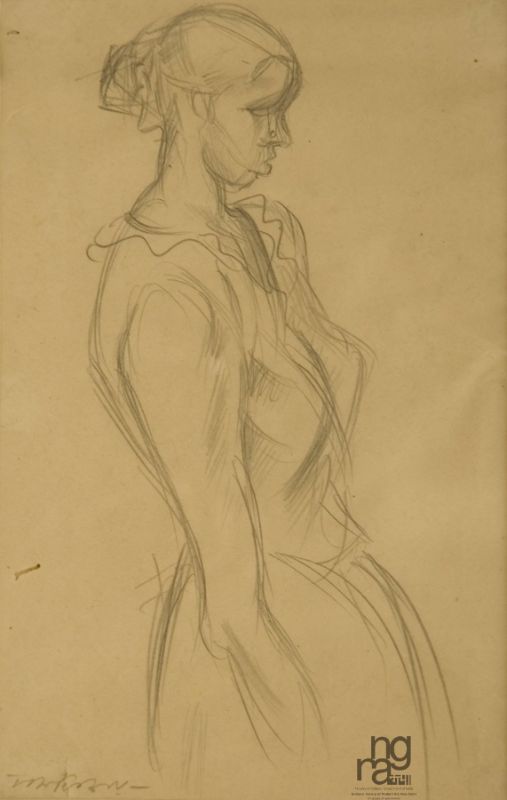 ×Ramkinkar Baij selected images for his sculptors and paintings from his rural surroundings. The poor and the downtrodden figured primarily as his subjects. His work is characterized by tremendous energy, dynamism and the use of earthy colours. In this sketch, the artist has depicted a pencil sketch of female figure an, rendered with fluid, fine lines of pencil delineating the form.
×Ramkinkar Baij selected images for his sculptors and paintings from his rural surroundings. The poor and the downtrodden figured primarily as his subjects. His work is characterized by tremendous energy, dynamism and the use of earthy colours. In this sketch, the artist has depicted a pencil sketch of female figure an, rendered with fluid, fine lines of pencil delineating the form. -
Life Study
 ×Ramkinkar Baij selected images for his sculptors and paintings from his rural surroundings. The poor and the downtrodden figured primarily as his subjects. Baij's watercolours mostly reflects his preoccupation with nature and the animal world. His work is characterized by tremendous energy, dynamism and the use of earthy colours. In the above painting, the artist has depicted a group of women resting in the foreground with dabs and dashes of watercolour in tonal variation delineating the form.
×Ramkinkar Baij selected images for his sculptors and paintings from his rural surroundings. The poor and the downtrodden figured primarily as his subjects. Baij's watercolours mostly reflects his preoccupation with nature and the animal world. His work is characterized by tremendous energy, dynamism and the use of earthy colours. In the above painting, the artist has depicted a group of women resting in the foreground with dabs and dashes of watercolour in tonal variation delineating the form. -
Life Study
 ×Ramkinkar Baijís artistic temperament was defined at Santiniketan, an art institution known for providing an informed western modernistic environment to the students. Baij was immensely influenced by his austere surroundings, the ordinary people and nature that became the subject matter for painting and sculpture. In this drawing, he has rendered a sketch of a baboon with the use of fluid, bold lines of pen and ink suggesting the basic form of the animal.
×Ramkinkar Baijís artistic temperament was defined at Santiniketan, an art institution known for providing an informed western modernistic environment to the students. Baij was immensely influenced by his austere surroundings, the ordinary people and nature that became the subject matter for painting and sculpture. In this drawing, he has rendered a sketch of a baboon with the use of fluid, bold lines of pen and ink suggesting the basic form of the animal. -
Life Study
 ×Ramkinkar Baij selected images for his sculptors and paintings from his rural surroundings. The poor and the downtrodden figured primarily as his subjects. Baij's watercolours mostly reflects his preoccupation with nature and the animal world. His work is characterized by tremendous energy, dynamism and the use of earthy colours. In the above painting, the artist has depicted a group of road builder with dabs and dashes of watercolour in tonal variation delineating the form.
×Ramkinkar Baij selected images for his sculptors and paintings from his rural surroundings. The poor and the downtrodden figured primarily as his subjects. Baij's watercolours mostly reflects his preoccupation with nature and the animal world. His work is characterized by tremendous energy, dynamism and the use of earthy colours. In the above painting, the artist has depicted a group of road builder with dabs and dashes of watercolour in tonal variation delineating the form. -
Life Study
 ×Ramkinkar Baij selected images for his sculptors and paintings from his rural surroundings. The poor and the downtrodden figured primarily as his subjects. Baij's watercolours mostly reflects his preoccupation with nature and the animal world. His work is characterized by tremendous energy, dynamism and the use of earthy colours. In the above painting, the artist has depicted a horse drawn carriage with dabs and dashes of watercolour in tonal variation delineating the form.
×Ramkinkar Baij selected images for his sculptors and paintings from his rural surroundings. The poor and the downtrodden figured primarily as his subjects. Baij's watercolours mostly reflects his preoccupation with nature and the animal world. His work is characterized by tremendous energy, dynamism and the use of earthy colours. In the above painting, the artist has depicted a horse drawn carriage with dabs and dashes of watercolour in tonal variation delineating the form. -
Life Study
 ×Ramkinkar Baij selected images for his sculptors and paintings from his rural surroundings. The poor and the downtrodden figured primarily as his subjects. His work is characterized by tremendous energy, dynamism and the use of earthy colours. In this sketch, the artist has depicted a taxi stand, rendered with fluid, fine lines of pen and ink delineating the form.
×Ramkinkar Baij selected images for his sculptors and paintings from his rural surroundings. The poor and the downtrodden figured primarily as his subjects. His work is characterized by tremendous energy, dynamism and the use of earthy colours. In this sketch, the artist has depicted a taxi stand, rendered with fluid, fine lines of pen and ink delineating the form. -
Life Study

Vivian Acc. No. 2822 | Watercolour on paper
-
Life Study
 ×Ramkinkar Baij selected images for his sculptors and paintings from his rural surroundings. The poor and the downtrodden figured primarily as his subjects. Baij's watercolours mostly reflects his preoccupation with nature and the animal world. His work is characterized by tremendous energy, dynamism and the use of earthy colours. In the above painting, the artist has depicted a sketch of Binodini with dabs and dashes of watercolour in tonal variation delineating the form. Binodini was one of the frequent images in Baij's works with gracious presence.
×Ramkinkar Baij selected images for his sculptors and paintings from his rural surroundings. The poor and the downtrodden figured primarily as his subjects. Baij's watercolours mostly reflects his preoccupation with nature and the animal world. His work is characterized by tremendous energy, dynamism and the use of earthy colours. In the above painting, the artist has depicted a sketch of Binodini with dabs and dashes of watercolour in tonal variation delineating the form. Binodini was one of the frequent images in Baij's works with gracious presence. -
Life Study
 ×Ramkinkar Baij selected images for his sculptors and paintings from his rural surroundings. The poor and the downtrodden figured primarily as his subjects. Baij's watercolours mostly reflects his preoccupation with nature and the animal world. His work is characterized by tremendous energy, dynamism and the use of earthy colours. In the above painting, the artist has depicted a sketch of Bina with dabs and dashes of watercolour in tonal variation delineating the form. Binodini was one of the frequent images in Baij's works with gracious presence.
×Ramkinkar Baij selected images for his sculptors and paintings from his rural surroundings. The poor and the downtrodden figured primarily as his subjects. Baij's watercolours mostly reflects his preoccupation with nature and the animal world. His work is characterized by tremendous energy, dynamism and the use of earthy colours. In the above painting, the artist has depicted a sketch of Bina with dabs and dashes of watercolour in tonal variation delineating the form. Binodini was one of the frequent images in Baij's works with gracious presence. -
Life Study
 ×Ramkinkar Baij selected images for his sculptors and paintings from his rural surroundings. The poor and the downtrodden figured primarily as his subjects. Baij's watercolours mostly reflects his preoccupation with nature and the animal world. His work is characterized by tremendous energy, dynamism and the use of earthy colours. In the above painting, the artist has depicted a group of people sitting by the fire inside a hut inside a hut with dabs and dashes of watercolour in tonal variation delineating the form.
×Ramkinkar Baij selected images for his sculptors and paintings from his rural surroundings. The poor and the downtrodden figured primarily as his subjects. Baij's watercolours mostly reflects his preoccupation with nature and the animal world. His work is characterized by tremendous energy, dynamism and the use of earthy colours. In the above painting, the artist has depicted a group of people sitting by the fire inside a hut inside a hut with dabs and dashes of watercolour in tonal variation delineating the form. -
Life Study
 ×Ramkinkar Baij selected images for his sculptors and paintings from his rural surroundings. The poor and the downtrodden figured primarily as his subjects. Baij's watercolours mostly reflects his preoccupation with nature and the animal world. His work is characterized by tremendous energy, dynamism and the use of earthy colours. In the above painting, the artist has depicted a Shepherd on the way to the pond with dabs and dashes of watercolour in tonal variation delineating the form.
×Ramkinkar Baij selected images for his sculptors and paintings from his rural surroundings. The poor and the downtrodden figured primarily as his subjects. Baij's watercolours mostly reflects his preoccupation with nature and the animal world. His work is characterized by tremendous energy, dynamism and the use of earthy colours. In the above painting, the artist has depicted a Shepherd on the way to the pond with dabs and dashes of watercolour in tonal variation delineating the form. -
Life Study
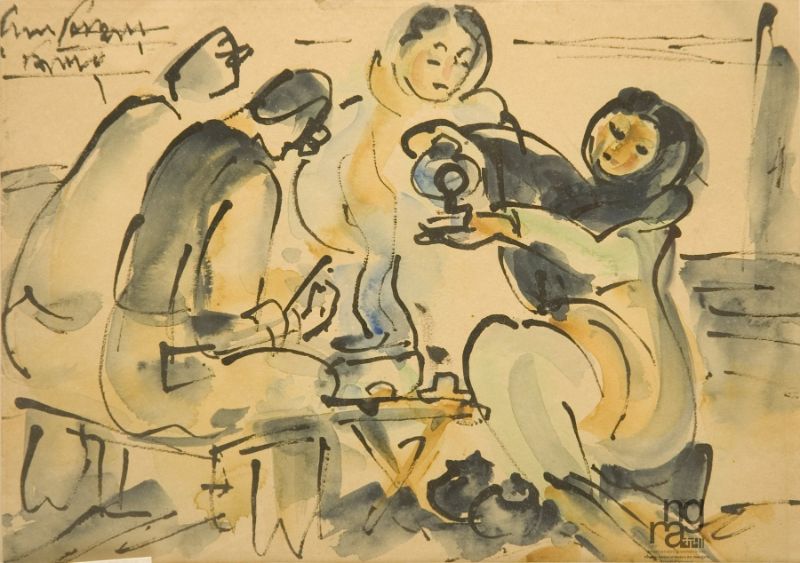 ×Ramkinkar Baij selected images for his sculptors and paintings from his rural surroundings. The poor and the downtrodden figured primarily as his subjects. Baij's watercolours mostly reflects his preoccupation with nature and the animal world. His work is characterized by tremendous energy, dynamism and the use of earthy colours. In the above painting, the artist has depicted a group of people sitting at the tea shop with dabs and dashes of watercolour in tonal variation delineating the form.
×Ramkinkar Baij selected images for his sculptors and paintings from his rural surroundings. The poor and the downtrodden figured primarily as his subjects. Baij's watercolours mostly reflects his preoccupation with nature and the animal world. His work is characterized by tremendous energy, dynamism and the use of earthy colours. In the above painting, the artist has depicted a group of people sitting at the tea shop with dabs and dashes of watercolour in tonal variation delineating the form. -
Life Study
 ×Ramkinkar Baijís artistic temperament was defined at Santiniketan an art institution known for providing an informed western modernistic environment to the students. Baij was immensely influenced by his austere surroundings, the ordinary people and nature that became the subject matter for painting and sculpture. In the above sketch, the artist has delineated a female figure with linear, fine pencil strokes. The treatment is intended to exemplify an energetic and lively artistic temperament.
×Ramkinkar Baijís artistic temperament was defined at Santiniketan an art institution known for providing an informed western modernistic environment to the students. Baij was immensely influenced by his austere surroundings, the ordinary people and nature that became the subject matter for painting and sculpture. In the above sketch, the artist has delineated a female figure with linear, fine pencil strokes. The treatment is intended to exemplify an energetic and lively artistic temperament. -
Life Study
 ×Ramkinkar Baij selected images for his sculptors and paintings from his rural surroundings. The poor and the downtrodden figured primarily as his subjects. Baij's watercolours mostly reflects his preoccupation with nature and the animal world. His work is characterized by tremendous energy, dynamism and the use of earthy colours. In the above painting, the artist has depicted a Shepherd with dabs and dashes of watercolour in tonal variation delineating the form.
×Ramkinkar Baij selected images for his sculptors and paintings from his rural surroundings. The poor and the downtrodden figured primarily as his subjects. Baij's watercolours mostly reflects his preoccupation with nature and the animal world. His work is characterized by tremendous energy, dynamism and the use of earthy colours. In the above painting, the artist has depicted a Shepherd with dabs and dashes of watercolour in tonal variation delineating the form. -
Life Study
 ×Ramkinkar Baijís artistic temperament was defined at Santiniketan an art institution known for providing an informed western modernistic environment to the students. Baij was immensely influenced by his austere surroundings, the ordinary people and nature that became the subject matter for painting and sculpture. In the above painting, the artist has depicted a woman riding a buffalo, delineated with dabs and dashes of watercolour, outlined with black brush strokes. The treatment is intended to exemplify an energetic and lively artistic temperament.
×Ramkinkar Baijís artistic temperament was defined at Santiniketan an art institution known for providing an informed western modernistic environment to the students. Baij was immensely influenced by his austere surroundings, the ordinary people and nature that became the subject matter for painting and sculpture. In the above painting, the artist has depicted a woman riding a buffalo, delineated with dabs and dashes of watercolour, outlined with black brush strokes. The treatment is intended to exemplify an energetic and lively artistic temperament. -
Life Study
 ×Ramkinkar Baij was immensely influenced by his austere surrounding, the ordinary people and the nature that became his subject matter for painting and sculpture. In this painting, he has depicted three women filling up the pitcher from lotus pond, rendered with swift strokes of watercolour in tonal variation and fluid, bold strokes of ink delineating the figures.
×Ramkinkar Baij was immensely influenced by his austere surrounding, the ordinary people and the nature that became his subject matter for painting and sculpture. In this painting, he has depicted three women filling up the pitcher from lotus pond, rendered with swift strokes of watercolour in tonal variation and fluid, bold strokes of ink delineating the figures. -
Life Study
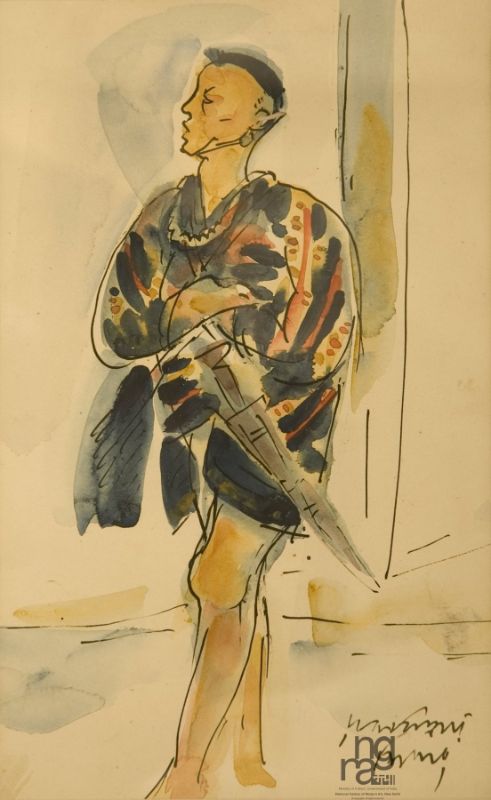 ×Ramkinkar Baij was immensely influenced by his austere surrounding, the ordinary people and the nature that became his subject matter for painting and sculpture. In this painting, he has depicted a man in Assamese tribal costume, rendered in swift strokes of watercolour in tonal variation and fluid, bold strokes of ink defining the contours of the figure.
×Ramkinkar Baij was immensely influenced by his austere surrounding, the ordinary people and the nature that became his subject matter for painting and sculpture. In this painting, he has depicted a man in Assamese tribal costume, rendered in swift strokes of watercolour in tonal variation and fluid, bold strokes of ink defining the contours of the figure. -
Life Study
 ×Ramkinkar Baijís artistic temperament was defined at Santiniketan, an art institution known for providing an informed western modernistic environment to the students. His work is characterised by tremendous energy, dynamism and the use of earthy colours. In the above print, the artist has depicted an abstract geometric composition. The treatment is intended to exemplify an energetic and lively artistic temperament.
×Ramkinkar Baijís artistic temperament was defined at Santiniketan, an art institution known for providing an informed western modernistic environment to the students. His work is characterised by tremendous energy, dynamism and the use of earthy colours. In the above print, the artist has depicted an abstract geometric composition. The treatment is intended to exemplify an energetic and lively artistic temperament. -
Life Study
 ×Nandalal preferred drawing from life, often sketching outdoors with the subject being life, nature studies, landscapes, figure drawings and animals. He also experimented with printmaking in his long artistic career. In the above print the artist has depicted a family where the mother is playing with her child. The illustration is rendered with bold, firm yet fluid strokes engraved on the etching plate and transferred on the plain surface, articulating the contours of the figures.
×Nandalal preferred drawing from life, often sketching outdoors with the subject being life, nature studies, landscapes, figure drawings and animals. He also experimented with printmaking in his long artistic career. In the above print the artist has depicted a family where the mother is playing with her child. The illustration is rendered with bold, firm yet fluid strokes engraved on the etching plate and transferred on the plain surface, articulating the contours of the figures. -
Life Study
 ×Ramkinkar Baijís artistic temperament was defined at Santiniketan an art institution known for providing an informed western modernistic environment to the students. Baij was immensely influenced by his austere surroundings, the ordinary people and nature that became the subject matter for painting and sculpture. In the above painting, the artist has depicted a woman walking with a pitcher delineated with dabs and dashes of watercolour, articulating the elegant posture. The treatment is intended to exemplify an energetic and lively artistic temperament.
×Ramkinkar Baijís artistic temperament was defined at Santiniketan an art institution known for providing an informed western modernistic environment to the students. Baij was immensely influenced by his austere surroundings, the ordinary people and nature that became the subject matter for painting and sculpture. In the above painting, the artist has depicted a woman walking with a pitcher delineated with dabs and dashes of watercolour, articulating the elegant posture. The treatment is intended to exemplify an energetic and lively artistic temperament. -
Life Study
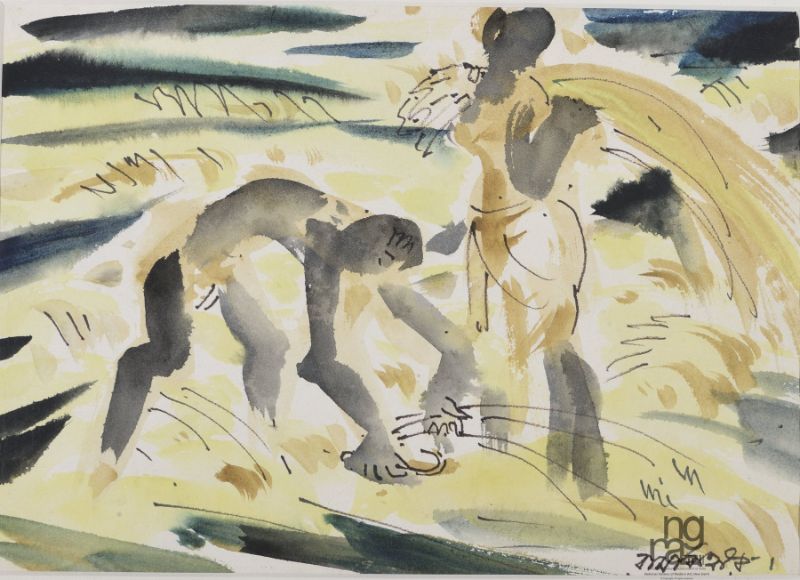 ×Ramkinkar Baij selected images for his sculptures and paintings from his rural surroundings. The poor and the downtrodden figured primarily as his subjects. Baij's watercolours mostly reflect his preoccupation with nature and the animal world. His work is characterized by tremendous energy, dynamism and the use of earthy colours. In the above painting, the artist has depicted a man and a woman harvesting crops in the field with dabs and dashes of watercolour in tonal variation delineating the form.
×Ramkinkar Baij selected images for his sculptures and paintings from his rural surroundings. The poor and the downtrodden figured primarily as his subjects. Baij's watercolours mostly reflect his preoccupation with nature and the animal world. His work is characterized by tremendous energy, dynamism and the use of earthy colours. In the above painting, the artist has depicted a man and a woman harvesting crops in the field with dabs and dashes of watercolour in tonal variation delineating the form. -
Life Study
 ×Ramkinkar Baij selected images for his sculptures and paintings from his rural surroundings. The poor and the downtrodden figured primarily as his subjects. Baij's watercolours mostly reflect his preoccupation with nature and the animal world. His work is characterised by tremendous energy, dynamism and the use of earthy colours. In the above painting, the artist has depicted a buffalo grazing in the field, rendered with dabs and dashes of watercolour in tonal variations, delineating the form.
×Ramkinkar Baij selected images for his sculptures and paintings from his rural surroundings. The poor and the downtrodden figured primarily as his subjects. Baij's watercolours mostly reflect his preoccupation with nature and the animal world. His work is characterised by tremendous energy, dynamism and the use of earthy colours. In the above painting, the artist has depicted a buffalo grazing in the field, rendered with dabs and dashes of watercolour in tonal variations, delineating the form. -
Life Study
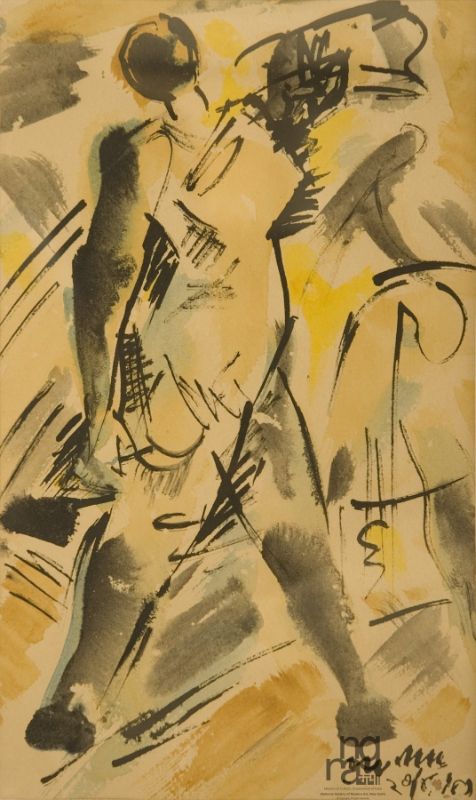 ×Ramkinkar Baij was immensely influenced by his austere surrounding, the ordinary people and the nature that became his subject matter for painting and sculpture. In this†painting, he has depicted a man harvesting crops in the field, rendered with swift strokes of watercolour in tonal variation and fluid, bold strokes of ink defining the contours of the figure.
×Ramkinkar Baij was immensely influenced by his austere surrounding, the ordinary people and the nature that became his subject matter for painting and sculpture. In this†painting, he has depicted a man harvesting crops in the field, rendered with swift strokes of watercolour in tonal variation and fluid, bold strokes of ink defining the contours of the figure. -
Life Study
 ×Ramkinkar Baij was immensely influenced by his austere surrounding, the ordinary people and the nature that became his subject matter for painting and sculpture. †In this panting, he has depicted a family going towards the market, rendered with swift, fluid brush strokes of watercolour in tonal variation and fine, bold strokes of ink defining the contours the figures.
×Ramkinkar Baij was immensely influenced by his austere surrounding, the ordinary people and the nature that became his subject matter for painting and sculpture. †In this panting, he has depicted a family going towards the market, rendered with swift, fluid brush strokes of watercolour in tonal variation and fine, bold strokes of ink defining the contours the figures. -
Life Study
 ×Ramkinkar Baij was immensely influenced by his austere surrounding, the ordinary people†and the nature that became his subject matter for painting and sculpture. In this panting, he has depicted a woman in saree with dabs and dashes of watercolour in tonal variation and fluid, bold strokes of ink defining the contours of her figure.
×Ramkinkar Baij was immensely influenced by his austere surrounding, the ordinary people†and the nature that became his subject matter for painting and sculpture. In this panting, he has depicted a woman in saree with dabs and dashes of watercolour in tonal variation and fluid, bold strokes of ink defining the contours of her figure. -
Life Study
 ×Ramkinkar Baij was immensely influenced by his austere surrounding, the ordinary people and the nature that became his subject matter for painting and sculpture. †In this panting, he has depicted a female figure with dabs and dashes of watercolour merging together with fluid, soft strokes of ink defining contours of her figure.
×Ramkinkar Baij was immensely influenced by his austere surrounding, the ordinary people and the nature that became his subject matter for painting and sculpture. †In this panting, he has depicted a female figure with dabs and dashes of watercolour merging together with fluid, soft strokes of ink defining contours of her figure. -
Life Study
 ×Ramkinkar Baij selected images for his sculptures and paintings from his rural surroundings. The poor and the downtrodden figured primarily as his subjects. Baij's watercolours mostly reflect his preoccupation with nature and the animal world. His work is characterized by tremendous energy, dynamism and the use of earthy colours. In the above painting, the artist has depicted a woman from behind siting holding a pitcher with dabs and dashes of watercolour in tonal variation delineating the form.
×Ramkinkar Baij selected images for his sculptures and paintings from his rural surroundings. The poor and the downtrodden figured primarily as his subjects. Baij's watercolours mostly reflect his preoccupation with nature and the animal world. His work is characterized by tremendous energy, dynamism and the use of earthy colours. In the above painting, the artist has depicted a woman from behind siting holding a pitcher with dabs and dashes of watercolour in tonal variation delineating the form. -
Life Study
 ×Ramkinkar Baij selected images for his sculptures and paintings from his rural surroundings. The poor and the downtrodden figured primarily as his subjects. Baij's watercolours mostly reflect his preoccupation with nature and the animal world. His work is characterised by tremendous energy, dynamism and the use of earthy colours. In the above painting, the artist has studied the form of a horse, rendered with dabs and dashes of watercolour in tonal variations.
×Ramkinkar Baij selected images for his sculptures and paintings from his rural surroundings. The poor and the downtrodden figured primarily as his subjects. Baij's watercolours mostly reflect his preoccupation with nature and the animal world. His work is characterised by tremendous energy, dynamism and the use of earthy colours. In the above painting, the artist has studied the form of a horse, rendered with dabs and dashes of watercolour in tonal variations. -
Life Study
 ×Ramkinkar's work is characterised by tremendous energy, dynamism and the use of earthy colours. In the above sketch, the artist has quickly studied a sculpture of the goddess Durga also know as Mahishasur Mardini, as carved in the caves of Ellora. The composition is rendered with fine, bold ink strokes, delineating the figure of the goddess slaying the demon.
×Ramkinkar's work is characterised by tremendous energy, dynamism and the use of earthy colours. In the above sketch, the artist has quickly studied a sculpture of the goddess Durga also know as Mahishasur Mardini, as carved in the caves of Ellora. The composition is rendered with fine, bold ink strokes, delineating the figure of the goddess slaying the demon. -
Life Study
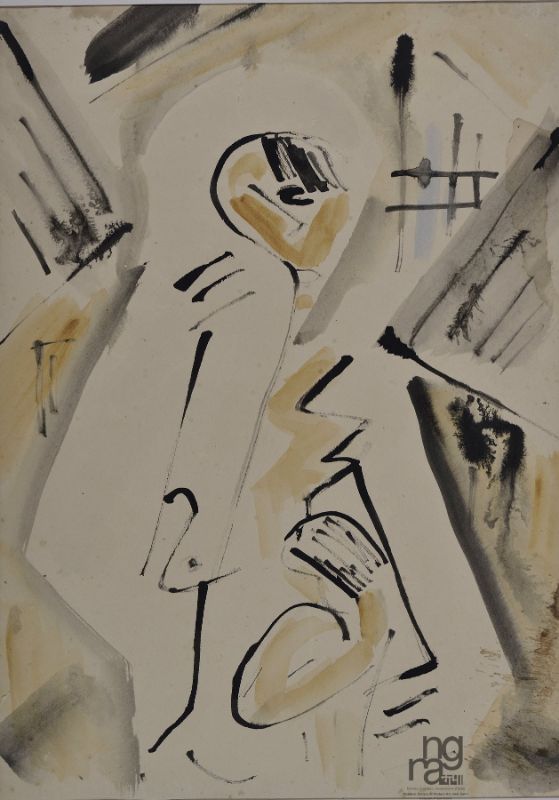 ×Ramkinkar Baij selected images for his sculptures and paintings from his rural surroundings. The poor and the downtrodden figured primarily as his subjects. His work is characterised by tremendous energy, dynamism and the use of earthy colours. In the above painting, the artist has depicted an abstracted human figure, rendered with fluid, fine brush strokes delineating the form.
×Ramkinkar Baij selected images for his sculptures and paintings from his rural surroundings. The poor and the downtrodden figured primarily as his subjects. His work is characterised by tremendous energy, dynamism and the use of earthy colours. In the above painting, the artist has depicted an abstracted human figure, rendered with fluid, fine brush strokes delineating the form. -
Life Study
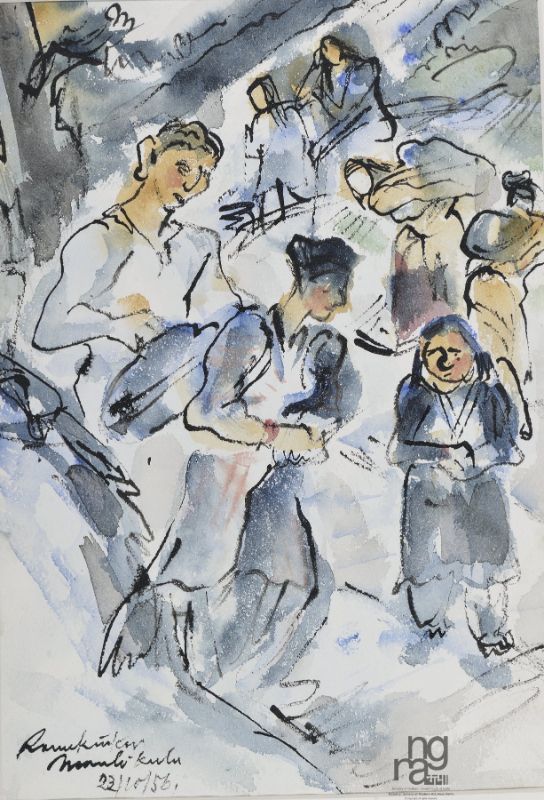 ×Ramkinker's sketches, much like the quality of his sculptures are earthy and dynamic. They reflect a keen observer's eye through the quick but a detailed observations in them. This sketch in watercolours depict a village of Mandi, Kulu.
×Ramkinker's sketches, much like the quality of his sculptures are earthy and dynamic. They reflect a keen observer's eye through the quick but a detailed observations in them. This sketch in watercolours depict a village of Mandi, Kulu. -
Life Study
 ×Ramkinkar Baij selected images for his sculptures and paintings from his rural surroundings. The poor and the downtrodden figured primarily as his subjects. Baij's watercolours mostly reflect his preoccupation with nature and the animal world. His work is characterized by tremendous energy, dynamism and the use of earthy colours. In the above painting, the artist has depicted two buffaloes with dabs and dashes of watercolour in tonal variation delineating the form.
×Ramkinkar Baij selected images for his sculptures and paintings from his rural surroundings. The poor and the downtrodden figured primarily as his subjects. Baij's watercolours mostly reflect his preoccupation with nature and the animal world. His work is characterized by tremendous energy, dynamism and the use of earthy colours. In the above painting, the artist has depicted two buffaloes with dabs and dashes of watercolour in tonal variation delineating the form. -
Life Study
 ×Ramkinkar Baij selected images for his sculptures and paintings from his rural surroundings. The poor and the downtrodden figured primarily as his subjects. Baij's watercolours mostly reflect his preoccupation with nature and the animal world. His work is characterised by tremendous energy, dynamism and the use of earthy colours. In the above painting, the artist has studied a pair of horses, rendered with dabs and dashes of watercolour in tonal variations.
×Ramkinkar Baij selected images for his sculptures and paintings from his rural surroundings. The poor and the downtrodden figured primarily as his subjects. Baij's watercolours mostly reflect his preoccupation with nature and the animal world. His work is characterised by tremendous energy, dynamism and the use of earthy colours. In the above painting, the artist has studied a pair of horses, rendered with dabs and dashes of watercolour in tonal variations. -
Life Study
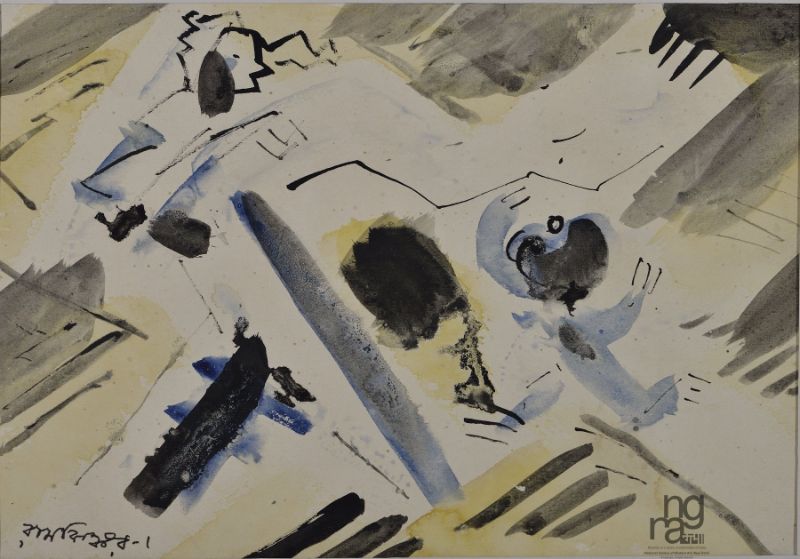 ×Ramkinkar Baij selected images for his sculptures and paintings from his rural surroundings. The poor and the downtrodden figured primarily as his subjects. His work is characterised by tremendous energy, dynamism and the use of earthy colours. In the above painting, the artist has depicted the abstracted human form of a harvester in a field, rendered with fluid, fine brush strokes delineating the form.
×Ramkinkar Baij selected images for his sculptures and paintings from his rural surroundings. The poor and the downtrodden figured primarily as his subjects. His work is characterised by tremendous energy, dynamism and the use of earthy colours. In the above painting, the artist has depicted the abstracted human form of a harvester in a field, rendered with fluid, fine brush strokes delineating the form. -
Life Study
 ×Ramkinkar deep felt love and oneness with nature could be seen in his vigorously painted and sculpted images of animals and birds seen around him. In this sketch, he has depicted an elephant with fluid strokes of ink delineating the contours of his body. The dabs and dashes of watercolour in tonal variation adds grace to the figure.
×Ramkinkar deep felt love and oneness with nature could be seen in his vigorously painted and sculpted images of animals and birds seen around him. In this sketch, he has depicted an elephant with fluid strokes of ink delineating the contours of his body. The dabs and dashes of watercolour in tonal variation adds grace to the figure. -
Life Study
 ×Ramkinkar's deep felt love and oneness with nature could be seen in his vigorously painted and sculpted images of the animals, birds, flora and fauna in his surroundings. In this sketch, he has studied the form of a horse in quick, sharp strokes of the pen.
×Ramkinkar's deep felt love and oneness with nature could be seen in his vigorously painted and sculpted images of the animals, birds, flora and fauna in his surroundings. In this sketch, he has studied the form of a horse in quick, sharp strokes of the pen. -
Life Study
 ×Ramkinkar Baij was immensely influenced by his austere surrounding, the ordinary people and the nature that it became its subject matter for painting and sculpture. In this painting, he has depicted a woman filling up her pitcher from a river, rendered with swift, fluid strokes of watercolours merging together in tonal variation delineating the form and figure of a woman.
×Ramkinkar Baij was immensely influenced by his austere surrounding, the ordinary people and the nature that it became its subject matter for painting and sculpture. In this painting, he has depicted a woman filling up her pitcher from a river, rendered with swift, fluid strokes of watercolours merging together in tonal variation delineating the form and figure of a woman. -
Life Study
 ×Ramkinkar Baij selected images for his sculptures and paintings from his rural surroundings. The poor and the downtrodden figured primarily as his subjects. Baij's watercolours mostly reflect his preoccupation with nature and the animal world. His work is characterised by tremendous energy, dynamism and the use of earthy colours. In the above painting, the artist has depicted horses grazing in the field, rendered with dabs and dashes of watercolour in tonal variations. The quick rendition was intended as a study of the animal form.
×Ramkinkar Baij selected images for his sculptures and paintings from his rural surroundings. The poor and the downtrodden figured primarily as his subjects. Baij's watercolours mostly reflect his preoccupation with nature and the animal world. His work is characterised by tremendous energy, dynamism and the use of earthy colours. In the above painting, the artist has depicted horses grazing in the field, rendered with dabs and dashes of watercolour in tonal variations. The quick rendition was intended as a study of the animal form. -
Life Study
 ×Ramkinkar Baij selected images for his sculptures and paintings from his rural surroundings. The poor and the downtrodden figured primarily as his subjects. Baij's watercolours mostly reflect his preoccupation with nature and the animal world. His work is characterised by tremendous energy, dynamism and the use of earthy colours. In the above sketch, the artist has studied the stance of Lord Shiva dancing, as carved in the caves of Ellora. The composition is rendered with fine, bold ink strokes, delineating lord Shiva's dancing posture.
×Ramkinkar Baij selected images for his sculptures and paintings from his rural surroundings. The poor and the downtrodden figured primarily as his subjects. Baij's watercolours mostly reflect his preoccupation with nature and the animal world. His work is characterised by tremendous energy, dynamism and the use of earthy colours. In the above sketch, the artist has studied the stance of Lord Shiva dancing, as carved in the caves of Ellora. The composition is rendered with fine, bold ink strokes, delineating lord Shiva's dancing posture. -
Life Study
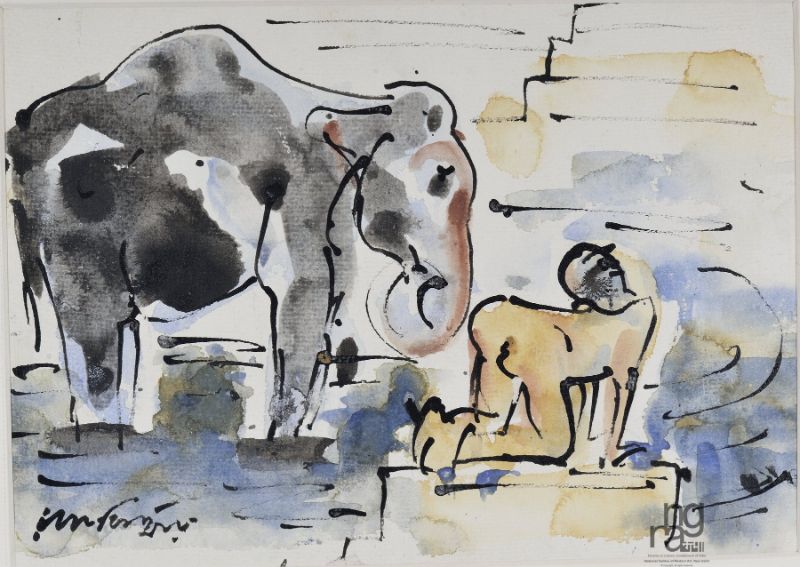 ×Ramkinkar Baij was immensely influenced by his austere surrounding, the ordinary people†and the nature that it became its subject matter for painting and sculpture. In this painting, he has depicted an elephant and a human figure, rendered with swift, fluid strokes of watercolours†merging together in tonal variation and bold strokes of ink delineating the basic form of an animal.
×Ramkinkar Baij was immensely influenced by his austere surrounding, the ordinary people†and the nature that it became its subject matter for painting and sculpture. In this painting, he has depicted an elephant and a human figure, rendered with swift, fluid strokes of watercolours†merging together in tonal variation and bold strokes of ink delineating the basic form of an animal. -
Life Study
 ×Ramkinkar Baij was immensely influenced by his austere surrounding, the ordinary people and the nature that it became its subject matter for painting and sculpture. In this painting, he has depicted a Baboon, rendered with swift, fluid strokes of watercolours merging together in tonal variation and bold strokes of ink delineating the basic form of the animal.
×Ramkinkar Baij was immensely influenced by his austere surrounding, the ordinary people and the nature that it became its subject matter for painting and sculpture. In this painting, he has depicted a Baboon, rendered with swift, fluid strokes of watercolours merging together in tonal variation and bold strokes of ink delineating the basic form of the animal. -
Life Study
 ×Ramkinkar Baij selected images for his sculptures and paintings from his rural surroundings. The poor and the downtrodden figured primarily as his subjects. Baij's watercolours mostly reflect his preoccupation with nature and the animal world. His work is characterised by tremendous energy, dynamism and the use of earthy colours. In the above painting, the artist has studied the form of a horse, rendered with dabs and dashes of watercolour in tonal variations.
×Ramkinkar Baij selected images for his sculptures and paintings from his rural surroundings. The poor and the downtrodden figured primarily as his subjects. Baij's watercolours mostly reflect his preoccupation with nature and the animal world. His work is characterised by tremendous energy, dynamism and the use of earthy colours. In the above painting, the artist has studied the form of a horse, rendered with dabs and dashes of watercolour in tonal variations. -
Life Study
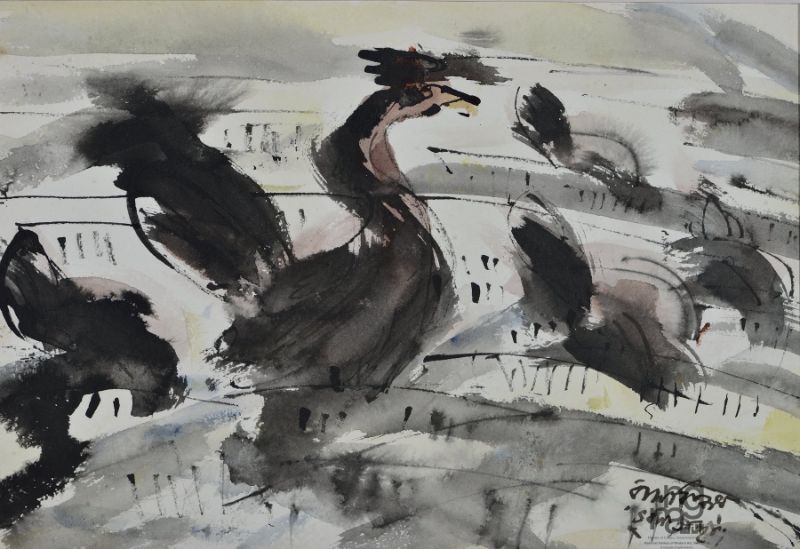 ×Ramkinkar's deep felt love and oneness with nature could be seen in his vigorously painted and sculpted images of the animals, birds, flora and fauna in his surroundings. In this painting, he has studied the form of a bird, rendered with dabs and dashes of watercolour merging together in tonal variations and fluid strokes of ink delineating the forms.
×Ramkinkar's deep felt love and oneness with nature could be seen in his vigorously painted and sculpted images of the animals, birds, flora and fauna in his surroundings. In this painting, he has studied the form of a bird, rendered with dabs and dashes of watercolour merging together in tonal variations and fluid strokes of ink delineating the forms. -
Life Study
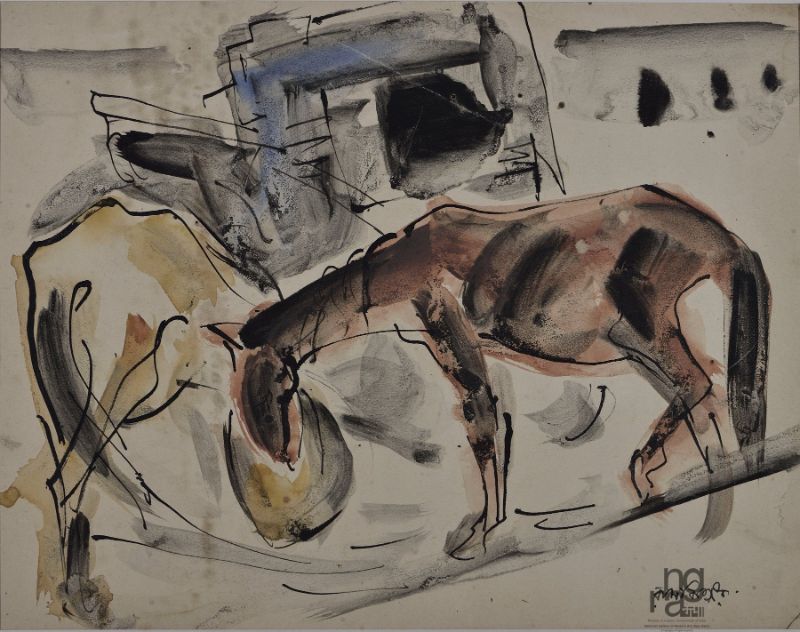 ×Ramkinkar's deep felt love and oneness with nature could be seen in his vigorously painted and sculpted images of the animals, birds, flora and fauna in his surroundings. In this painting, he has studied the form of a horse, rendered with dabs and dashes of watercolour merging together in tonal variations and fluid strokes of ink delineating the form.
×Ramkinkar's deep felt love and oneness with nature could be seen in his vigorously painted and sculpted images of the animals, birds, flora and fauna in his surroundings. In this painting, he has studied the form of a horse, rendered with dabs and dashes of watercolour merging together in tonal variations and fluid strokes of ink delineating the form. -
Life Study
 ×Ramkinkar Baij selected images for his sculptures and paintings from his rural surroundings. The poor and the downtrodden figured primarily as his subjects. Baij's watercolours mostly reflect his preoccupation with nature and the animal world. His work is characterised by tremendous energy, dynamism and the use of earthy colours. In the above painting, the artist has depicted an elephant, rendered with dabs and dashes of watercolour in tonal variations, delineating the form.
×Ramkinkar Baij selected images for his sculptures and paintings from his rural surroundings. The poor and the downtrodden figured primarily as his subjects. Baij's watercolours mostly reflect his preoccupation with nature and the animal world. His work is characterised by tremendous energy, dynamism and the use of earthy colours. In the above painting, the artist has depicted an elephant, rendered with dabs and dashes of watercolour in tonal variations, delineating the form. -
Life Study
 ×Ramkinkar deep felt love and oneness with nature could be seen in his vigorously painted and sculpted images of animals and birds seen around him. In this sketch, he has studied the head of a horse with fluid yet firm strokes of pen and ink delineating the form and shape of the head in realistic a manner.
×Ramkinkar deep felt love and oneness with nature could be seen in his vigorously painted and sculpted images of animals and birds seen around him. In this sketch, he has studied the head of a horse with fluid yet firm strokes of pen and ink delineating the form and shape of the head in realistic a manner. -
Life Study
 ×Ramkinkar Baij selected images for his sculptures and paintings from his rural surroundings. The poor and the downtrodden figured primarily as his subjects. Baij's watercolours mostly reflect his preoccupation with nature and the animal world. His work is characterized by tremendous energy, dynamism and the use of earthy colours. In the above painting, the artist has depicted a horse with dabs and dashes of watercolour in tonal variation delineating the form.
×Ramkinkar Baij selected images for his sculptures and paintings from his rural surroundings. The poor and the downtrodden figured primarily as his subjects. Baij's watercolours mostly reflect his preoccupation with nature and the animal world. His work is characterized by tremendous energy, dynamism and the use of earthy colours. In the above painting, the artist has depicted a horse with dabs and dashes of watercolour in tonal variation delineating the form. -
Life Study
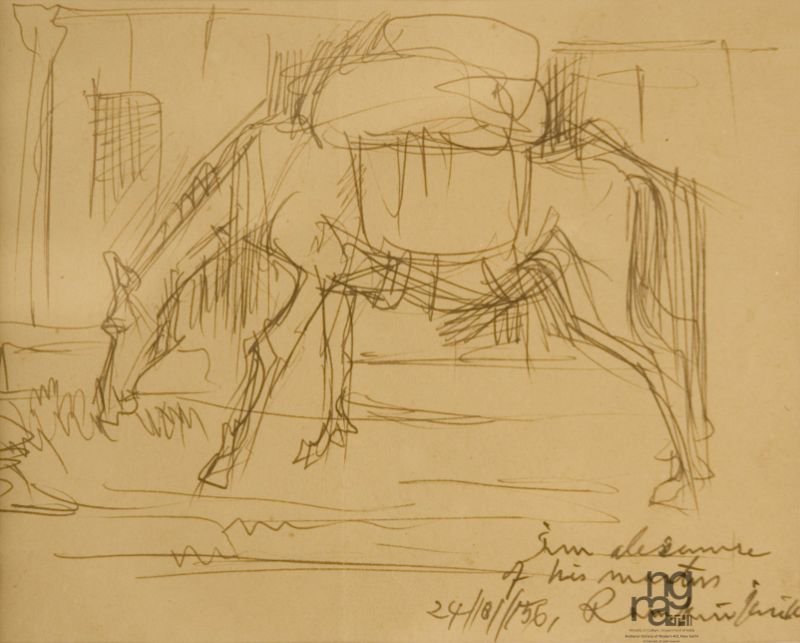 ×Ramkinkar Baijís artistic temperament was defined at Santiniketan an art institution known for providing an informed western modernistic environment to the students. Baij was immensely influenced by his austere surroundings, the ordinary people and nature that became the subject matter for painting and sculpture. In the above painting, the artist has depicted a horse grazing delineated with fine yet firm pencil strokes. The treatment is intended to exemplify an energetic and lively artistic temperament.
×Ramkinkar Baijís artistic temperament was defined at Santiniketan an art institution known for providing an informed western modernistic environment to the students. Baij was immensely influenced by his austere surroundings, the ordinary people and nature that became the subject matter for painting and sculpture. In the above painting, the artist has depicted a horse grazing delineated with fine yet firm pencil strokes. The treatment is intended to exemplify an energetic and lively artistic temperament. -
Life Study
 ×Ramkinkar Baijís artistic temperament was defined at Santiniketan an art institution known for providing an informed western modernistic environment to the students. Baij was immensely influenced by his austere surroundings, the ordinary people and nature that became the subject matter for painting and sculpture. In the above painting, the artist has depicted a group of harvesters, delineated with dabs and dashes of watercolour, outlined with black brush strokes. The treatment is intended to exemplify an energetic and lively artistic temperament.
×Ramkinkar Baijís artistic temperament was defined at Santiniketan an art institution known for providing an informed western modernistic environment to the students. Baij was immensely influenced by his austere surroundings, the ordinary people and nature that became the subject matter for painting and sculpture. In the above painting, the artist has depicted a group of harvesters, delineated with dabs and dashes of watercolour, outlined with black brush strokes. The treatment is intended to exemplify an energetic and lively artistic temperament. -
Life Study
 ×Ramkinkar Baij was a reclusive modernist artist who always remained on the fringes of the art market. He took a great interest in human figures, body language and in the general human drama. Modern Western art and pre and post-classical Indian art were his main points of reference. Although primarily known for his expressionistic sculpture, he was also a gifted painter. The sense of rhythm that his sculpture was noted for is manifested brilliantly in his paintings and sketches. His works in the Kalighat tradition interconnected with Cubism to achieve an unusual personal idiom. Both his sculpture and his paintings are unprompted and bold.
×Ramkinkar Baij was a reclusive modernist artist who always remained on the fringes of the art market. He took a great interest in human figures, body language and in the general human drama. Modern Western art and pre and post-classical Indian art were his main points of reference. Although primarily known for his expressionistic sculpture, he was also a gifted painter. The sense of rhythm that his sculpture was noted for is manifested brilliantly in his paintings and sketches. His works in the Kalighat tradition interconnected with Cubism to achieve an unusual personal idiom. Both his sculpture and his paintings are unprompted and bold. -
Life Study
 ×Ramkinkar felt deep love and oneness with nature, that could be seen in his vigorously painted and sculpted images of the animals, birds, flora and fauna in his surroundings. In this painting, the artist has depicted men and women walking past a horse, rendered with dabs and dashes of watercolour. The colours are merged together in tonal variations to delineate the forms and add grace to the composition.
×Ramkinkar felt deep love and oneness with nature, that could be seen in his vigorously painted and sculpted images of the animals, birds, flora and fauna in his surroundings. In this painting, the artist has depicted men and women walking past a horse, rendered with dabs and dashes of watercolour. The colours are merged together in tonal variations to delineate the forms and add grace to the composition. -
Life Study
 ×Ramkinkar Baij selected images for his sculptures and paintings from his rural surroundings. The poor and the downtrodden figured primarily as his subjects. His work is characterized by tremendous energy, dynamism and the use of earthy colours. In this sketch, the artist has depicted a sketch of a horse head, rendered with fluid, fine lines of pencil delineating the form.
×Ramkinkar Baij selected images for his sculptures and paintings from his rural surroundings. The poor and the downtrodden figured primarily as his subjects. His work is characterized by tremendous energy, dynamism and the use of earthy colours. In this sketch, the artist has depicted a sketch of a horse head, rendered with fluid, fine lines of pencil delineating the form. -
Life Study
 ×Ramkinkar Baijís artistic temperament was defined at Santiniketan an art institution known for providing an informed western modernistic environment to the students. Baij was immensely influenced by his austere surroundings, the ordinary people and nature that became the subject matter for painting and sculpture. In the above painting, the artist has depicted ducks, delineated with dabs and dashes of watercolour, outlined with black strokes. The treatment is intended to exemplify an energetic and lively artistic temperament.
×Ramkinkar Baijís artistic temperament was defined at Santiniketan an art institution known for providing an informed western modernistic environment to the students. Baij was immensely influenced by his austere surroundings, the ordinary people and nature that became the subject matter for painting and sculpture. In the above painting, the artist has depicted ducks, delineated with dabs and dashes of watercolour, outlined with black strokes. The treatment is intended to exemplify an energetic and lively artistic temperament. -
Life Study
 ×Ramkinkar Baij selected images for his sculptors and paintings from his rural surroundings. The poor and the downtrodden figured primarily as his subjects. Baij's watercolours mostly reflect his preoccupation with nature and the animal world. His work is characterized by tremendous energy, dynamism and the use of earthy colours. In the above painting, the artist has depicted a lady sitting on the floor with dabs and dashes of watercolour in tonal variation delineating the form.
×Ramkinkar Baij selected images for his sculptors and paintings from his rural surroundings. The poor and the downtrodden figured primarily as his subjects. Baij's watercolours mostly reflect his preoccupation with nature and the animal world. His work is characterized by tremendous energy, dynamism and the use of earthy colours. In the above painting, the artist has depicted a lady sitting on the floor with dabs and dashes of watercolour in tonal variation delineating the form. -
Life Study
 ×Ramkinkar Baij selected images for his sculptors and paintings from his rural surroundings. The poor and the downtrodden figured primarily as his subjects. Baij's watercolours mostly reflects his preoccupation with nature and the animal world. His work is characterized by tremendous energy, dynamism and the use of earthy colours. In the above painting, the artist has depicted a sketch of Binodini with dabs and dashes of watercolour in tonal variation delineating the form. Binodini was one of the frequent images in Baij's works with gracious presence.
×Ramkinkar Baij selected images for his sculptors and paintings from his rural surroundings. The poor and the downtrodden figured primarily as his subjects. Baij's watercolours mostly reflects his preoccupation with nature and the animal world. His work is characterized by tremendous energy, dynamism and the use of earthy colours. In the above painting, the artist has depicted a sketch of Binodini with dabs and dashes of watercolour in tonal variation delineating the form. Binodini was one of the frequent images in Baij's works with gracious presence. -
Life Study
 ×Ramkinkar Baij selected images for his sculptors and paintings from his rural surroundings. The poor and the downtrodden figured primarily as his subjects. Baij's watercolours mostly reflects his preoccupation with nature and the animal world. His work is characterized by tremendous energy, dynamism and the use of earthy colours. In the above painting, the artist has depicted a human figure sitting on a tree branch with dabs and dashes of watercolour in tonal variation delineating the form.
×Ramkinkar Baij selected images for his sculptors and paintings from his rural surroundings. The poor and the downtrodden figured primarily as his subjects. Baij's watercolours mostly reflects his preoccupation with nature and the animal world. His work is characterized by tremendous energy, dynamism and the use of earthy colours. In the above painting, the artist has depicted a human figure sitting on a tree branch with dabs and dashes of watercolour in tonal variation delineating the form. -
Life Study
 ×Ramkinkar Baij selected images for his sculptures and paintings from his rural surroundings. The poor and the downtrodden figured primarily as his subjects. Baij's watercolours mostly reflect his preoccupation with nature and the animal world. His work is characterized by tremendous energy, dynamism and the use of earthy colours.†In the above painting, the artist has depicted two buffaloes with dabs†and dashes of watercolour in tonal variation delineating the form.
×Ramkinkar Baij selected images for his sculptures and paintings from his rural surroundings. The poor and the downtrodden figured primarily as his subjects. Baij's watercolours mostly reflect his preoccupation with nature and the animal world. His work is characterized by tremendous energy, dynamism and the use of earthy colours.†In the above painting, the artist has depicted two buffaloes with dabs†and dashes of watercolour in tonal variation delineating the form. -
Life Study
 ×Ramkinkar Baij selected images for his sculptures and paintings from his rural surroundings. The poor and the downtrodden figured primarily as his subjects. Baij's watercolours mostly reflect his preoccupation with nature and the animal world. His work is characterised by tremendous energy, dynamism and the use of earthy colours. In the above painting, the artist has depicted a mahout bathing an elephant, rendered with dabs and dashes of watercolour in tonal variations, delineating the form.
×Ramkinkar Baij selected images for his sculptures and paintings from his rural surroundings. The poor and the downtrodden figured primarily as his subjects. Baij's watercolours mostly reflect his preoccupation with nature and the animal world. His work is characterised by tremendous energy, dynamism and the use of earthy colours. In the above painting, the artist has depicted a mahout bathing an elephant, rendered with dabs and dashes of watercolour in tonal variations, delineating the form. -
Life Study
 ×Ramkinker's sketches, much like the quality of his sculptures are earthy and dynamic. They reflect a keen observer's eye through the quick but a detailed observations in them. His watercolour renderings are sketchy in nature but have the quality of a detailed documented visual reflection.† This watercolour of his depicts a landscape with cows resting.
×Ramkinker's sketches, much like the quality of his sculptures are earthy and dynamic. They reflect a keen observer's eye through the quick but a detailed observations in them. His watercolour renderings are sketchy in nature but have the quality of a detailed documented visual reflection.† This watercolour of his depicts a landscape with cows resting. -
Life Study
 ×Ram kinkar Baij selected images for his sculptors and paintings from his rural surroundings. The poor and the downtrodden figured primarily as his subjects. His work is characterized by tremendous energy, dynamism and the use of earthy colours. In this sketch, the artist has depicted a sketch of a cart, rendered with fluid, fine lines of pen and ink delineating the form.
×Ram kinkar Baij selected images for his sculptors and paintings from his rural surroundings. The poor and the downtrodden figured primarily as his subjects. His work is characterized by tremendous energy, dynamism and the use of earthy colours. In this sketch, the artist has depicted a sketch of a cart, rendered with fluid, fine lines of pen and ink delineating the form. -
Life Study
 ×Ramkinkar Baij was immensely influenced by his austere surrounding, the ordinary people and the nature that it became its subject matter for painting and sculpture. In this painting, he has depicted a woman filling up her pitcher from the river, rendered with swift, fluid strokes of watercolours merging together in tonal variation, delineating the form and figure of a woman.
×Ramkinkar Baij was immensely influenced by his austere surrounding, the ordinary people and the nature that it became its subject matter for painting and sculpture. In this painting, he has depicted a woman filling up her pitcher from the river, rendered with swift, fluid strokes of watercolours merging together in tonal variation, delineating the form and figure of a woman. -
Life Study
 ×Ramkinkar Baij was a reclusive modernist artist who always remained on the fringes of the art market. He took a great interest in human figures, body language and in the general human drama. Modern Western art and pre and post-classical Indian art were his main points of reference. Although primarily known for his expressionistic sculpture, he was also a gifted painter. The sense of rhythm that his sculpture was noted for is manifested brilliantly in his paintings and sketches. His works in the Kalighat tradition interconnected with Cubism to achieve an unusual personal idiom. Both his sculpture and his paintings are unprompted and bold.
×Ramkinkar Baij was a reclusive modernist artist who always remained on the fringes of the art market. He took a great interest in human figures, body language and in the general human drama. Modern Western art and pre and post-classical Indian art were his main points of reference. Although primarily known for his expressionistic sculpture, he was also a gifted painter. The sense of rhythm that his sculpture was noted for is manifested brilliantly in his paintings and sketches. His works in the Kalighat tradition interconnected with Cubism to achieve an unusual personal idiom. Both his sculpture and his paintings are unprompted and bold. -
Life Study
 ×Ramkinkar Baij was immensely influenced by his austere surrounding, the ordinary people and the nature that it became its subject matter for painting and sculpture. In this painting, he has depicted a girl sitting under a tree, rendered with swift strokes of watercolour in tonal variation and fluid, bold strokes of ink delineating the figure.
×Ramkinkar Baij was immensely influenced by his austere surrounding, the ordinary people and the nature that it became its subject matter for painting and sculpture. In this painting, he has depicted a girl sitting under a tree, rendered with swift strokes of watercolour in tonal variation and fluid, bold strokes of ink delineating the figure. -
Life Study
 ×Ramkinkar Baij selected images for his sculptures and paintings from his rural surroundings. The poor and the downtrodden figured primarily as his subjects. Baij's watercolours mostly reflect his preoccupation with nature and the animal world. His work is characterized by tremendous energy, dynamism and the use of earthy colours. In the above painting, the artist has depicted harvesters at the field with dabs and dashes of watercolour in tonal variation delineating the form.
×Ramkinkar Baij selected images for his sculptures and paintings from his rural surroundings. The poor and the downtrodden figured primarily as his subjects. Baij's watercolours mostly reflect his preoccupation with nature and the animal world. His work is characterized by tremendous energy, dynamism and the use of earthy colours. In the above painting, the artist has depicted harvesters at the field with dabs and dashes of watercolour in tonal variation delineating the form. -
Life Study
 ×Ramkinkar Baij was immensely influenced by his austere surrounding, the ordinary people and the nature that it became its subject matter for painting and sculpture. In this painting, he has depicted two female figures wearing saree, rendered with light strokes of watercolour in tonal variation and fluid, bold strokes of ink delineating the figures.
×Ramkinkar Baij was immensely influenced by his austere surrounding, the ordinary people and the nature that it became its subject matter for painting and sculpture. In this painting, he has depicted two female figures wearing saree, rendered with light strokes of watercolour in tonal variation and fluid, bold strokes of ink delineating the figures. -
Life Study
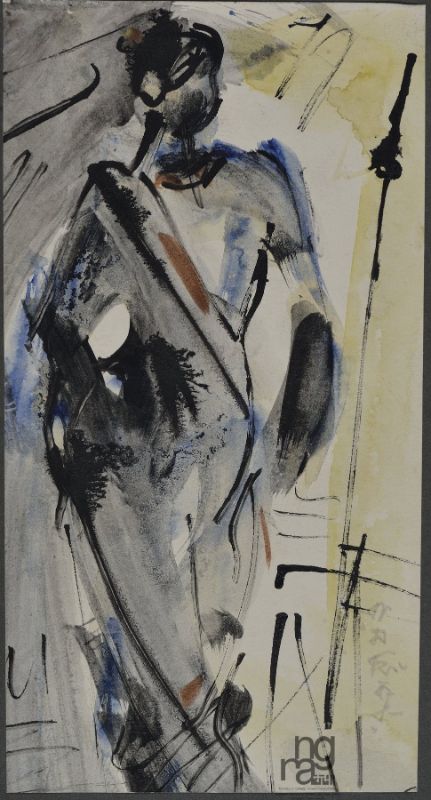 ×Ramkinkar Baij was a reclusive modernist artist who always remained on the fringes of the art market. He took a great interest in human figures, body language and in the general human drama. Modern Western art and pre and post-classical Indian art were his main points of reference. Although primarily known for his expressionistic sculpture, he was also a gifted painter. The sense of rhythm that his sculpture was noted for is manifested brilliantly in his paintings and sketches. His works in the Kalighat tradition interconnected with Cubism to achieve an unusual personal idiom. Both his sculpture and his paintings are unprompted and bold.
×Ramkinkar Baij was a reclusive modernist artist who always remained on the fringes of the art market. He took a great interest in human figures, body language and in the general human drama. Modern Western art and pre and post-classical Indian art were his main points of reference. Although primarily known for his expressionistic sculpture, he was also a gifted painter. The sense of rhythm that his sculpture was noted for is manifested brilliantly in his paintings and sketches. His works in the Kalighat tradition interconnected with Cubism to achieve an unusual personal idiom. Both his sculpture and his paintings are unprompted and bold. -
Life Study
 ×Ramkinker's sketches, much like the quality of his sculptures are earthy and dynamic. They reflect a keen observer's eye through the quick but a detailed observations in them. His watercolour renderings are sketchy in nature but have the quality of a detailed documented visual reflection.† This watercolour depicts the basket makers.
×Ramkinker's sketches, much like the quality of his sculptures are earthy and dynamic. They reflect a keen observer's eye through the quick but a detailed observations in them. His watercolour renderings are sketchy in nature but have the quality of a detailed documented visual reflection.† This watercolour depicts the basket makers. -
Life Study
 ×Ramkinkar Baijís artistic temperament was defined at Santiniketan, an art institution known for providing an informed western modernistic environment to the students. Baij was immensely influenced by his austere surroundings, the ordinary people and nature that became the subject matter for painting and sculpture. In this sketch, he has rendered a horse head with the use of fluid, fine lines of pencil suggesting the detail form the head.
×Ramkinkar Baijís artistic temperament was defined at Santiniketan, an art institution known for providing an informed western modernistic environment to the students. Baij was immensely influenced by his austere surroundings, the ordinary people and nature that became the subject matter for painting and sculpture. In this sketch, he has rendered a horse head with the use of fluid, fine lines of pencil suggesting the detail form the head. -
Life Study
 ×Ramkinkar Baij was a reclusive modernist artist who always remained on the fringes of the art market. He took a great interest in human figures, body language and in the general human drama. Modern Western art and pre and post-classical Indian art were his main points of reference. Although primarily known for his expressionistic sculpture, he was also a gifted painter. The sense of rhythm that his sculpture was noted for is manifested brilliantly in his paintings and sketches. His works in the Kalighat tradition interconnected with Cubism to achieve an unusual personal idiom. Both his sculpture and his paintings are unprompted and bold.
×Ramkinkar Baij was a reclusive modernist artist who always remained on the fringes of the art market. He took a great interest in human figures, body language and in the general human drama. Modern Western art and pre and post-classical Indian art were his main points of reference. Although primarily known for his expressionistic sculpture, he was also a gifted painter. The sense of rhythm that his sculpture was noted for is manifested brilliantly in his paintings and sketches. His works in the Kalighat tradition interconnected with Cubism to achieve an unusual personal idiom. Both his sculpture and his paintings are unprompted and bold. -
Life Study
 ×Ramkinkar Baij selected images for his sculptors and paintings from his rural surroundings. The poor and the downtrodden figured primarily as his subjects. Baij's watercolours mostly reflects his preoccupation with nature and the animal world. His work is characterized by tremendous energy, dynamism and the use of earthy colours. In the above painting, the artist has depicted two human figures with dabs and dashes of watercolour in tonal variation delineating the form.
×Ramkinkar Baij selected images for his sculptors and paintings from his rural surroundings. The poor and the downtrodden figured primarily as his subjects. Baij's watercolours mostly reflects his preoccupation with nature and the animal world. His work is characterized by tremendous energy, dynamism and the use of earthy colours. In the above painting, the artist has depicted two human figures with dabs and dashes of watercolour in tonal variation delineating the form. -
Life Study
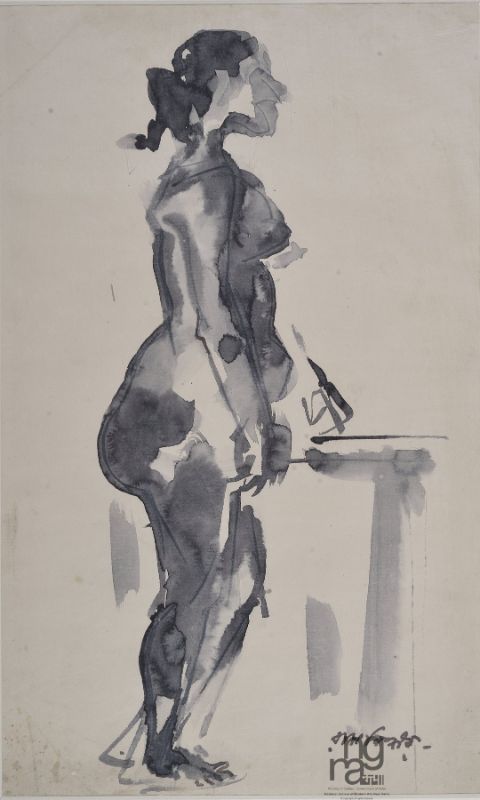 ×Ramkinkar Baijís artistic temperament was defined at Santiniketan, an art institution known for providing an informed western modernistic environment to the students. Baij was immensely influenced by his austere surroundings, the ordinary people and nature that became the subject matter for painting and sculpture. In this sketch, he has depicted a nude female figure standing near the table, rendered with fluid, swift strokes of ink in tonal variation. The treatment is intended to exemplify an energetic and lively artistic temperament.
×Ramkinkar Baijís artistic temperament was defined at Santiniketan, an art institution known for providing an informed western modernistic environment to the students. Baij was immensely influenced by his austere surroundings, the ordinary people and nature that became the subject matter for painting and sculpture. In this sketch, he has depicted a nude female figure standing near the table, rendered with fluid, swift strokes of ink in tonal variation. The treatment is intended to exemplify an energetic and lively artistic temperament. -
Life Study
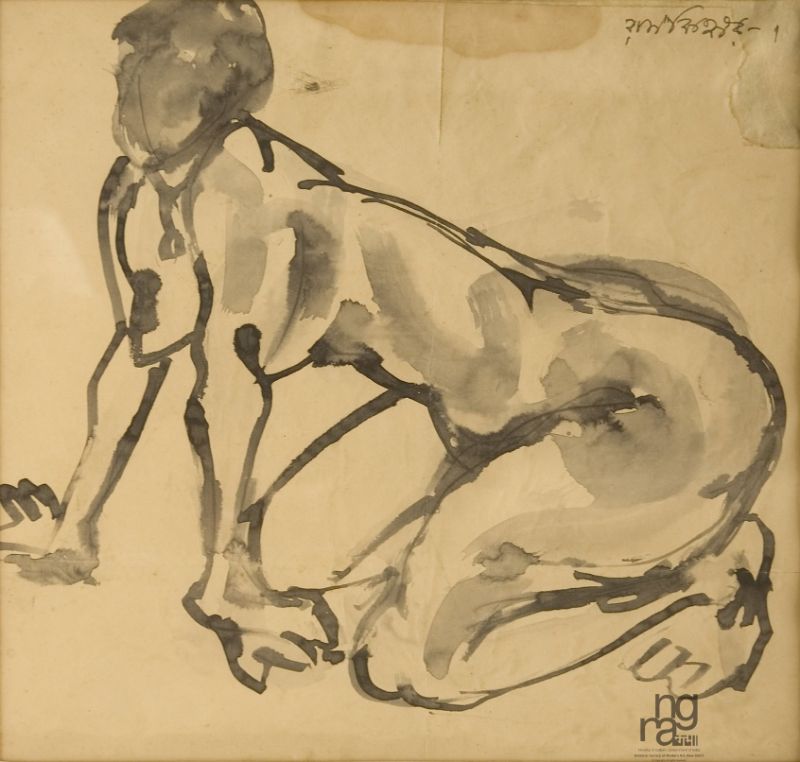 ×Ramkinkar Baij selected images for his sculptors and paintings from his rural surroundings. The poor and the downtrodden figured primarily as his subjects. Baij's watercolours mostly reflects his preoccupation with nature and the animal world. His work is characterized by tremendous energy, dynamism and the use of earthy colours. In the above painting, the artist has depicted a crunching nude figure with dabs and dashes of watercolour in tonal variation delineating the form.
×Ramkinkar Baij selected images for his sculptors and paintings from his rural surroundings. The poor and the downtrodden figured primarily as his subjects. Baij's watercolours mostly reflects his preoccupation with nature and the animal world. His work is characterized by tremendous energy, dynamism and the use of earthy colours. In the above painting, the artist has depicted a crunching nude figure with dabs and dashes of watercolour in tonal variation delineating the form. -
Life Study
 ×Ramkinkar Baij was immensely influenced by his austere surrounding, the ordinary people†and the nature that it became its subject matter for painting and sculpture. In this painting, he has depicted a women having†bath†on†shore†of a river, rendered with swift strokes of watercolour in tonal variation and fluid, bold strokes of ink delineating the figures.
×Ramkinkar Baij was immensely influenced by his austere surrounding, the ordinary people†and the nature that it became its subject matter for painting and sculpture. In this painting, he has depicted a women having†bath†on†shore†of a river, rendered with swift strokes of watercolour in tonal variation and fluid, bold strokes of ink delineating the figures. -
Life Study
 ×Ramkinkar Baij was a reclusive modernist artist who always remained on the fringes of the art market. He took a great interest in human figures, body language and in the general human drama. Modern Western art and pre and post-classical Indian art were his main points of reference. Although primarily known for his expressionistic sculpture, he was also a gifted painter. The sense of rhythm that his sculpture was noted for is manifested brilliantly in his paintings and sketches. His works in the Kalighat tradition interconnected with Cubism to achieve an unusual personal idiom. Both his sculpture and his paintings are unprompted and bold.
×Ramkinkar Baij was a reclusive modernist artist who always remained on the fringes of the art market. He took a great interest in human figures, body language and in the general human drama. Modern Western art and pre and post-classical Indian art were his main points of reference. Although primarily known for his expressionistic sculpture, he was also a gifted painter. The sense of rhythm that his sculpture was noted for is manifested brilliantly in his paintings and sketches. His works in the Kalighat tradition interconnected with Cubism to achieve an unusual personal idiom. Both his sculpture and his paintings are unprompted and bold. -
Life Study
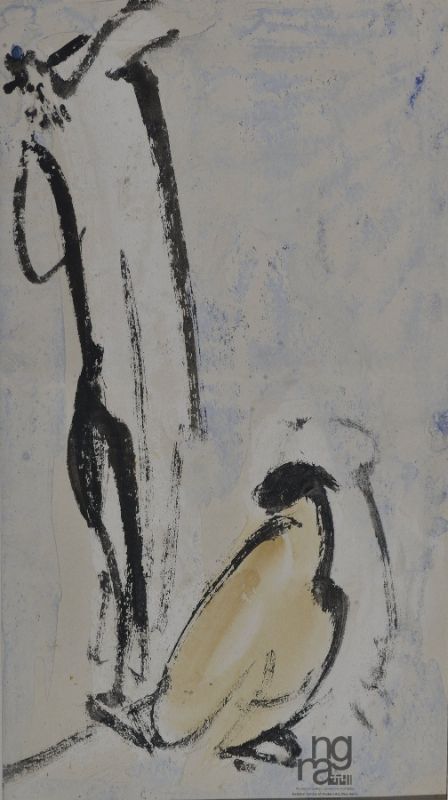 ×Ramkinkar Baij was a reclusive modernist artist who always remained on the fringes of the art market. He took a great interest in human figures, body language and in the general human drama. Modern Western art and pre and post-classical Indian art were his main points of reference. Although primarily known for his expressionistic sculpture, he was also a gifted painter. The sense of rhythm that his sculpture was noted for is manifested brilliantly in his paintings and sketches. His works in the Kalighat tradition interconnected with Cubism to achieve an unusual personal idiom. Both his sculpture and his paintings are unprompted and bold.
×Ramkinkar Baij was a reclusive modernist artist who always remained on the fringes of the art market. He took a great interest in human figures, body language and in the general human drama. Modern Western art and pre and post-classical Indian art were his main points of reference. Although primarily known for his expressionistic sculpture, he was also a gifted painter. The sense of rhythm that his sculpture was noted for is manifested brilliantly in his paintings and sketches. His works in the Kalighat tradition interconnected with Cubism to achieve an unusual personal idiom. Both his sculpture and his paintings are unprompted and bold. -
Life Study
 ×Ramkinkar Baij selected images for his sculptors and paintings from his rural surroundings. The poor and the downtrodden figured primarily as his subjects. Baij's watercolours mostly reflects his preoccupation with nature and the animal world. His work is characterized by tremendous energy, dynamism and the use of earthy colours. In the above painting, the artist has depicted a girl amidst bushes with dabs and dashes of watercolour in tonal variation delineating the form.
×Ramkinkar Baij selected images for his sculptors and paintings from his rural surroundings. The poor and the downtrodden figured primarily as his subjects. Baij's watercolours mostly reflects his preoccupation with nature and the animal world. His work is characterized by tremendous energy, dynamism and the use of earthy colours. In the above painting, the artist has depicted a girl amidst bushes with dabs and dashes of watercolour in tonal variation delineating the form. -
Life Study
 ×Ramkinkar Baij selected images for his sculptors and paintings from his rural surroundings. The poor and the downtrodden figured primarily as his subjects. Baij's watercolours mostly reflects his preoccupation with nature and the animal world. His work is characterized by tremendous energy, dynamism and the use of earthy colours. In the above painting, the artist has depicted a sketch of Binodini sitting on the floor with dabs and dashes of watercolour in tonal variation delineating the form. Binodini was one of the frequent images in Baij's works with gracious presence.
×Ramkinkar Baij selected images for his sculptors and paintings from his rural surroundings. The poor and the downtrodden figured primarily as his subjects. Baij's watercolours mostly reflects his preoccupation with nature and the animal world. His work is characterized by tremendous energy, dynamism and the use of earthy colours. In the above painting, the artist has depicted a sketch of Binodini sitting on the floor with dabs and dashes of watercolour in tonal variation delineating the form. Binodini was one of the frequent images in Baij's works with gracious presence. -
Life Study
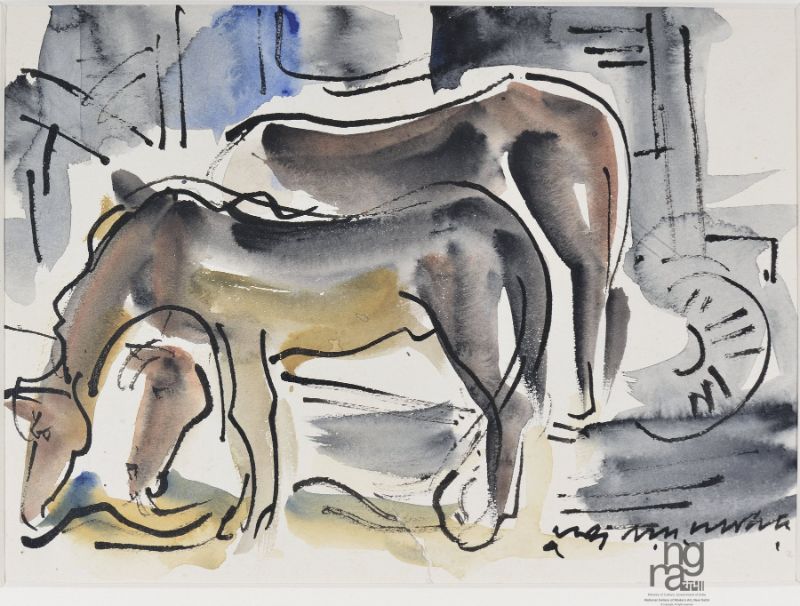 ×Ramkinker's sketches, much like the quality of his sculptures are earthy and dynamic. They reflect a keen observer's eye through the quick but a detailed observations in them. His watercolour renderings are sketchy in nature but have the quality of a detailed documented visual reflection.† This watercolour of his is a sketch of the horses grazing in front of the cart kept at rest.
×Ramkinker's sketches, much like the quality of his sculptures are earthy and dynamic. They reflect a keen observer's eye through the quick but a detailed observations in them. His watercolour renderings are sketchy in nature but have the quality of a detailed documented visual reflection.† This watercolour of his is a sketch of the horses grazing in front of the cart kept at rest. -
Life Study
 ×Ramkinkar Baij selected images for his sculptors and paintings from his rural surroundings. The poor and the downtrodden figured primarily as his subjects. Baij's watercolours mostly reflect his preoccupation with nature and the animal world. His work is characterized by tremendous energy, dynamism and the use of earthy colours. In the above painting, the artist has depicted a lady with a pitcher with dabs and dashes of watercolour in tonal variation delineating the form.
×Ramkinkar Baij selected images for his sculptors and paintings from his rural surroundings. The poor and the downtrodden figured primarily as his subjects. Baij's watercolours mostly reflect his preoccupation with nature and the animal world. His work is characterized by tremendous energy, dynamism and the use of earthy colours. In the above painting, the artist has depicted a lady with a pitcher with dabs and dashes of watercolour in tonal variation delineating the form. -
Life Study
 ×Ramkinkar Baij was immensely influenced by his austere surrounding, the ordinary people and the nature that it became its subject matter for painting and sculpture. In this painting, he has depicted a couple sitting under the tree, rendered with swift, fluid strokes of watercolors merging together in tonal variation delineating the form and figure of the couple.
×Ramkinkar Baij was immensely influenced by his austere surrounding, the ordinary people and the nature that it became its subject matter for painting and sculpture. In this painting, he has depicted a couple sitting under the tree, rendered with swift, fluid strokes of watercolors merging together in tonal variation delineating the form and figure of the couple. -
Life Study
 ×Ramkinkar Baij selected images for his sculptors and paintings from his rural surroundings. The poor and the downtrodden figured primarily as his subjects. Baij's watercolours mostly reflects his preoccupation with nature and the animal world. His work is characterized by tremendous energy, dynamism and the use of earthy colours. In the above painting, the artist has depicted a couple resting under the tree with dabs and dashes of watercolour in tonal variation delineating the form.
×Ramkinkar Baij selected images for his sculptors and paintings from his rural surroundings. The poor and the downtrodden figured primarily as his subjects. Baij's watercolours mostly reflects his preoccupation with nature and the animal world. His work is characterized by tremendous energy, dynamism and the use of earthy colours. In the above painting, the artist has depicted a couple resting under the tree with dabs and dashes of watercolour in tonal variation delineating the form. -
Life Study
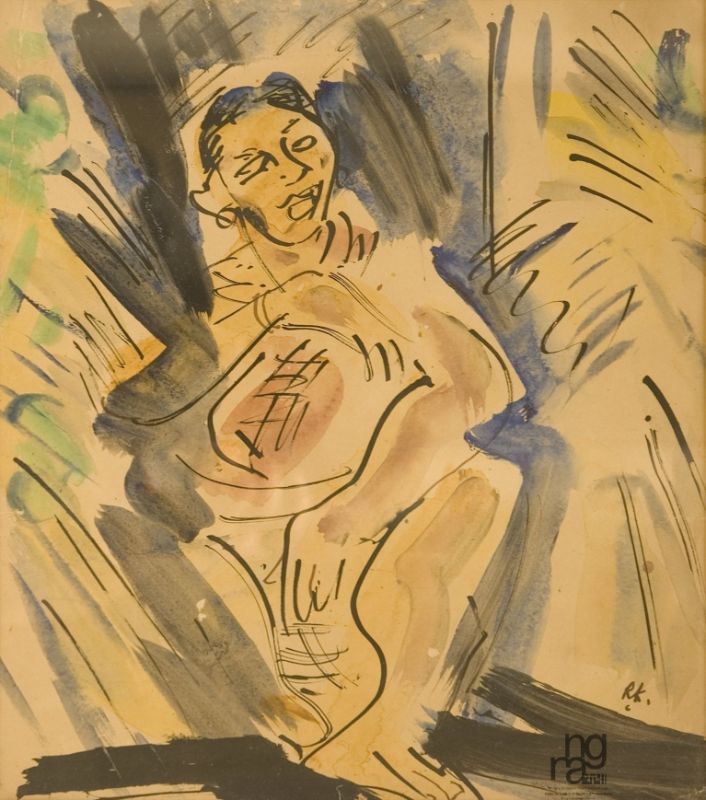 ×Ramkinkar Baij selected images for his sculptors and paintings from his rural surroundings. The poor and the downtrodden figured primarily as his subjects. Baij's watercolours mostly reflects his preoccupation with nature and the animal world. His work is characterized by tremendous energy, dynamism and the use of earthy colours. In the above painting, the artist has depicted a woman sitting on the floor with dabs and dashes of watercolour in tonal variation delineating the form.
×Ramkinkar Baij selected images for his sculptors and paintings from his rural surroundings. The poor and the downtrodden figured primarily as his subjects. Baij's watercolours mostly reflects his preoccupation with nature and the animal world. His work is characterized by tremendous energy, dynamism and the use of earthy colours. In the above painting, the artist has depicted a woman sitting on the floor with dabs and dashes of watercolour in tonal variation delineating the form. -
Life Study
 ×Ramkinkar Baij was immensely influenced by his austere surrounding, the ordinary people and the nature that it became its subject matter for painting and sculpture. In this painting, he has depicted a man and a woman with bullock cart, rendered with swift strokes of watercolour in tonal variation and fluid, bold strokes of ink delineating the figures.
×Ramkinkar Baij was immensely influenced by his austere surrounding, the ordinary people and the nature that it became its subject matter for painting and sculpture. In this painting, he has depicted a man and a woman with bullock cart, rendered with swift strokes of watercolour in tonal variation and fluid, bold strokes of ink delineating the figures. -
Life Study
 ×Ramkinkar Baij selected images for his sculptors and paintings from his rural surroundings. The poor and the downtrodden figured primarily as his subjects. Baij's watercolours mostly reflects his preoccupation with nature and the animal world. His work is characterized by tremendous energy, dynamism and the use of earthy colours. In the above painting, the artist has depicted a group of villagers with dabs and dashes of watercolour in tonal variation delineating the form.
×Ramkinkar Baij selected images for his sculptors and paintings from his rural surroundings. The poor and the downtrodden figured primarily as his subjects. Baij's watercolours mostly reflects his preoccupation with nature and the animal world. His work is characterized by tremendous energy, dynamism and the use of earthy colours. In the above painting, the artist has depicted a group of villagers with dabs and dashes of watercolour in tonal variation delineating the form. -
Life Study
 ×Ramkinkar Baij selected images for his sculptures and paintings from his rural surroundings. The poor and the downtrodden figured primarily as his subjects. Baij's watercolours mostly reflect his preoccupation with nature and the animal world. His work is characterized by tremendous energy, dynamism and the use of earthy colours. In the above painting, the artist has depicted a landscape with dabs and dashes of watercolour in tonal variation delineating the form.
×Ramkinkar Baij selected images for his sculptures and paintings from his rural surroundings. The poor and the downtrodden figured primarily as his subjects. Baij's watercolours mostly reflect his preoccupation with nature and the animal world. His work is characterized by tremendous energy, dynamism and the use of earthy colours. In the above painting, the artist has depicted a landscape with dabs and dashes of watercolour in tonal variation delineating the form. -
Life Study
 ×Ramkinkar was well aware of the post-industrial art or the modern movements in the western and eastern art scene and tried to incorporate the dynamics of such changes in his own work while keeping the Santiniketan aesthetic tradition in focus. In this sketch, he has depicted a nude woman forming through swift stroke of ink on paper in tonal variation.
×Ramkinkar was well aware of the post-industrial art or the modern movements in the western and eastern art scene and tried to incorporate the dynamics of such changes in his own work while keeping the Santiniketan aesthetic tradition in focus. In this sketch, he has depicted a nude woman forming through swift stroke of ink on paper in tonal variation. -
Life Study
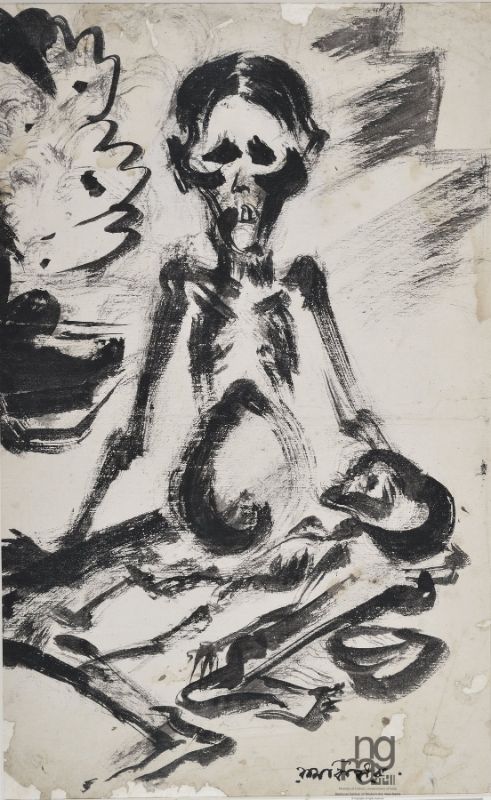 ×Ramkinkar Baijís artistic temperament was defined at Santiniketan, an art institution known for providing an informed western modernistic environment to the students. Baij was immensely influenced by his austere surroundings, the ordinary people and nature that became the subject matter for painting and sculpture. In this sketch, he has depicted a skeleton form of a mother and child, rendered with the use of fluid, bold strokes of ink suggesting the basic form of the figures.
×Ramkinkar Baijís artistic temperament was defined at Santiniketan, an art institution known for providing an informed western modernistic environment to the students. Baij was immensely influenced by his austere surroundings, the ordinary people and nature that became the subject matter for painting and sculpture. In this sketch, he has depicted a skeleton form of a mother and child, rendered with the use of fluid, bold strokes of ink suggesting the basic form of the figures. -
Life Study
 ×Ramkinkar Baij selected images for his sculptors and paintings from his rural surroundings. The poor and the downtrodden figured primarily as his subjects. Baij's watercolours mostly reflects his preoccupation with nature and the animal world. His work is characterized by tremendous energy, dynamism and the use of earthy colours. In the above painting, the artist has depicted a family standing in the foreground with dabs and dashes of watercolour in tonal variation delineating the form.
×Ramkinkar Baij selected images for his sculptors and paintings from his rural surroundings. The poor and the downtrodden figured primarily as his subjects. Baij's watercolours mostly reflects his preoccupation with nature and the animal world. His work is characterized by tremendous energy, dynamism and the use of earthy colours. In the above painting, the artist has depicted a family standing in the foreground with dabs and dashes of watercolour in tonal variation delineating the form. -
Life Study
 ×Ramkinkar Baij selected images for his sculptors and paintings from his rural surroundings. The poor and the downtrodden figured primarily as his subjects. Baij's watercolours mostly reflects his preoccupation with nature and the animal world. His work is characterized by tremendous energy, dynamism and the use of earthy colours. In the above painting, the artist has depicted a man bathing a child with dabs and dashes of watercolour in tonal variation delineating the form.
×Ramkinkar Baij selected images for his sculptors and paintings from his rural surroundings. The poor and the downtrodden figured primarily as his subjects. Baij's watercolours mostly reflects his preoccupation with nature and the animal world. His work is characterized by tremendous energy, dynamism and the use of earthy colours. In the above painting, the artist has depicted a man bathing a child with dabs and dashes of watercolour in tonal variation delineating the form. -
Life Study
 ×Ramkinkar Baij selected images for his sculptors and paintings from his rural surroundings. The poor and the downtrodden figured primarily as his subjects. Baij's watercolours mostly reflect his preoccupation with nature and the animal world. His work is characterized by tremendous energy, dynamism and the use of earthy colours. In the above painting, the artist has depicted two animals with dabs and dashes of watercolour in tonal variation delineating the form.
×Ramkinkar Baij selected images for his sculptors and paintings from his rural surroundings. The poor and the downtrodden figured primarily as his subjects. Baij's watercolours mostly reflect his preoccupation with nature and the animal world. His work is characterized by tremendous energy, dynamism and the use of earthy colours. In the above painting, the artist has depicted two animals with dabs and dashes of watercolour in tonal variation delineating the form. -
Life Study
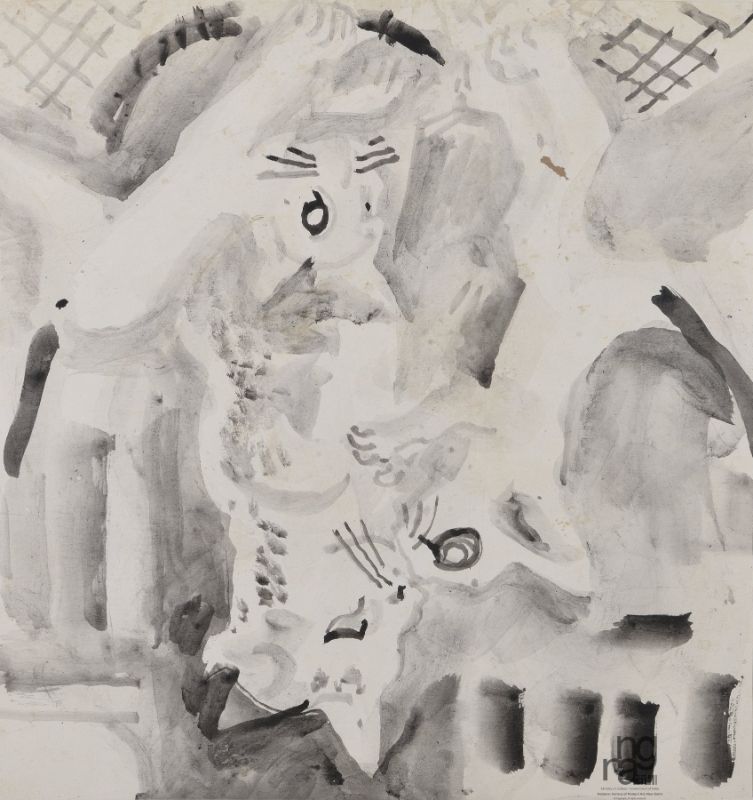 ×A abstract painting in watercolour showing three animals in monochrome.
×A abstract painting in watercolour showing three animals in monochrome. -
Life Study
 ×A sketch of a seated woman with her gaze downwards lost in her thoughts.
×A sketch of a seated woman with her gaze downwards lost in her thoughts. -
Life Study
 ×Ramkinkar Baij selected images for his sculptures and paintings from his rural surroundings. The poor and the downtrodden figured primarily as his subjects. His work is characterized by tremendous energy, dynamism and the use of earthy colours. In this sketch, the artist has depicted a female figure, rendered with fluid, fine lines of pen and ink delineating the form.
×Ramkinkar Baij selected images for his sculptures and paintings from his rural surroundings. The poor and the downtrodden figured primarily as his subjects. His work is characterized by tremendous energy, dynamism and the use of earthy colours. In this sketch, the artist has depicted a female figure, rendered with fluid, fine lines of pen and ink delineating the form. -
Life Study
 ×Ramkinkar Baij selected images for his sculptors and paintings from his rural surroundings. The poor and the downtrodden figured primarily as his subjects. His work is characterized by tremendous energy, dynamism and the use of earthy colours. In this sketch, the artist has depicted a woman in a sitting position, rendered with fluid, bold ink strokes delineating the form.
×Ramkinkar Baij selected images for his sculptors and paintings from his rural surroundings. The poor and the downtrodden figured primarily as his subjects. His work is characterized by tremendous energy, dynamism and the use of earthy colours. In this sketch, the artist has depicted a woman in a sitting position, rendered with fluid, bold ink strokes delineating the form. -
Life Study
 ×Ramkinkar Baij was a reclusive modernist artist who always remained on the fringes of the art market. He took a great interest in human figures, body language and in the general human drama. Modern Western art and pre and post-classical Indian art were his main points of reference. Although primarily known for his expressionistic sculpture, he was also a gifted painter. The sense of rhythm that his sculpture was noted for is manifested brilliantly in his paintings and sketches. His works in the Kalighat tradition interconnected with Cubism to achieve an unusual personal idiom. Both his sculpture and his paintings are unprompted and bold.
×Ramkinkar Baij was a reclusive modernist artist who always remained on the fringes of the art market. He took a great interest in human figures, body language and in the general human drama. Modern Western art and pre and post-classical Indian art were his main points of reference. Although primarily known for his expressionistic sculpture, he was also a gifted painter. The sense of rhythm that his sculpture was noted for is manifested brilliantly in his paintings and sketches. His works in the Kalighat tradition interconnected with Cubism to achieve an unusual personal idiom. Both his sculpture and his paintings are unprompted and bold. -
Life Study
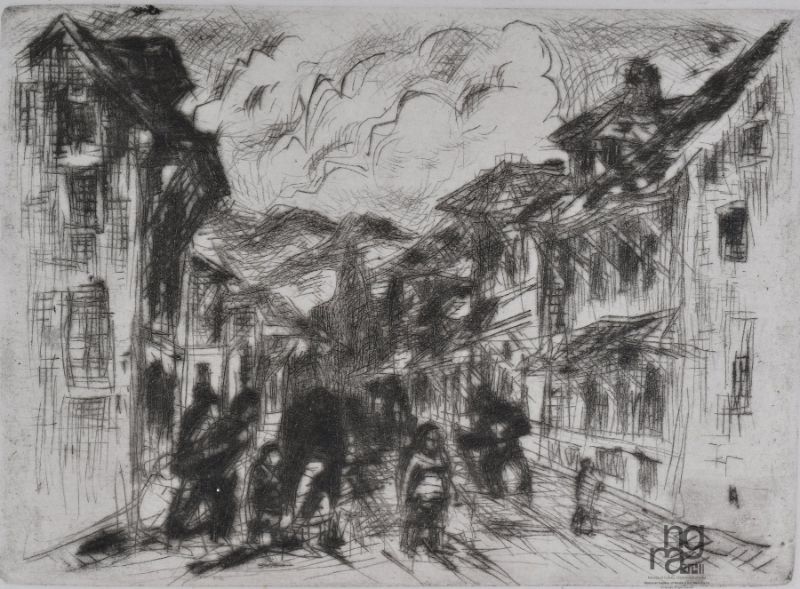 ×Ramkinkar Baijís artistic temperament was defined at Santiniketan an art institution known for providing an informed western modernistic environment to the students. Baij was immensely influenced by his austere surroundings, the ordinary people and nature that became the subject matter for painting, sculpture and printmaking. The above print depicts a view of a hills station. The composition is rendered with linear, firm yet fluid strokes incised on to a metal sheet. The lines are then transferred on the plain surface with the help of ink delineating the contours and suggesting the demeanour of the subject.
×Ramkinkar Baijís artistic temperament was defined at Santiniketan an art institution known for providing an informed western modernistic environment to the students. Baij was immensely influenced by his austere surroundings, the ordinary people and nature that became the subject matter for painting, sculpture and printmaking. The above print depicts a view of a hills station. The composition is rendered with linear, firm yet fluid strokes incised on to a metal sheet. The lines are then transferred on the plain surface with the help of ink delineating the contours and suggesting the demeanour of the subject. -
Life Study
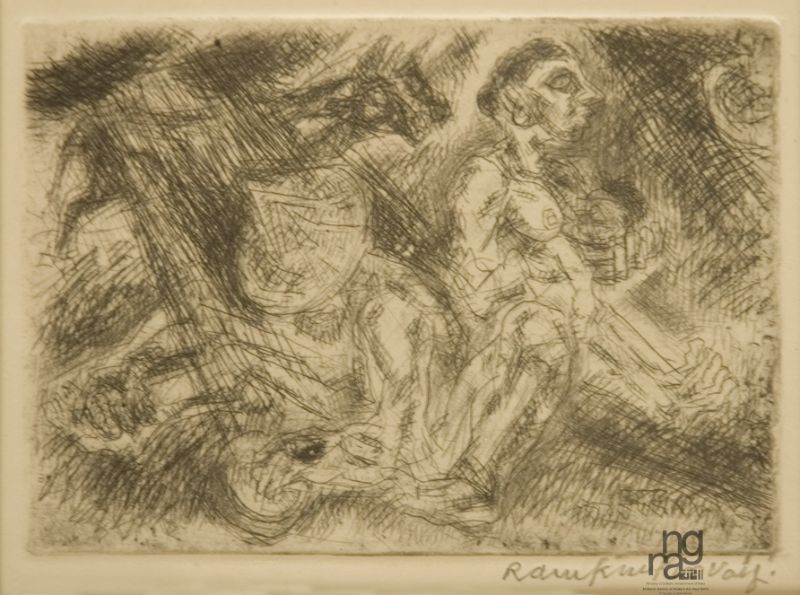 ×Ramkinkar Baijís artistic temperament was defined at Santiniketan an art institution known for providing an informed western modernistic environment to the students. Baij was immensely influenced by his austere surroundings, the ordinary people and nature that became the subject matter for painting, sculpture and printmaking. The above print depicts a poor, impoverished family. The composition is rendered with linear, firm yet fluid strokes incised on to a metal sheet. The lines are then transferred on the plain surface with the help of ink delineating the contours and suggesting the demeanour of the subjects.
×Ramkinkar Baijís artistic temperament was defined at Santiniketan an art institution known for providing an informed western modernistic environment to the students. Baij was immensely influenced by his austere surroundings, the ordinary people and nature that became the subject matter for painting, sculpture and printmaking. The above print depicts a poor, impoverished family. The composition is rendered with linear, firm yet fluid strokes incised on to a metal sheet. The lines are then transferred on the plain surface with the help of ink delineating the contours and suggesting the demeanour of the subjects. -
Life Study
 ×Ramkinkar Baijís artistic temperament was defined at Santiniketan an art institution known for providing an informed western modernistic environment to the students. Baij was immensely influenced by his austere surroundings, the ordinary people and nature that became the subject matter for painting, sculpture and printmaking. The above print depicts a playful time between a mother and a child on a charpoy. The composition is rendered with linear, firm yet fluid strokes incised on to a metal sheet. The lines are then transferred on the plain surface with the help of ink delineating the contours and suggesting the demeanour of the subjects.
×Ramkinkar Baijís artistic temperament was defined at Santiniketan an art institution known for providing an informed western modernistic environment to the students. Baij was immensely influenced by his austere surroundings, the ordinary people and nature that became the subject matter for painting, sculpture and printmaking. The above print depicts a playful time between a mother and a child on a charpoy. The composition is rendered with linear, firm yet fluid strokes incised on to a metal sheet. The lines are then transferred on the plain surface with the help of ink delineating the contours and suggesting the demeanour of the subjects. -
Life Study
 ×An etched print depicting the artist (probably himself) with his muse or model on a stroll around the garden.
×An etched print depicting the artist (probably himself) with his muse or model on a stroll around the garden. -
Life Study
 ×Ramkinkar Baijís artistic temperament was defined at Santiniketan an art institution known for providing an informed western modernistic environment to the students. Baij was immensely influenced by his austere surroundings, the ordinary people and nature that became the subject matter for painting, sculpture and printmaking. The above print depicts the family of a farmer working on a field with a bullock cart. The composition is rendered with linear, firm yet fluid strokes incised on to a metal sheet. The lines are then transferred on the plain surface with the help of ink delineating the contours and suggesting the demeanour of the figures.
×Ramkinkar Baijís artistic temperament was defined at Santiniketan an art institution known for providing an informed western modernistic environment to the students. Baij was immensely influenced by his austere surroundings, the ordinary people and nature that became the subject matter for painting, sculpture and printmaking. The above print depicts the family of a farmer working on a field with a bullock cart. The composition is rendered with linear, firm yet fluid strokes incised on to a metal sheet. The lines are then transferred on the plain surface with the help of ink delineating the contours and suggesting the demeanour of the figures. -
Life Study
 ×Ramkinkar Baijís artistic temperament was defined at Santiniketan an art institution known for providing an informed western modernistic environment to the students. Baij was immensely influenced by his austere surroundings, the ordinary people and nature that became the subject matter for painting, sculpture and printmaking. The above print depicts farmers harvesting crops. The composition is rendered with linear, firm yet fluid strokes incised on to a metal sheet. The lines are then transferred on the plain surface with the help of ink delineating the contours and suggesting the demeanour of the subject.
×Ramkinkar Baijís artistic temperament was defined at Santiniketan an art institution known for providing an informed western modernistic environment to the students. Baij was immensely influenced by his austere surroundings, the ordinary people and nature that became the subject matter for painting, sculpture and printmaking. The above print depicts farmers harvesting crops. The composition is rendered with linear, firm yet fluid strokes incised on to a metal sheet. The lines are then transferred on the plain surface with the help of ink delineating the contours and suggesting the demeanour of the subject. -
Life Study
 ×Ramkinkar Baijís artistic temperament was defined at Santiniketan an art institution known for providing an informed western modernistic environment to the students. Baij was immensely influenced by his austere surroundings, the ordinary people and nature that became the subject matter for painting, sculpture and printmaking. The above print depicts a figure overpowering the other. The composition is rendered with linear, firm yet fluid strokes incised on to a metal sheet. The lines are then transferred on the plain surface with the help of ink delineating the contours and suggesting the demeanour of the subjects.
×Ramkinkar Baijís artistic temperament was defined at Santiniketan an art institution known for providing an informed western modernistic environment to the students. Baij was immensely influenced by his austere surroundings, the ordinary people and nature that became the subject matter for painting, sculpture and printmaking. The above print depicts a figure overpowering the other. The composition is rendered with linear, firm yet fluid strokes incised on to a metal sheet. The lines are then transferred on the plain surface with the help of ink delineating the contours and suggesting the demeanour of the subjects. -
Life Study
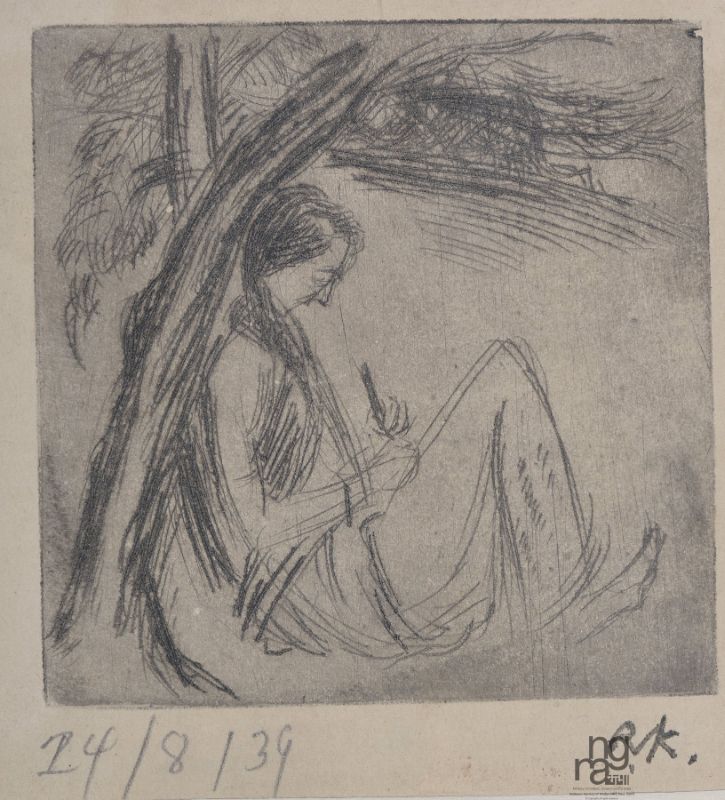 ×Ramkinkar Baijís artistic temperament was defined at Santiniketan, an art institution known for providing an informed western modernistic environment to the students. Baij was immensely influenced by his austere surroundings, the ordinary people and nature that became the subject matter for painting and sculpture. In this sketch, he has depicted a boy sitting under a tree and writing with a pen, rendered with fluid, fine strokes of pencil delineating the form.
×Ramkinkar Baijís artistic temperament was defined at Santiniketan, an art institution known for providing an informed western modernistic environment to the students. Baij was immensely influenced by his austere surroundings, the ordinary people and nature that became the subject matter for painting and sculpture. In this sketch, he has depicted a boy sitting under a tree and writing with a pen, rendered with fluid, fine strokes of pencil delineating the form. -
Life Study
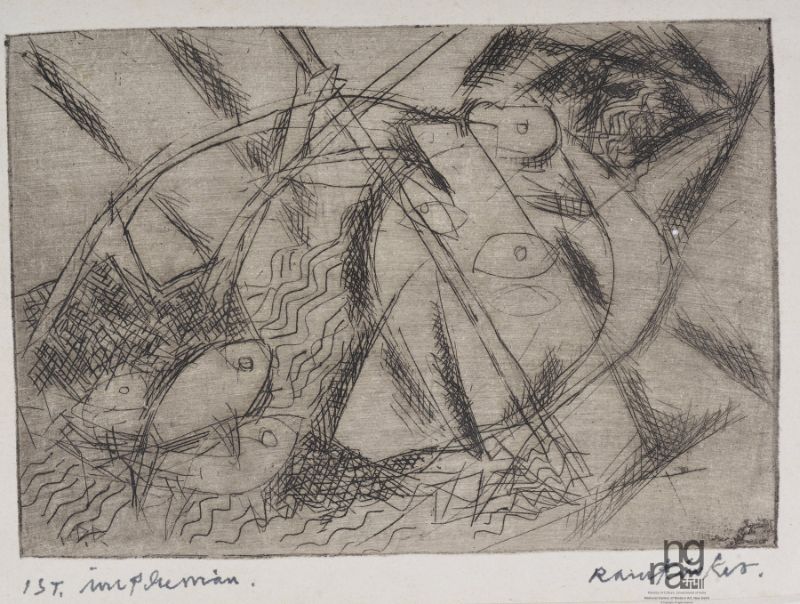 ×Ramkinkar Baijís artistic temperament was defined at Santiniketan an art institution known for providing an informed western modernistic environment to the students. Baij was immensely influenced by his austere surroundings, the ordinary people and nature that became the subject matter for painting, sculpture and printmaking. The above print depicts the scene of fishing where fishes have been captured in the fishing reel. The composition is rendered with linear, firm yet fluid strokes incised on to a metal sheet. The lines are then transferred on the plain surface with the help of ink delineating the forms and suggesting the demeanour of the subject.
×Ramkinkar Baijís artistic temperament was defined at Santiniketan an art institution known for providing an informed western modernistic environment to the students. Baij was immensely influenced by his austere surroundings, the ordinary people and nature that became the subject matter for painting, sculpture and printmaking. The above print depicts the scene of fishing where fishes have been captured in the fishing reel. The composition is rendered with linear, firm yet fluid strokes incised on to a metal sheet. The lines are then transferred on the plain surface with the help of ink delineating the forms and suggesting the demeanour of the subject. -
Life Study
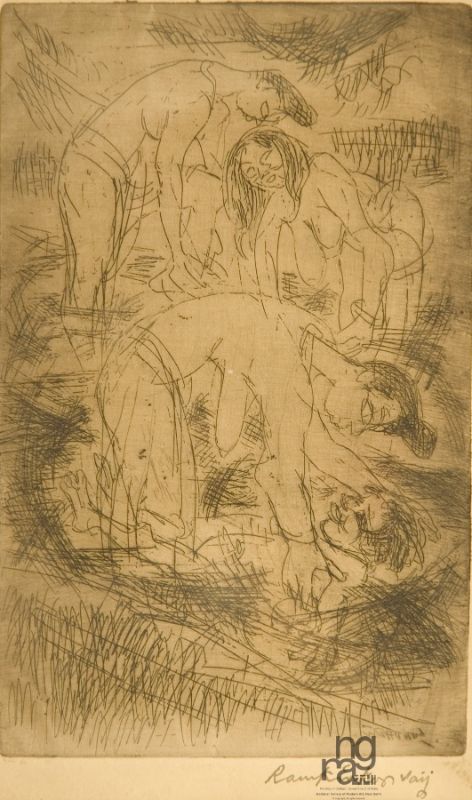 ×Ramkinker Baijís artistic temperament was defined at Santiniketan an art institution known for providing an informed western modernistic environment to the students. Baij was immensely influenced by his austere surroundings, the ordinary people and nature that became the subject matter for painting, sculpture and printmaking. The above print depicts mothers bathing their children, rendered with linear, firm yet fluid strokes incised on to a metal sheet. The lines are then transferred on the plain surface with the help of ink delineating the contours and suggesting the demeanour of the subjects.
×Ramkinker Baijís artistic temperament was defined at Santiniketan an art institution known for providing an informed western modernistic environment to the students. Baij was immensely influenced by his austere surroundings, the ordinary people and nature that became the subject matter for painting, sculpture and printmaking. The above print depicts mothers bathing their children, rendered with linear, firm yet fluid strokes incised on to a metal sheet. The lines are then transferred on the plain surface with the help of ink delineating the contours and suggesting the demeanour of the subjects. -
Life Study
 ×Ramkinkar Baijís artistic temperament was defined at Santiniketan an art institution known for providing an informed western modernistic environment to the students. Baij was immensely influenced by his austere surroundings, the ordinary people and nature that became the subject matter for painting, sculpture and printmaking. The above print depicts a woman at her toilet surrounded with maidens. The composition is rendered with linear, firm yet fluid strokes incised on to a metal sheet. The lines are then transferred on the plain surface with the help of ink delineating the contours and suggesting the demeanour of the subject.
×Ramkinkar Baijís artistic temperament was defined at Santiniketan an art institution known for providing an informed western modernistic environment to the students. Baij was immensely influenced by his austere surroundings, the ordinary people and nature that became the subject matter for painting, sculpture and printmaking. The above print depicts a woman at her toilet surrounded with maidens. The composition is rendered with linear, firm yet fluid strokes incised on to a metal sheet. The lines are then transferred on the plain surface with the help of ink delineating the contours and suggesting the demeanour of the subject. -
Life Study
 ×Ramkinkar Baijís artistic temperament was defined at Santiniketan an art institution known for providing an informed western modernistic environment to the students. Baij was immensely influenced by his austere surroundings, the ordinary people and nature that became the subject matter for painting and sculpture. In the above sketch, the artist has depicted a sleeping dog delineated with thick, bold lines articulating the contours and suggesting its posture. The treatment is intended to exemplify an energetic and lively artistic temperament.
×Ramkinkar Baijís artistic temperament was defined at Santiniketan an art institution known for providing an informed western modernistic environment to the students. Baij was immensely influenced by his austere surroundings, the ordinary people and nature that became the subject matter for painting and sculpture. In the above sketch, the artist has depicted a sleeping dog delineated with thick, bold lines articulating the contours and suggesting its posture. The treatment is intended to exemplify an energetic and lively artistic temperament. -
Life Study
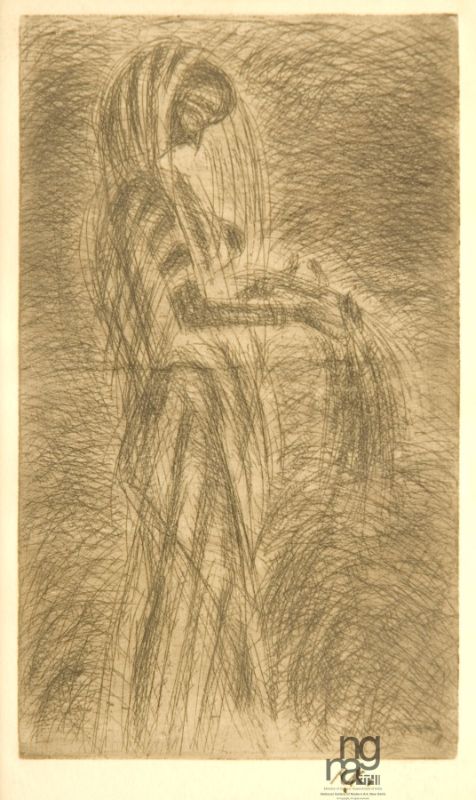 ×Ramkinkar Baijís artistic temperament was defined at Santiniketan an art institution known for providing an informed western modernistic environment to the students. Baij was immensely influenced by his austere surroundings, the ordinary people and nature that became the subject matter for painting, sculpture and printmaking. The above print depicts a woman harvesting the fields. The composition is rendered with linear, firm yet fluid strokes incised on to a metal sheet. The lines are then transferred on the plain surface with the help of ink delineating the contours and suggesting the demeanour of the subjects.†
×Ramkinkar Baijís artistic temperament was defined at Santiniketan an art institution known for providing an informed western modernistic environment to the students. Baij was immensely influenced by his austere surroundings, the ordinary people and nature that became the subject matter for painting, sculpture and printmaking. The above print depicts a woman harvesting the fields. The composition is rendered with linear, firm yet fluid strokes incised on to a metal sheet. The lines are then transferred on the plain surface with the help of ink delineating the contours and suggesting the demeanour of the subjects.† -
Life Study
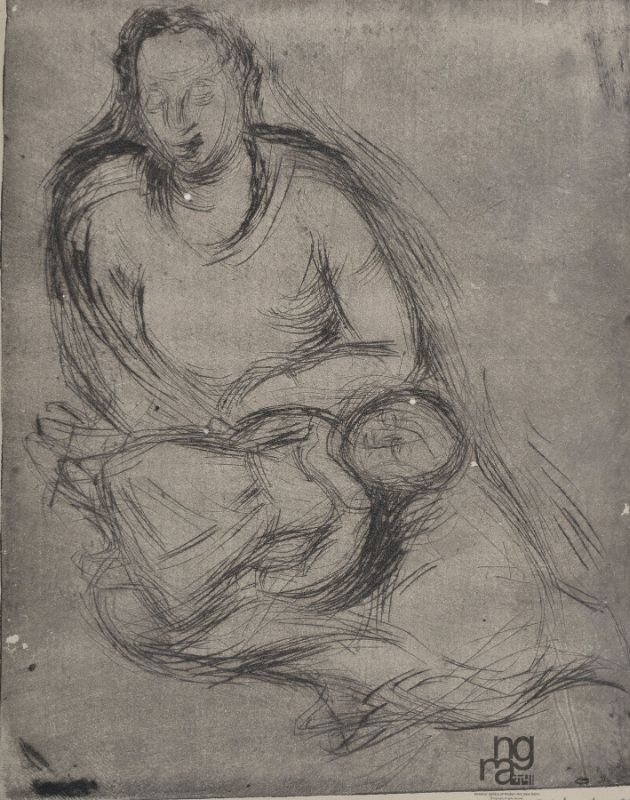 ×Ramkinkar Baijís artistic temperament was defined at Santiniketan an art institution known for providing an informed western modernistic environment to the students. Baij was immensely influenced by his austere surroundings, the ordinary people and nature that became the subject matter for painting, sculpture and printmaking. The above print depicts a mother holding her child on her lap. The composition is rendered with linear, firm yet fluid strokes incised on to a metal sheet. The lines are then transferred on the plain surface with the help of ink delineating the contours and suggesting the demeanour of the subject.
×Ramkinkar Baijís artistic temperament was defined at Santiniketan an art institution known for providing an informed western modernistic environment to the students. Baij was immensely influenced by his austere surroundings, the ordinary people and nature that became the subject matter for painting, sculpture and printmaking. The above print depicts a mother holding her child on her lap. The composition is rendered with linear, firm yet fluid strokes incised on to a metal sheet. The lines are then transferred on the plain surface with the help of ink delineating the contours and suggesting the demeanour of the subject. -
Life Study
 ×Ramkinkar Baij was a reclusive modernist artist who always remained on the fringes of the art market. He took a great interest in human figures, body language and in the general human drama. Modern Western art and pre and post-classical Indian art were his main points of reference. Although primarily known for his expressionistic sculpture, he was also a gifted painter. The sense of rhythm that his sculpture was noted for is manifested brilliantly in his paintings and sketches. His works in the Kalighat tradition interconnected with Cubism to achieve an unusual personal idiom. Both his sculpture and his paintings are unprompted and bold.
×Ramkinkar Baij was a reclusive modernist artist who always remained on the fringes of the art market. He took a great interest in human figures, body language and in the general human drama. Modern Western art and pre and post-classical Indian art were his main points of reference. Although primarily known for his expressionistic sculpture, he was also a gifted painter. The sense of rhythm that his sculpture was noted for is manifested brilliantly in his paintings and sketches. His works in the Kalighat tradition interconnected with Cubism to achieve an unusual personal idiom. Both his sculpture and his paintings are unprompted and bold. -
Life Study
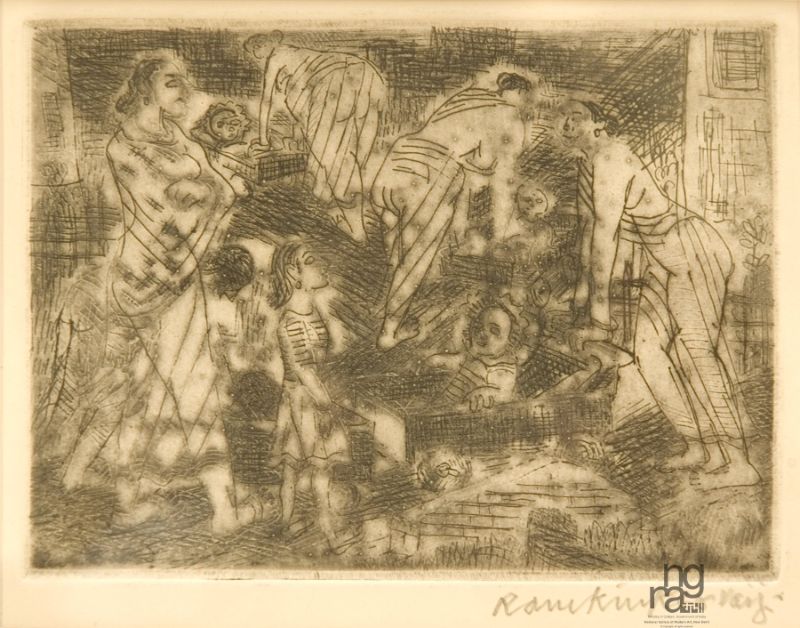 ×Ramkinkar Baijís artistic temperament was defined at Santiniketan an art institution known for providing an informed western modernistic environment to the students. Baij was immensely influenced by his austere surroundings, the ordinary people and nature that became the subject matter for painting, sculpture and printmaking. The above print depicts children playing with their attendants. The composition is rendered with linear, firm yet fluid strokes incised on to a metal sheet. The lines are then transferred on the plain surface with the help of ink delineating the contours and suggesting the demeanour of the subjects.
×Ramkinkar Baijís artistic temperament was defined at Santiniketan an art institution known for providing an informed western modernistic environment to the students. Baij was immensely influenced by his austere surroundings, the ordinary people and nature that became the subject matter for painting, sculpture and printmaking. The above print depicts children playing with their attendants. The composition is rendered with linear, firm yet fluid strokes incised on to a metal sheet. The lines are then transferred on the plain surface with the help of ink delineating the contours and suggesting the demeanour of the subjects. -
Life Study
 ×Ramkinkar Baijís artistic temperament was defined at Santiniketan an art institution known for providing an informed western modernistic environment to the students. Baij was immensely influenced by his austere surroundings, the ordinary people and nature that became the subject matter for painting, sculpture and printmaking. The above print depicts a figure overpowering the other. The composition is rendered with linear, firm yet fluid strokes incised on to a metal sheet. The lines are then transferred on the plain surface with the help of ink delineating the contours and suggesting the demeanour of the subjects.
×Ramkinkar Baijís artistic temperament was defined at Santiniketan an art institution known for providing an informed western modernistic environment to the students. Baij was immensely influenced by his austere surroundings, the ordinary people and nature that became the subject matter for painting, sculpture and printmaking. The above print depicts a figure overpowering the other. The composition is rendered with linear, firm yet fluid strokes incised on to a metal sheet. The lines are then transferred on the plain surface with the help of ink delineating the contours and suggesting the demeanour of the subjects. -
Life Study
 ×Ramkinkar Baijís artistic temperament was defined at Santiniketan an art institution known for providing an informed western modernistic environment to the students. Baij was immensely influenced by his austere surroundings, the ordinary people and nature that became the subject matter for painting, sculpture and printmaking. The above print depicts a playful time between a mother and a child lying on a charpoy. The composition is rendered with linear, firm yet fluid strokes incised on to a metal sheet. The lines are then transferred on the plain surface with the help of ink delineating the contours and suggesting the demeanour of the subjects.
×Ramkinkar Baijís artistic temperament was defined at Santiniketan an art institution known for providing an informed western modernistic environment to the students. Baij was immensely influenced by his austere surroundings, the ordinary people and nature that became the subject matter for painting, sculpture and printmaking. The above print depicts a playful time between a mother and a child lying on a charpoy. The composition is rendered with linear, firm yet fluid strokes incised on to a metal sheet. The lines are then transferred on the plain surface with the help of ink delineating the contours and suggesting the demeanour of the subjects. -
Life Study
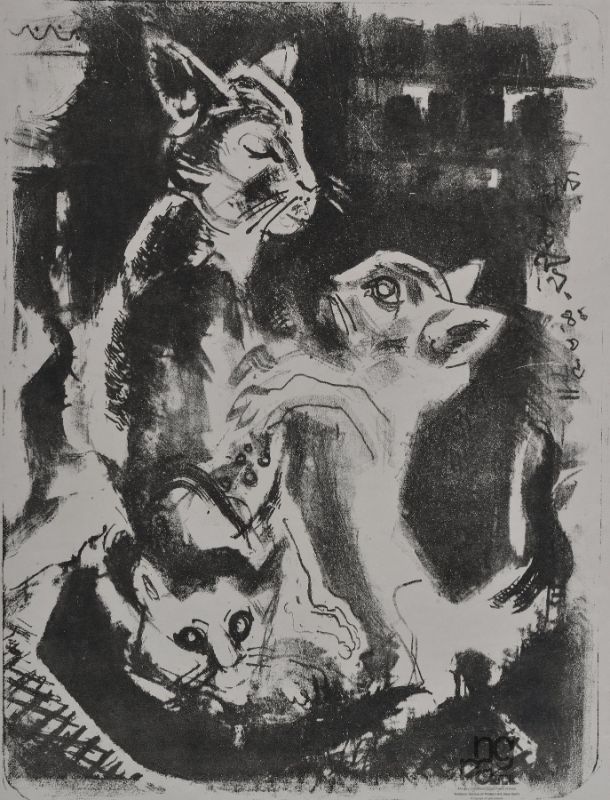 ×Ramkinkar Baij was a reclusive modernist artist who always remained on the fringes of the art market. He took a great interest in human figures, body language and in the general human drama. Modern Western art and pre and post-classical Indian art were his main points of reference. Although primarily known for his expressionistic sculpture, he was also a gifted painter. The sense of rhythm that his sculpture was noted for is manifested brilliantly in his paintings and sketches. His works in the Kalighat tradition interconnected with Cubism to achieve an unusual personal idiom. Both his sculpture and his paintings are unprompted and bold.
×Ramkinkar Baij was a reclusive modernist artist who always remained on the fringes of the art market. He took a great interest in human figures, body language and in the general human drama. Modern Western art and pre and post-classical Indian art were his main points of reference. Although primarily known for his expressionistic sculpture, he was also a gifted painter. The sense of rhythm that his sculpture was noted for is manifested brilliantly in his paintings and sketches. His works in the Kalighat tradition interconnected with Cubism to achieve an unusual personal idiom. Both his sculpture and his paintings are unprompted and bold. -
Life Study
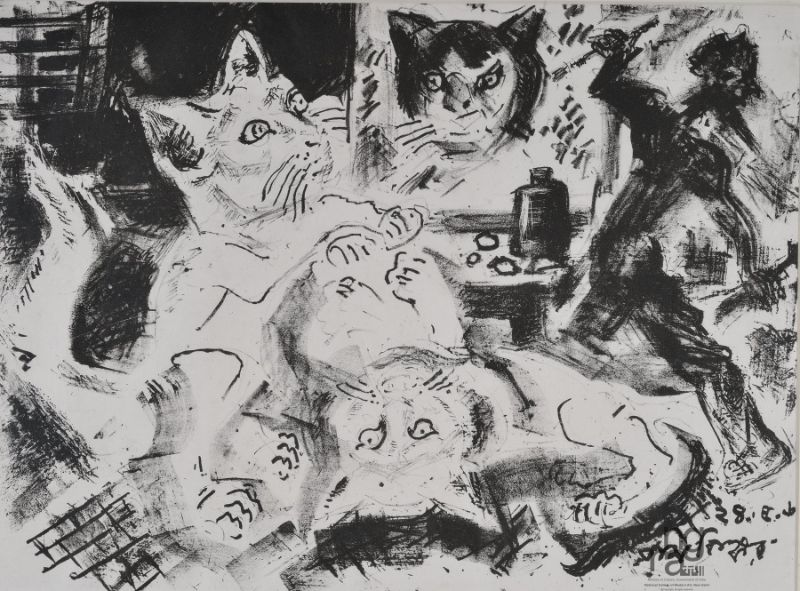 ×Ramkinkar Baijís artistic temperament was defined at Santiniketan an art institution known for providing an informed western modernistic environment to the students. Baij was immensely influenced by his austere surroundings, the ordinary people and nature that became the subject matter for painting, sculpture and printmaking. The above print depicts a cat with her kittens. The composition is rendered with linear, firm yet fluid strokes incised on to a metal sheet. The lines are then transferred on the plain surface with the help of ink delineating the basic form of an animal and suggesting the demeanour of the subject.
×Ramkinkar Baijís artistic temperament was defined at Santiniketan an art institution known for providing an informed western modernistic environment to the students. Baij was immensely influenced by his austere surroundings, the ordinary people and nature that became the subject matter for painting, sculpture and printmaking. The above print depicts a cat with her kittens. The composition is rendered with linear, firm yet fluid strokes incised on to a metal sheet. The lines are then transferred on the plain surface with the help of ink delineating the basic form of an animal and suggesting the demeanour of the subject. -
Life Study
 ×Ramkinkar Baij was immensely influenced by his austere surrounding, the ordinary people and the nature that became his subject matter for painting and sculpture. In this print, he has three cats using lithography technique.
×Ramkinkar Baij was immensely influenced by his austere surrounding, the ordinary people and the nature that became his subject matter for painting and sculpture. In this print, he has three cats using lithography technique. -
Life Study
 ×Ramkinkar Baijís artistic temperament was defined at Santiniketan an art institution known for providing an informed western modernistic environment to the students. Baij was immensely influenced by his austere surroundings, the ordinary people†and nature that became the subject matter for painting, sculpture and printmaking. The above print depicts a cat with her kittens. The composition is rendered with linear, firm yet fluid strokes incised†on to†a metal sheet. The lines are then transferred on the plain surface with the help of ink delineating the basic form of an animal and suggesting the demeanour of the subject.
×Ramkinkar Baijís artistic temperament was defined at Santiniketan an art institution known for providing an informed western modernistic environment to the students. Baij was immensely influenced by his austere surroundings, the ordinary people†and nature that became the subject matter for painting, sculpture and printmaking. The above print depicts a cat with her kittens. The composition is rendered with linear, firm yet fluid strokes incised†on to†a metal sheet. The lines are then transferred on the plain surface with the help of ink delineating the basic form of an animal and suggesting the demeanour of the subject. -
Life Study
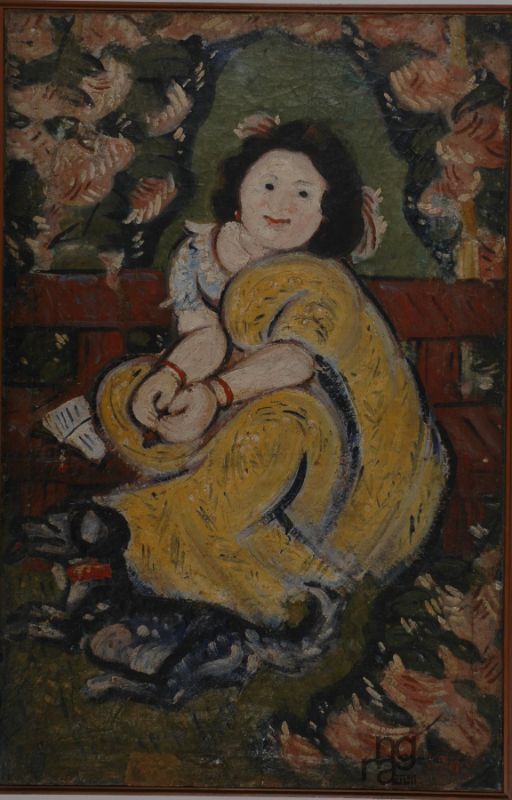 ×Ramkinkar Baij was a reclusive modernist artist who always remained on the fringes of the art market. He took a great interest in human figures, body language and in the general human drama. Modern Western art and pre and post-classical Indian art were his main points of reference. Although primarily known for his expressionistic sculpture, he was also a gifted painter. The sense of rhythm that his sculpture was noted for is manifested brilliantly in his paintings and sketches. His works in the Kalighat tradition interconnected with Cubism to achieve an unusual personal idiom. Both his sculpture and his paintings are unprompted and bold.
×Ramkinkar Baij was a reclusive modernist artist who always remained on the fringes of the art market. He took a great interest in human figures, body language and in the general human drama. Modern Western art and pre and post-classical Indian art were his main points of reference. Although primarily known for his expressionistic sculpture, he was also a gifted painter. The sense of rhythm that his sculpture was noted for is manifested brilliantly in his paintings and sketches. His works in the Kalighat tradition interconnected with Cubism to achieve an unusual personal idiom. Both his sculpture and his paintings are unprompted and bold. -
Life Study
 ×Ramkinkar Baijís artistic temperament was defined at Santiniketan an art institution known for providing an informed western modernistic environment to the students. Baij was immensely influenced by his austere surroundings, the ordinary people and nature that became the subject matter for painting and sculpture. In this abstract painting, the artist has depicted a shelter with human figures below it rendered with smudged strokes of paint, outlined with white colour to delineate the forms and suggest the†demeanour†of the subjects.
×Ramkinkar Baijís artistic temperament was defined at Santiniketan an art institution known for providing an informed western modernistic environment to the students. Baij was immensely influenced by his austere surroundings, the ordinary people and nature that became the subject matter for painting and sculpture. In this abstract painting, the artist has depicted a shelter with human figures below it rendered with smudged strokes of paint, outlined with white colour to delineate the forms and suggest the†demeanour†of the subjects. -
Life Study
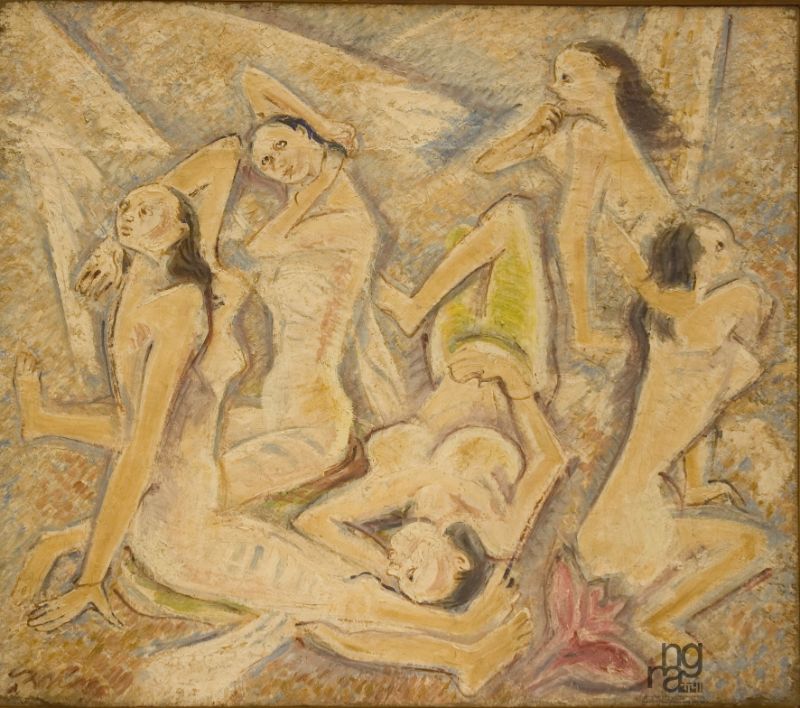 ×Ramkinkar was well aware of the post-industrial art or the modern movements in the western and eastern art scene and tried to incorporate the dynamics of such changes in his own work while keeping the Santiniketan aesthetic tradition in focus. In this abstract painting, he has depicted a group of nude figures, resting on a summer afternoon, rendered with fluid, swift brush strokes of oil colour in tonal variation creating depth in the composition.
×Ramkinkar was well aware of the post-industrial art or the modern movements in the western and eastern art scene and tried to incorporate the dynamics of such changes in his own work while keeping the Santiniketan aesthetic tradition in focus. In this abstract painting, he has depicted a group of nude figures, resting on a summer afternoon, rendered with fluid, swift brush strokes of oil colour in tonal variation creating depth in the composition. -
Life Study
 ×Ramkinkar Baij was a reclusive modernist artist who always remained on the fringes of the art market. He took a great interest in human figures, body language and in the general human drama. Modern Western art and pre and post-classical Indian art were his main points of reference. Although primarily known for his expressionistic sculpture, he was also a gifted painter. The sense of rhythm that his sculpture was noted for is manifested brilliantly in his paintings and sketches. His works in the Kalighat tradition interconnected with Cubism to achieve an unusual personal idiom. Both his sculpture and his paintings are unprompted and bold.
×Ramkinkar Baij was a reclusive modernist artist who always remained on the fringes of the art market. He took a great interest in human figures, body language and in the general human drama. Modern Western art and pre and post-classical Indian art were his main points of reference. Although primarily known for his expressionistic sculpture, he was also a gifted painter. The sense of rhythm that his sculpture was noted for is manifested brilliantly in his paintings and sketches. His works in the Kalighat tradition interconnected with Cubism to achieve an unusual personal idiom. Both his sculpture and his paintings are unprompted and bold. -
Life Study
 ×Ramkinkar Baijís artistic temperament was defined at Santiniketan an art institution known for providing an informed western modernistic environment to the students. Baij was immensely influenced by his austere surroundings, the ordinary people and nature that became the subject matter for painting and sculpture. In the above painting, the artist has depicted humans at rest, rendered with smudged coloured strokes, to delineate the forms.
×Ramkinkar Baijís artistic temperament was defined at Santiniketan an art institution known for providing an informed western modernistic environment to the students. Baij was immensely influenced by his austere surroundings, the ordinary people and nature that became the subject matter for painting and sculpture. In the above painting, the artist has depicted humans at rest, rendered with smudged coloured strokes, to delineate the forms. -
Life Study
 ×Ramkinkar Baijís artistic temperament was defined at Santiniketan an art institution known for providing an informed western modernistic environment to the students. Baij was immensely influenced by his austere surroundings, the ordinary people and nature that became the subject matter for painting and sculpture. In the above painting, the artist has depicted a traditional method of ploughing with an ox, rendered with smudged coloured strokes, to delineate†the forms.
×Ramkinkar Baijís artistic temperament was defined at Santiniketan an art institution known for providing an informed western modernistic environment to the students. Baij was immensely influenced by his austere surroundings, the ordinary people and nature that became the subject matter for painting and sculpture. In the above painting, the artist has depicted a traditional method of ploughing with an ox, rendered with smudged coloured strokes, to delineate†the forms. -
Life Study
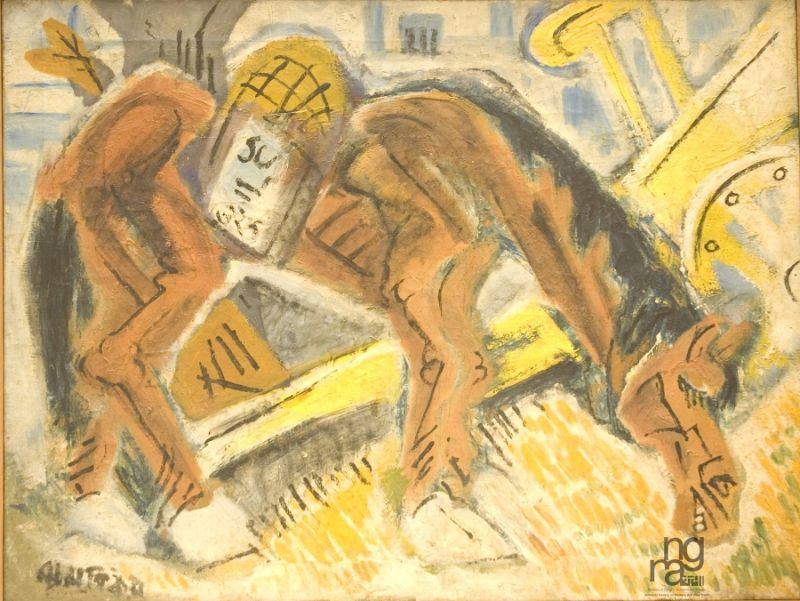 ×Ramkinkar Baijís artistic temperament was defined at Santiniketan an art institution known for providing an informed western modernistic environment to the students. Baij was immensely influenced by his austere surroundings, the ordinary people and nature that became the subject matter for painting and sculpture. In this abstract painting, the artist has depicted a horse grazing in the field. The composition is rendered with coloured smudged strokes, with blurred outline, delineating the form.
×Ramkinkar Baijís artistic temperament was defined at Santiniketan an art institution known for providing an informed western modernistic environment to the students. Baij was immensely influenced by his austere surroundings, the ordinary people and nature that became the subject matter for painting and sculpture. In this abstract painting, the artist has depicted a horse grazing in the field. The composition is rendered with coloured smudged strokes, with blurred outline, delineating the form. -
Life Study
 ×Ramkinkar was well aware of the post-industrial art or modern art movements in the western and eastern art worlds and tried to incorporate the dynamics of such changes in his own work while keeping the aesthetic tradition of Santiniketan in focus. In this abstract painting, the artist has depicted a mother by strategically rendering cubist shapes on the canvas.
×Ramkinkar was well aware of the post-industrial art or modern art movements in the western and eastern art worlds and tried to incorporate the dynamics of such changes in his own work while keeping the aesthetic tradition of Santiniketan in focus. In this abstract painting, the artist has depicted a mother by strategically rendering cubist shapes on the canvas. -
Life Study
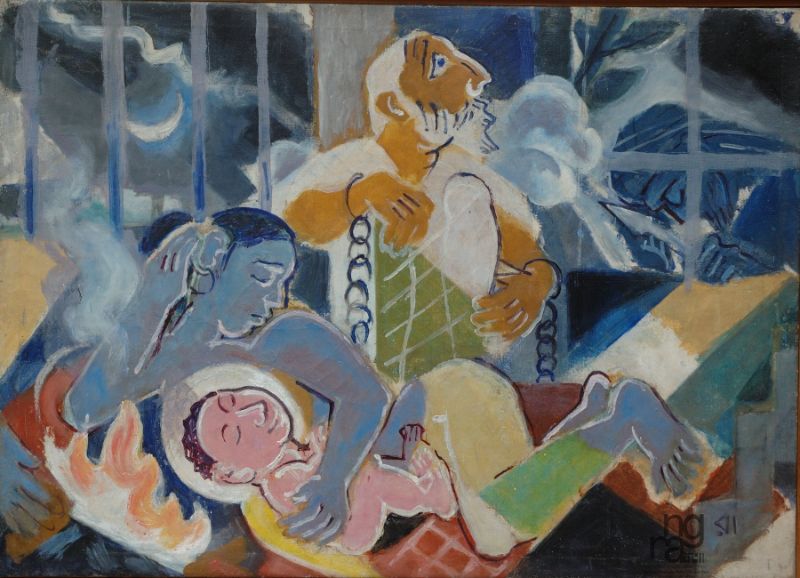 ×Ramkinkar Baij was a reclusive modernist artist who always remained on the fringes of the art market. He took a great interest in human figures, body language and in the general human drama. Modern Western art and pre and post-classical Indian art were his main points of reference. Although primarily known for his expressionistic sculpture, he was also a gifted painter. The sense of rhythm that his sculpture was noted for is manifested brilliantly in his paintings and sketches. His works in the Kalighat tradition interconnected with Cubism to achieve an unusual personal idiom. Both his sculpture and his paintings are unprompted and bold.
×Ramkinkar Baij was a reclusive modernist artist who always remained on the fringes of the art market. He took a great interest in human figures, body language and in the general human drama. Modern Western art and pre and post-classical Indian art were his main points of reference. Although primarily known for his expressionistic sculpture, he was also a gifted painter. The sense of rhythm that his sculpture was noted for is manifested brilliantly in his paintings and sketches. His works in the Kalighat tradition interconnected with Cubism to achieve an unusual personal idiom. Both his sculpture and his paintings are unprompted and bold. -
Life Study
 ×Ramkinkar Baij was a reclusive modernist artist who always remained on the fringes of the art market. He took a great interest in human figures, body language and in the general human drama. Modern Western art and pre and post-classical Indian art were his main points of reference. Although primarily known for his expressionistic sculpture, he was also a gifted painter. The sense of rhythm that his sculpture was noted for is manifested brilliantly in his paintings and sketches. His works in the Kalighat tradition interconnected with Cubism to achieve an unusual personal idiom. Both his sculpture and his paintings are unprompted and bold.
×Ramkinkar Baij was a reclusive modernist artist who always remained on the fringes of the art market. He took a great interest in human figures, body language and in the general human drama. Modern Western art and pre and post-classical Indian art were his main points of reference. Although primarily known for his expressionistic sculpture, he was also a gifted painter. The sense of rhythm that his sculpture was noted for is manifested brilliantly in his paintings and sketches. His works in the Kalighat tradition interconnected with Cubism to achieve an unusual personal idiom. Both his sculpture and his paintings are unprompted and bold. -
Life Study
 ×Ramkinkar Baij was a reclusive modernist artist who always remained on the fringes of the art market. He took a great interest in human figures, body language and in the general human drama. Modern Western art and pre and post-classical Indian art were his main points of reference. Although primarily known for his expressionistic sculpture, he was also a gifted painter. The sense of rhythm that his sculpture was noted for is manifested brilliantly in his paintings and sketches. His works in the Kalighat tradition interconnected with Cubism to achieve an unusual personal idiom. Both his sculpture and his paintings are unprompted and bold.
×Ramkinkar Baij was a reclusive modernist artist who always remained on the fringes of the art market. He took a great interest in human figures, body language and in the general human drama. Modern Western art and pre and post-classical Indian art were his main points of reference. Although primarily known for his expressionistic sculpture, he was also a gifted painter. The sense of rhythm that his sculpture was noted for is manifested brilliantly in his paintings and sketches. His works in the Kalighat tradition interconnected with Cubism to achieve an unusual personal idiom. Both his sculpture and his paintings are unprompted and bold. -
Life Study
 ×A oil on canvas in a cubist style depicting a widow with her weeping son next to her.
×A oil on canvas in a cubist style depicting a widow with her weeping son next to her. -
Life Study
 ×Ramkinkar was well aware of the post-industrial art or the modern movements in the western and eastern art scene and tried to incorporate the dynamics of such changes in his own work while keeping the Santiniketan aesthetic tradition in focus. In this painting, he has depicted a woman and a man threshing crop, rendered with the shades of oil colours delineating forms and adding depth in the composition.
×Ramkinkar was well aware of the post-industrial art or the modern movements in the western and eastern art scene and tried to incorporate the dynamics of such changes in his own work while keeping the Santiniketan aesthetic tradition in focus. In this painting, he has depicted a woman and a man threshing crop, rendered with the shades of oil colours delineating forms and adding depth in the composition. -
Life Study
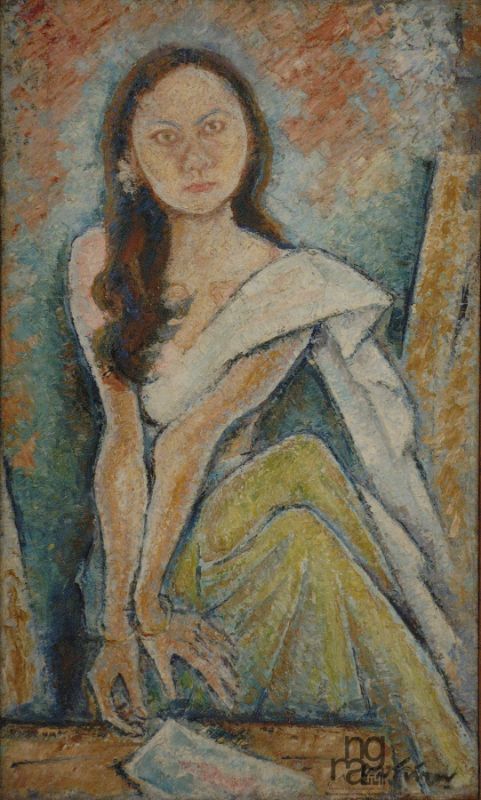 ×Ramkinkar Baij was a reclusive modernist artist who always remained on the fringes of the art market. He took a great interest in human figures, body language and in the general human drama. Modern Western art and pre and post-classical Indian art were his main points of reference. Although primarily known for his expressionistic sculpture, he was also a gifted painter. The sense of rhythm that his sculpture was noted for is manifested brilliantly in his paintings and sketches. His works in the Kalighat tradition interconnected with Cubism to achieve an unusual personal idiom. Both his sculpture and his paintings are unprompted and bold.
×Ramkinkar Baij was a reclusive modernist artist who always remained on the fringes of the art market. He took a great interest in human figures, body language and in the general human drama. Modern Western art and pre and post-classical Indian art were his main points of reference. Although primarily known for his expressionistic sculpture, he was also a gifted painter. The sense of rhythm that his sculpture was noted for is manifested brilliantly in his paintings and sketches. His works in the Kalighat tradition interconnected with Cubism to achieve an unusual personal idiom. Both his sculpture and his paintings are unprompted and bold. -
Life Study
 ×Ramkinkar Baij was immensely influenced by his austere surrounding, the ordinary people and the nature that became his subject matter for painting and sculpture. In this painting, he has depicted a woman standing in a garden, rendered with earthy colour shades, adding depth in the composition.
×Ramkinkar Baij was immensely influenced by his austere surrounding, the ordinary people and the nature that became his subject matter for painting and sculpture. In this painting, he has depicted a woman standing in a garden, rendered with earthy colour shades, adding depth in the composition. -
Life Study
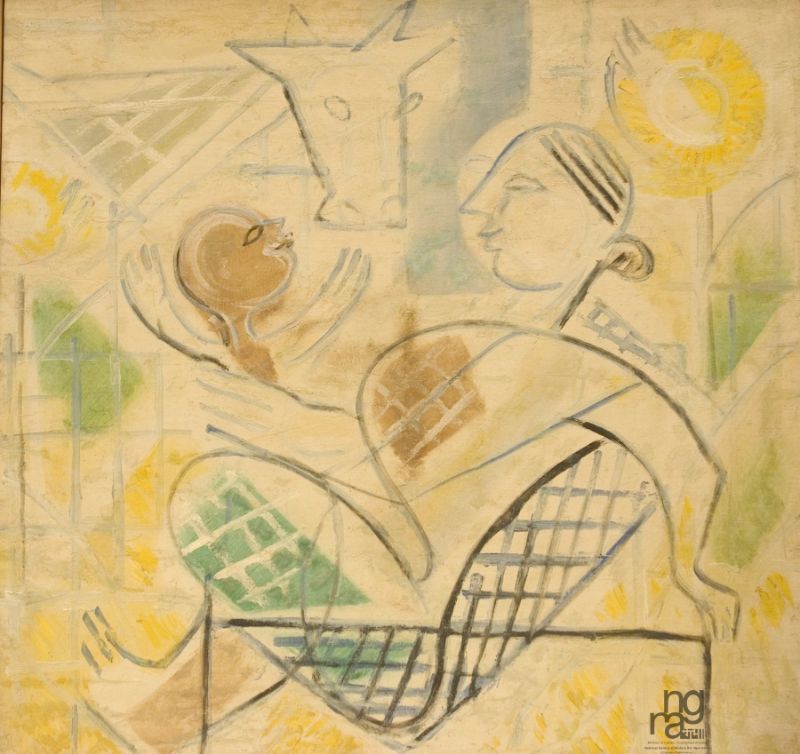 ×Ramkinkar was well aware of the post-industrial art or the modern movements in the western and eastern art worlds and tried to incorporate the dynamics of such changes in his own work while keeping the aesthetic tradition of Santiniketan †in focus. In the above paintings, the artist has depicted traditional themes of mother and child and a family†rendered with dabs and dashes of watercolour delineating the forms and suggesting the stance of the subjects.
×Ramkinkar was well aware of the post-industrial art or the modern movements in the western and eastern art worlds and tried to incorporate the dynamics of such changes in his own work while keeping the aesthetic tradition of Santiniketan †in focus. In the above paintings, the artist has depicted traditional themes of mother and child and a family†rendered with dabs and dashes of watercolour delineating the forms and suggesting the stance of the subjects. -
Life Study
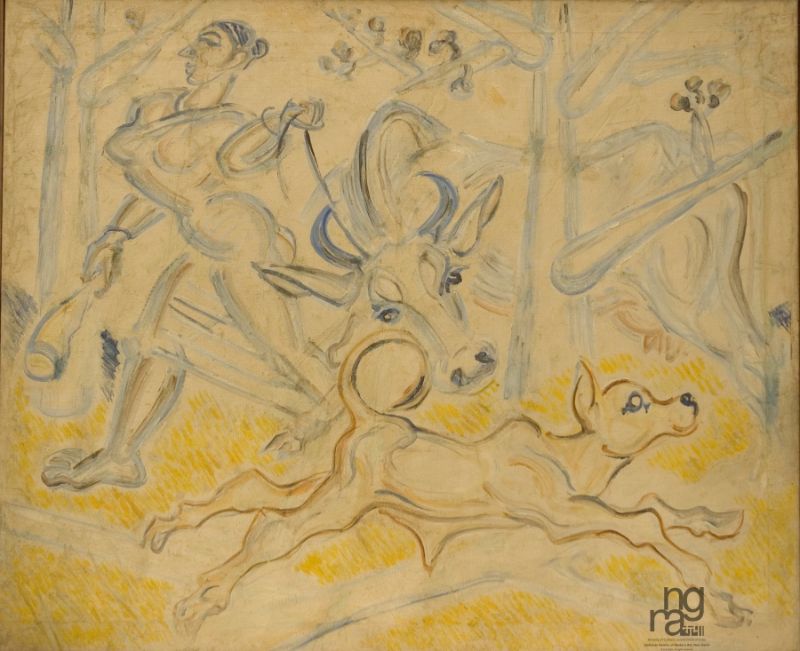 ×Ramkinkar Baij was immensely influenced by his austere surrounding, the ordinary people and the nature that became his subject matter for painting and sculpture. In this painting, he has depicted a woman with a cow to their homeward journey, rendered with swift strokes of colours and fluid, fine lines defining their contours.
×Ramkinkar Baij was immensely influenced by his austere surrounding, the ordinary people and the nature that became his subject matter for painting and sculpture. In this painting, he has depicted a woman with a cow to their homeward journey, rendered with swift strokes of colours and fluid, fine lines defining their contours. -
Life Study
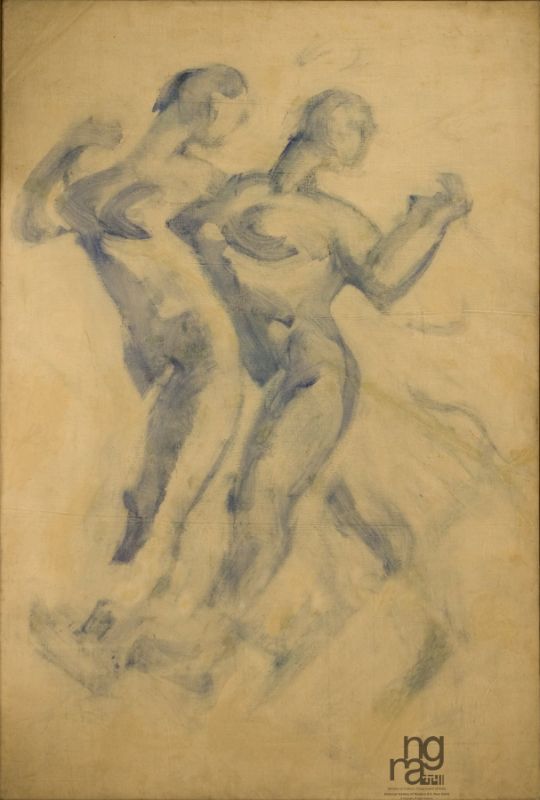 ×Ramkinkar Baij was immensely influenced by his austere surrounding, the ordinary people and the nature that became his subject matter for painting and sculpture. In this painting, he has depicted two people running on the call of a mill for work, rendered with fluid, swift strokes of oil colour in tonal variation defining the contours of their body.
×Ramkinkar Baij was immensely influenced by his austere surrounding, the ordinary people and the nature that became his subject matter for painting and sculpture. In this painting, he has depicted two people running on the call of a mill for work, rendered with fluid, swift strokes of oil colour in tonal variation defining the contours of their body. -
Life Study
 ×Ramkinkar Baij was immensely influenced by his austere surrounding, the ordinary people and the nature that became his subject matter for painting and sculpture. In this painting, he has depicted a man carrying bag and walking along the path, rendered with swift strokes of watercolor delineating the forms.
×Ramkinkar Baij was immensely influenced by his austere surrounding, the ordinary people and the nature that became his subject matter for painting and sculpture. In this painting, he has depicted a man carrying bag and walking along the path, rendered with swift strokes of watercolor delineating the forms. -
Life Study
 ×Ramkinkar Baij was a reclusive modernist artist who always remained on the fringes of the art market. He took a great interest in human figures, body language and in the general human drama. Modern Western art and pre and post-classical Indian art were his main points of reference. Although primarily known for his expressionistic sculpture, he was also a gifted painter. The sense of rhythm that his sculpture was noted for is manifested brilliantly in his paintings and sketches. His works in the Kalighat tradition interconnected with Cubism to achieve an unusual personal idiom. Both his sculpture and his paintings are unprompted and bold.
×Ramkinkar Baij was a reclusive modernist artist who always remained on the fringes of the art market. He took a great interest in human figures, body language and in the general human drama. Modern Western art and pre and post-classical Indian art were his main points of reference. Although primarily known for his expressionistic sculpture, he was also a gifted painter. The sense of rhythm that his sculpture was noted for is manifested brilliantly in his paintings and sketches. His works in the Kalighat tradition interconnected with Cubism to achieve an unusual personal idiom. Both his sculpture and his paintings are unprompted and bold. -
Life Study
 ×Ramkinkar Baij was a reclusive modernist artist who always remained on the fringes of the art market. He took a great interest in human figures, body language and in the general human drama. Modern Western art and pre and post-classical Indian art were his main points of reference. Although primarily known for his expressionistic sculpture, he was also a gifted painter. The sense of rhythm that his sculpture was noted for is manifested brilliantly in his paintings and sketches. His works in the Kalighat tradition interconnected with Cubism to achieve an unusual personal idiom. Both his sculpture and his paintings are unprompted and bold.
×Ramkinkar Baij was a reclusive modernist artist who always remained on the fringes of the art market. He took a great interest in human figures, body language and in the general human drama. Modern Western art and pre and post-classical Indian art were his main points of reference. Although primarily known for his expressionistic sculpture, he was also a gifted painter. The sense of rhythm that his sculpture was noted for is manifested brilliantly in his paintings and sketches. His works in the Kalighat tradition interconnected with Cubism to achieve an unusual personal idiom. Both his sculpture and his paintings are unprompted and bold. -
Life Study
 ×Ramkinkar Baij was a reclusive modernist artist who always remained on the fringes of the art market. He took a great interest in human figures, body language and in the general human drama. Modern Western art and pre and post-classical Indian art were his main points of reference. Although primarily known for his expressionistic sculpture, he was also a gifted painter. The sense of rhythm that his sculpture was noted for is manifested brilliantly in his paintings and sketches. His works in the Kalighat tradition interconnected with Cubism to achieve an unusual personal idiom. Both his sculpture and his paintings are unprompted and bold.
×Ramkinkar Baij was a reclusive modernist artist who always remained on the fringes of the art market. He took a great interest in human figures, body language and in the general human drama. Modern Western art and pre and post-classical Indian art were his main points of reference. Although primarily known for his expressionistic sculpture, he was also a gifted painter. The sense of rhythm that his sculpture was noted for is manifested brilliantly in his paintings and sketches. His works in the Kalighat tradition interconnected with Cubism to achieve an unusual personal idiom. Both his sculpture and his paintings are unprompted and bold. -
Life Study
 ×Ramkinkar Baij was a reclusive modernist artist who always remained on the fringes of the art market. He took a great interest in human figures, body language and in the general human drama. Modern Western art and pre and post-classical Indian art were his main points of reference. Although primarily known for his expressionistic sculpture, he was also a gifted painter. The sense of rhythm that his sculpture was noted for is manifested brilliantly in his paintings and sketches. His works in the Kalighat tradition interconnected with Cubism to achieve an unusual personal idiom. Both his sculpture and his paintings are unprompted and bold.
×Ramkinkar Baij was a reclusive modernist artist who always remained on the fringes of the art market. He took a great interest in human figures, body language and in the general human drama. Modern Western art and pre and post-classical Indian art were his main points of reference. Although primarily known for his expressionistic sculpture, he was also a gifted painter. The sense of rhythm that his sculpture was noted for is manifested brilliantly in his paintings and sketches. His works in the Kalighat tradition interconnected with Cubism to achieve an unusual personal idiom. Both his sculpture and his paintings are unprompted and bold.
-
 ××××
××××Concept Note
Virtual Tour
Ramkinkar Baij | Journey through silent transformation and expressions The Virtual Tour titled ďRamkinkar Baij | Journey through silent transformation and expressionsĒ is organized to commemorate the 115th Birth Anniversary of Ramkinkar Baij on 26th May 2020. Ramkinkar Baij, one of the most seminal artists of modern India, was an iconic sculptor, painter and graphic artist. In 1970, the Government of India honoured him with the Padma Bhushan for his irrefutable contribution to Indian art. Ramkinkar's monumental sculptures are established landmarks in public art. One of the earliest modernists in Indian art, he assimilated the idioms of the European modern visual language and yet was rooted in his own Indian ethos. He experimented restlessly with forms, moving freely from figurative to abstract and back to figurative, his themes were steeped in a deep sense of humanism and an instinctive understanding of the symbiotic relationship between man and nature. Both in his paintings and sculptures, he pushed the limits of experimentation and ventured into the use of new materials. For instance, his use of unconventional material, for the time, such as cement concrete for his monumental public sculptures set a new precedent for art practices. The NGMA takes pride in 639 works of art created by the iconic artist. This virtual tour presents the 520 works of art from the prominent artworks of Ramkinkar Baij from reserve collection of NGMA, grouped in a series of five different themes of (i) Portrait, (ii) Life Study, (iii) Abstract & Structural Composition, (iv) Nature Study & Landscape and (v) Sculptures. This virtual tour also showcases three sketch books from the collection of NGMA containing 182 works of art. I would urge our esteemed visitors to visit our web site to explore the complete works of art of Ramkinkar Baij through his silent transformation and expressions. I take pride of the tireless effort of our entire IT Cell to conceive and conceptualize the idea of launching Virtual Tours and designed and developed the same amidst lock down period to facilitate our esteemed visitors with the prestigious collection of NGMA. -
Abstract & Structural Composition
 ×Ramkinkar Baij selected images for his sculptures and paintings from his rural surroundings. The poor and the downtrodden figured primarily as his subjects. His work is characterised by tremendous energy, dynamism and the use of earthy colours. In the above painting, the artist has depicted an abstract geometric composition, rendered with fluid, fine brush strokes delineating the forms.
×Ramkinkar Baij selected images for his sculptures and paintings from his rural surroundings. The poor and the downtrodden figured primarily as his subjects. His work is characterised by tremendous energy, dynamism and the use of earthy colours. In the above painting, the artist has depicted an abstract geometric composition, rendered with fluid, fine brush strokes delineating the forms. -
Abstract & Structural Composition
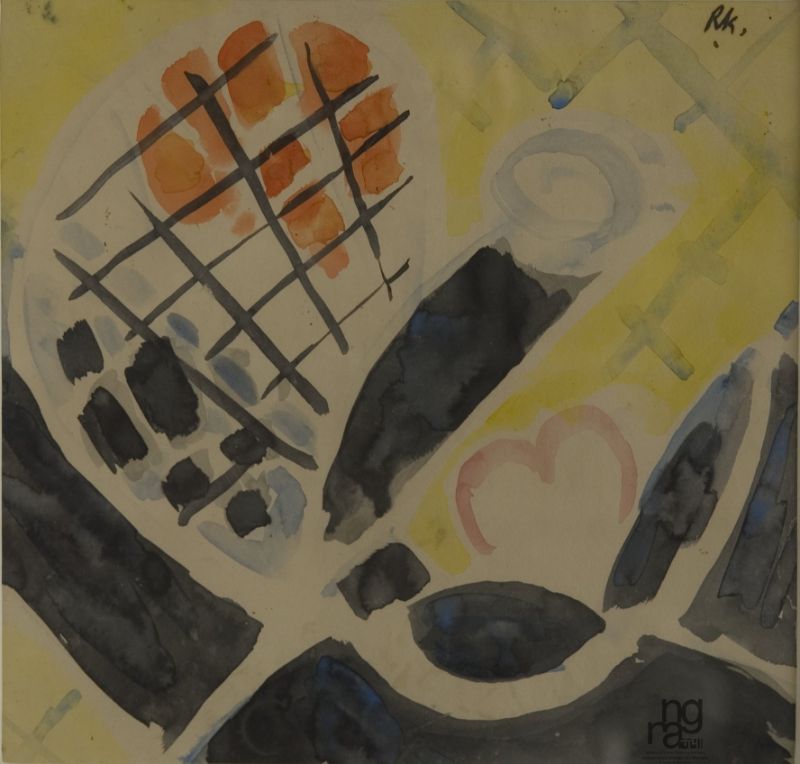 ×Ramkinkar was well aware of the post-industrial art or the modern movements in the western and eastern art scene and tried to incorporate the dynamics of such changes in his own work while keeping the Santiniketan aesthetic tradition in focus. In this abstract painting, he has composed the different shapes with dabs and dashes of watercolour delineating the forms.
×Ramkinkar was well aware of the post-industrial art or the modern movements in the western and eastern art scene and tried to incorporate the dynamics of such changes in his own work while keeping the Santiniketan aesthetic tradition in focus. In this abstract painting, he has composed the different shapes with dabs and dashes of watercolour delineating the forms. -
Abstract & Structural Composition
 ×Ramkinkar Baij was a reclusive modernist artist who always remained on the fringes of the art market. He took a great interest in human figures, body language and in the general human drama. Modern Western art and pre and post-classical Indian art were his main points of reference. Although primarily known for his expressionistic sculpture, he was also a gifted painter. The sense of rhythm that his sculpture was noted for is manifested brilliantly in his paintings and sketches. His works in the Kalighat tradition interconnected with Cubism to achieve an unusual personal idiom. Both his sculpture and his paintings are unprompted and bold.
×Ramkinkar Baij was a reclusive modernist artist who always remained on the fringes of the art market. He took a great interest in human figures, body language and in the general human drama. Modern Western art and pre and post-classical Indian art were his main points of reference. Although primarily known for his expressionistic sculpture, he was also a gifted painter. The sense of rhythm that his sculpture was noted for is manifested brilliantly in his paintings and sketches. His works in the Kalighat tradition interconnected with Cubism to achieve an unusual personal idiom. Both his sculpture and his paintings are unprompted and bold. -
Abstract & Structural Composition
 ×Ramkinkar was well aware of the post-industrial art or the modern movements in the western and eastern art scene and tried to incorporate the dynamics of such changes in his own work while keeping the Santiniketan aesthetic tradition in focus. In this monochromatic composition, he has painted different geometrical shapes with swift, fluid brush strokes of watercolour in tonal variation delineating the forms.
×Ramkinkar was well aware of the post-industrial art or the modern movements in the western and eastern art scene and tried to incorporate the dynamics of such changes in his own work while keeping the Santiniketan aesthetic tradition in focus. In this monochromatic composition, he has painted different geometrical shapes with swift, fluid brush strokes of watercolour in tonal variation delineating the forms. -
Abstract & Structural Composition
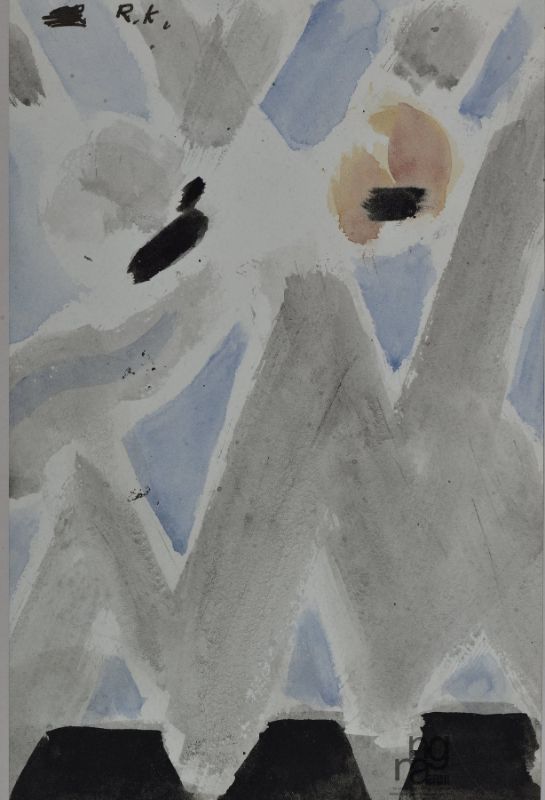 ×Ramkinkar Baij was a reclusive modernist artist who always remained on the fringes of the art market. He took a great interest in human figures, body language and in the general human drama. Modern Western art and pre and post-classical Indian art were his main points of reference. Although primarily known for his expressionistic sculpture, he was also a gifted painter. The sense of rhythm that his sculpture was noted for is manifested brilliantly in his paintings and sketches. His works in the Kalighat tradition interconnected with Cubism to achieve an unusual personal idiom. Both his sculpture and his paintings are unprompted and bold.
×Ramkinkar Baij was a reclusive modernist artist who always remained on the fringes of the art market. He took a great interest in human figures, body language and in the general human drama. Modern Western art and pre and post-classical Indian art were his main points of reference. Although primarily known for his expressionistic sculpture, he was also a gifted painter. The sense of rhythm that his sculpture was noted for is manifested brilliantly in his paintings and sketches. His works in the Kalighat tradition interconnected with Cubism to achieve an unusual personal idiom. Both his sculpture and his paintings are unprompted and bold. -
Abstract & Structural Composition

An Abstract Composition Acc. No. 4291 | Watercolor on Paper
-
Abstract & Structural Composition
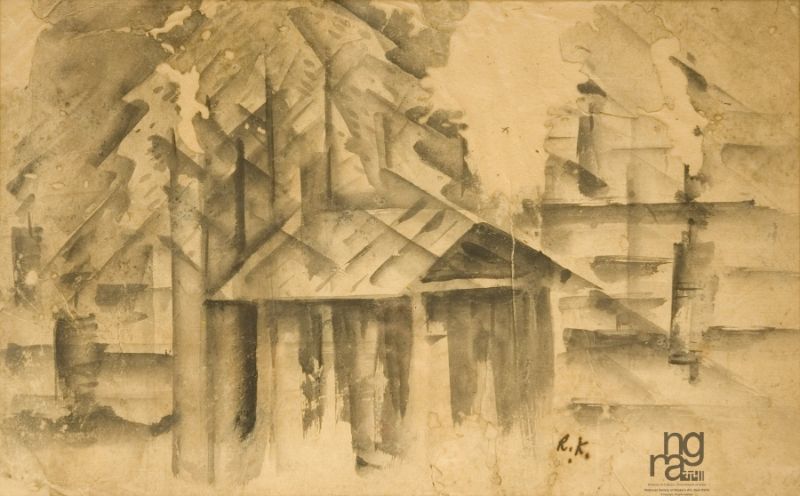 ×Ramkinkar Baij selected images for his sculptors and paintings from his rural surroundings. The poor and the downtrodden figured primarily as his subjects. Baij's watercolours mostly reflect his preoccupation with nature and the animal world. His work is characterized by tremendous energy, dynamism and the use of earthy colours. In the above painting, the artist has made a structural composition of a landscape with a hut in the foreground, rendered with fluid, fine brush strokes delineating the form.
×Ramkinkar Baij selected images for his sculptors and paintings from his rural surroundings. The poor and the downtrodden figured primarily as his subjects. Baij's watercolours mostly reflect his preoccupation with nature and the animal world. His work is characterized by tremendous energy, dynamism and the use of earthy colours. In the above painting, the artist has made a structural composition of a landscape with a hut in the foreground, rendered with fluid, fine brush strokes delineating the form. -
Abstract & Structural Composition
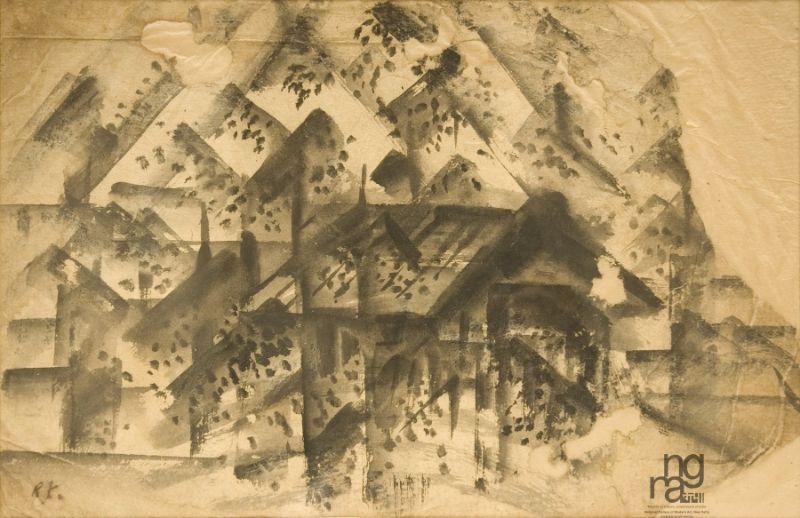 ×Ramkinkar Baij selected images for his sculptors and paintings from his rural surroundings. The poor and the downtrodden figured primarily as his subjects. Baij's watercolours mostly reflect his preoccupation with nature and the animal world. His work is characterized by tremendous energy, dynamism and the use of earthy colours. In the above painting, the artist has made a structural composition of a landscape with huts in the foreground, rendered with fluid, fine brush strokes delineating the form.
×Ramkinkar Baij selected images for his sculptors and paintings from his rural surroundings. The poor and the downtrodden figured primarily as his subjects. Baij's watercolours mostly reflect his preoccupation with nature and the animal world. His work is characterized by tremendous energy, dynamism and the use of earthy colours. In the above painting, the artist has made a structural composition of a landscape with huts in the foreground, rendered with fluid, fine brush strokes delineating the form. -
Abstract & Structural Composition
 ×Ramkinkar Baij selected images for his sculptors and paintings from his rural surroundings. The poor and the downtrodden figured primarily as his subjects. Baij's watercolours mostly reflect his preoccupation with nature and the animal world. His work is characterized by tremendous energy, dynamism and the use of earthy colours. In the above painting, the artist has made a structural composition of a landscape, rendered with fluid, fine brush strokes delineating the form.
×Ramkinkar Baij selected images for his sculptors and paintings from his rural surroundings. The poor and the downtrodden figured primarily as his subjects. Baij's watercolours mostly reflect his preoccupation with nature and the animal world. His work is characterized by tremendous energy, dynamism and the use of earthy colours. In the above painting, the artist has made a structural composition of a landscape, rendered with fluid, fine brush strokes delineating the form. -
Abstract & Structural Composition
 ×Ramkinkar Baij selected images for his sculptors and paintings from his rural surroundings. The poor and the downtrodden figured primarily as his subjects. Baij's watercolours mostly reflect his preoccupation with nature and the animal world. His work is characterized by tremendous energy, dynamism and the use of earthy colours. In the above painting, the artist has made a structural composition of a landscape, rendered with fluid, fine brush strokes delineating the form.
×Ramkinkar Baij selected images for his sculptors and paintings from his rural surroundings. The poor and the downtrodden figured primarily as his subjects. Baij's watercolours mostly reflect his preoccupation with nature and the animal world. His work is characterized by tremendous energy, dynamism and the use of earthy colours. In the above painting, the artist has made a structural composition of a landscape, rendered with fluid, fine brush strokes delineating the form. -
Abstract & Structural Composition
 ×Ramkinkar was well aware of the post-industrial art or modern art movements in the western and eastern art worlds and tried to incorporate the dynamics of such changes in his own work while keeping the aesthetic tradition of Santiniketan in focus. In this abstract painting, he has rendered a geometric composition with dabs and dashes of watercolour delineating the forms.
×Ramkinkar was well aware of the post-industrial art or modern art movements in the western and eastern art worlds and tried to incorporate the dynamics of such changes in his own work while keeping the aesthetic tradition of Santiniketan in focus. In this abstract painting, he has rendered a geometric composition with dabs and dashes of watercolour delineating the forms. -
Abstract & Structural Composition
 ×Ramkinkar Baij selected images for his sculptures and paintings from his rural surroundings. The poor and the downtrodden figured primarily as his subjects. His work is characterised by tremendous energy, dynamism and the use of earthy colours. In the above painting, the artist has depicted an abstract composition, rendered with fluid, fine brush strokes delineating the form.
×Ramkinkar Baij selected images for his sculptures and paintings from his rural surroundings. The poor and the downtrodden figured primarily as his subjects. His work is characterised by tremendous energy, dynamism and the use of earthy colours. In the above painting, the artist has depicted an abstract composition, rendered with fluid, fine brush strokes delineating the form. -
Abstract & Structural Composition
 ×Ramkinkar Baij selected images for his sculptors and paintings from his rural surroundings. The poor and the downtrodden figured primarily as his subjects. Baij's watercolours mostly reflect his preoccupation with nature and the animal world. His work is characterized by tremendous energy, dynamism and the use of earthy colours. In the above painting, the artist has made a structural composition of a landscape, rendered with fluid, fine brush strokes delineating the form.
×Ramkinkar Baij selected images for his sculptors and paintings from his rural surroundings. The poor and the downtrodden figured primarily as his subjects. Baij's watercolours mostly reflect his preoccupation with nature and the animal world. His work is characterized by tremendous energy, dynamism and the use of earthy colours. In the above painting, the artist has made a structural composition of a landscape, rendered with fluid, fine brush strokes delineating the form. -
Abstract & Structural Composition
 ×Ramkinkar Baij was a reclusive modernist artist who always remained on the fringes of the art market. He took a great interest in human figures, body language and in the general human drama. Modern Western art and pre and post-classical Indian art were his main points of reference. Although primarily known for his expressionistic sculpture, he was also a gifted painter. The sense of rhythm that his sculpture was noted for is manifested brilliantly in his paintings and sketches. His works in the Kalighat tradition interconnected with Cubism to achieve an unusual personal idiom. Both his sculpture and his paintings are unprompted and bold.
×Ramkinkar Baij was a reclusive modernist artist who always remained on the fringes of the art market. He took a great interest in human figures, body language and in the general human drama. Modern Western art and pre and post-classical Indian art were his main points of reference. Although primarily known for his expressionistic sculpture, he was also a gifted painter. The sense of rhythm that his sculpture was noted for is manifested brilliantly in his paintings and sketches. His works in the Kalighat tradition interconnected with Cubism to achieve an unusual personal idiom. Both his sculpture and his paintings are unprompted and bold. -
Abstract & Structural Composition
 ×Ramkinkar was well aware of the post-industrial art or modern art movements in the western and eastern art worlds and tried to incorporate the dynamics of such changes in his own work while keeping the aesthetic tradition of Santiniketan in focus. In this abstract painting, he has composed different shapes with dabs and dashes of watercolour delineating the forms.
×Ramkinkar was well aware of the post-industrial art or modern art movements in the western and eastern art worlds and tried to incorporate the dynamics of such changes in his own work while keeping the aesthetic tradition of Santiniketan in focus. In this abstract painting, he has composed different shapes with dabs and dashes of watercolour delineating the forms. -
Abstract & Structural Composition
 ×Ramkinkar was well aware of the post-industrial art or modern art movements in the western and eastern art worlds and tried to incorporate the dynamics of such changes in his own work while keeping the aesthetic tradition of Santiniketan in focus. In this abstract painting, he has composed different forms by strategically placing shapes on the canvas.
×Ramkinkar was well aware of the post-industrial art or modern art movements in the western and eastern art worlds and tried to incorporate the dynamics of such changes in his own work while keeping the aesthetic tradition of Santiniketan in focus. In this abstract painting, he has composed different forms by strategically placing shapes on the canvas. -
Abstract & Structural Composition
 ×Ramkinkar Baij was a reclusive modernist artist who always remained on the fringes of the art market. He took a great interest in human figures, body language and in the general human drama. Modern Western art and pre and post-classical Indian art were his main points of reference. Although primarily known for his expressionistic sculpture, he was also a gifted painter. The sense of rhythm that his sculpture was noted for is manifested brilliantly in his paintings and sketches. His works in the Kalighat tradition interconnected with Cubism to achieve an unusual personal idiom. Both his sculpture and his paintings are unprompted and bold.
×Ramkinkar Baij was a reclusive modernist artist who always remained on the fringes of the art market. He took a great interest in human figures, body language and in the general human drama. Modern Western art and pre and post-classical Indian art were his main points of reference. Although primarily known for his expressionistic sculpture, he was also a gifted painter. The sense of rhythm that his sculpture was noted for is manifested brilliantly in his paintings and sketches. His works in the Kalighat tradition interconnected with Cubism to achieve an unusual personal idiom. Both his sculpture and his paintings are unprompted and bold. -
Abstract & Structural Composition
 ×Ramkinkar was well aware of the post-industrial art or modern art movements in the western and eastern art worlds and tried to incorporate the dynamics of such changes in his own work while keeping the aesthetic tradition of Santiniketan in focus. In this abstract painting the artist has rendered human figures by strategically placing cubist forms on the canvas.
×Ramkinkar was well aware of the post-industrial art or modern art movements in the western and eastern art worlds and tried to incorporate the dynamics of such changes in his own work while keeping the aesthetic tradition of Santiniketan in focus. In this abstract painting the artist has rendered human figures by strategically placing cubist forms on the canvas. -
Abstract & Structural Composition
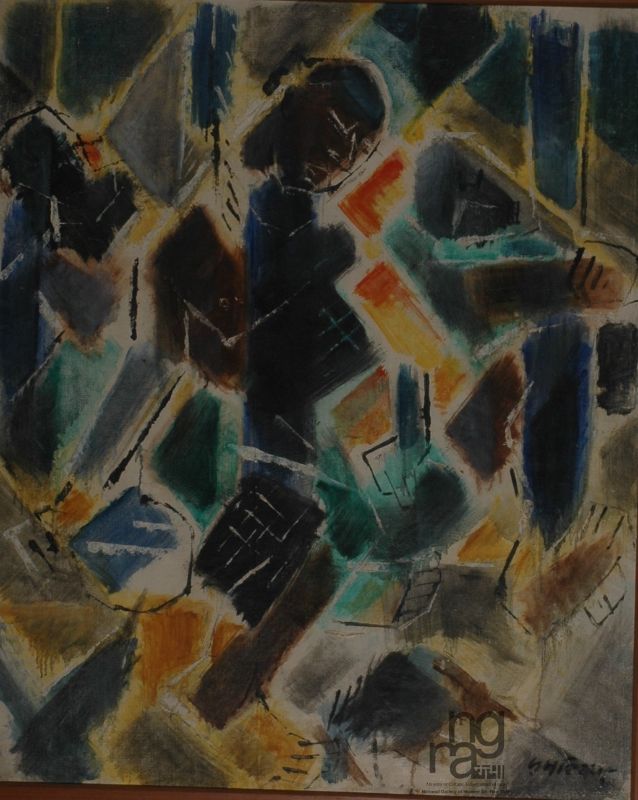 ×Ramkinkar Baij was a reclusive modernist artist who always remained on the fringes of the art market. He took a great interest in human figures, body language and in the general human drama. Modern Western art and pre and post-classical Indian art were his main points of reference. Although primarily known for his expressionistic sculpture, he was also a gifted painter. The sense of rhythm that his sculpture was noted for is manifested brilliantly in his paintings and sketches. His works in the Kalighat tradition interconnected with Cubism to achieve an unusual personal idiom. Both his sculpture and his paintings are unprompted and bold.
×Ramkinkar Baij was a reclusive modernist artist who always remained on the fringes of the art market. He took a great interest in human figures, body language and in the general human drama. Modern Western art and pre and post-classical Indian art were his main points of reference. Although primarily known for his expressionistic sculpture, he was also a gifted painter. The sense of rhythm that his sculpture was noted for is manifested brilliantly in his paintings and sketches. His works in the Kalighat tradition interconnected with Cubism to achieve an unusual personal idiom. Both his sculpture and his paintings are unprompted and bold. -
Abstract & Structural Composition
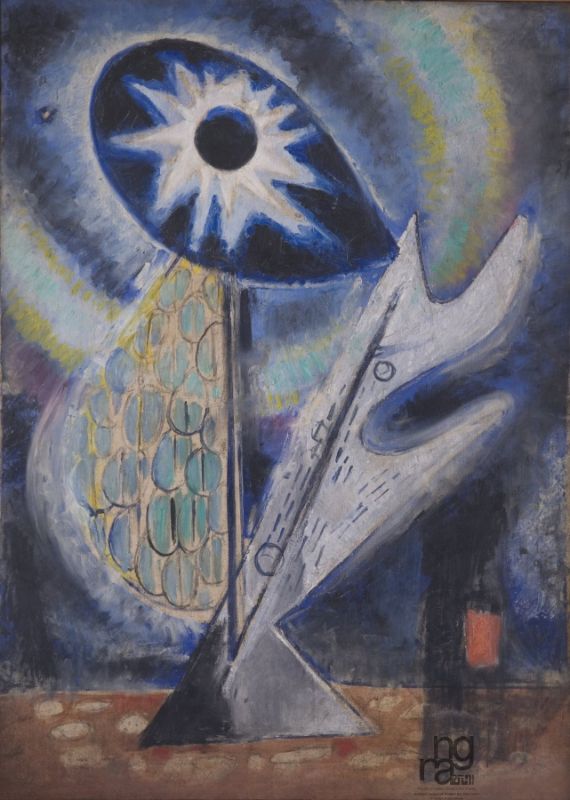 ×Ramkinkar was well aware of the post-industrial art or the modern movements in the western and eastern art scene and tried to incorporate the dynamics of such changes in his own work while keeping the Santiniketan aesthetic tradition in focus. In this abstract painting, he has depicted a lamp post with fluid, swift brush strokes of oil colour in tonal variation creating depth in the composition.
×Ramkinkar was well aware of the post-industrial art or the modern movements in the western and eastern art scene and tried to incorporate the dynamics of such changes in his own work while keeping the Santiniketan aesthetic tradition in focus. In this abstract painting, he has depicted a lamp post with fluid, swift brush strokes of oil colour in tonal variation creating depth in the composition. -
Abstract & Structural Composition
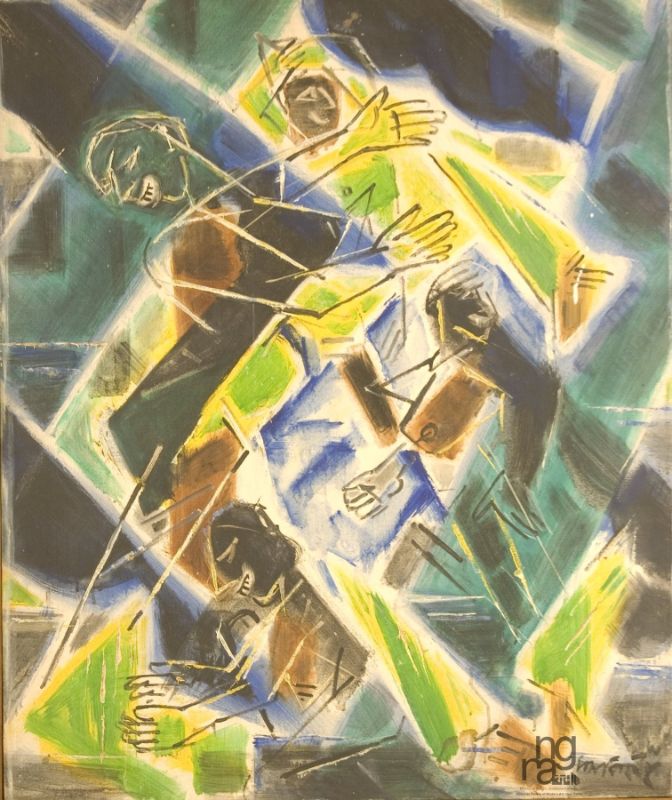 ×Ramkinkar was well aware of the post-industrial art or the modern movements in the western and eastern art scene and tried to incorporate the dynamics of such changes in his own work while keeping the Santiniketan aesthetic tradition in focus. In this abstract painting, he has depicted people tendering the seedling, rendered with the shades of oil colour delineating the forms and adding depth in the composition.
×Ramkinkar was well aware of the post-industrial art or the modern movements in the western and eastern art scene and tried to incorporate the dynamics of such changes in his own work while keeping the Santiniketan aesthetic tradition in focus. In this abstract painting, he has depicted people tendering the seedling, rendered with the shades of oil colour delineating the forms and adding depth in the composition. -
Abstract & Structural Composition
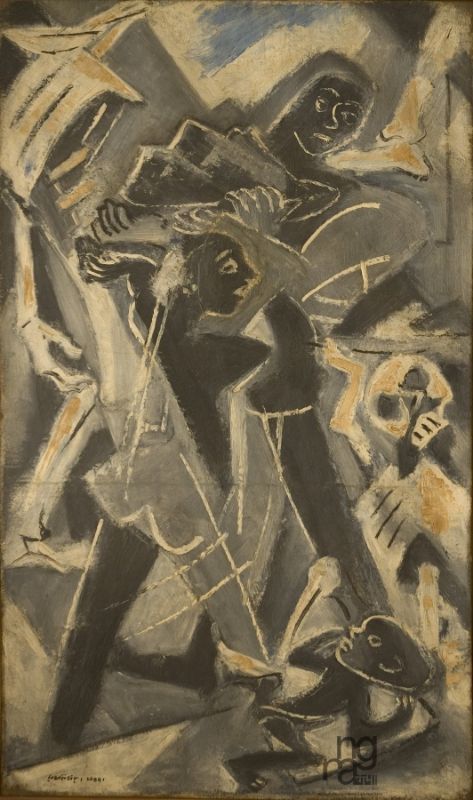 ×Ramkinkar was well aware of the post-industrial art or the modern movements in the western and eastern art scene and tried to incorporate the dynamics of such changes in his own work while keeping the Santiniketan aesthetic tradition in focus. In this painting, he has illustrated a family shifting their belongings, rendered with swift strokes of oil colour in tonal variation delineating the forms and adding depth in the composition.
×Ramkinkar was well aware of the post-industrial art or the modern movements in the western and eastern art scene and tried to incorporate the dynamics of such changes in his own work while keeping the Santiniketan aesthetic tradition in focus. In this painting, he has illustrated a family shifting their belongings, rendered with swift strokes of oil colour in tonal variation delineating the forms and adding depth in the composition. -
Abstract & Structural Composition
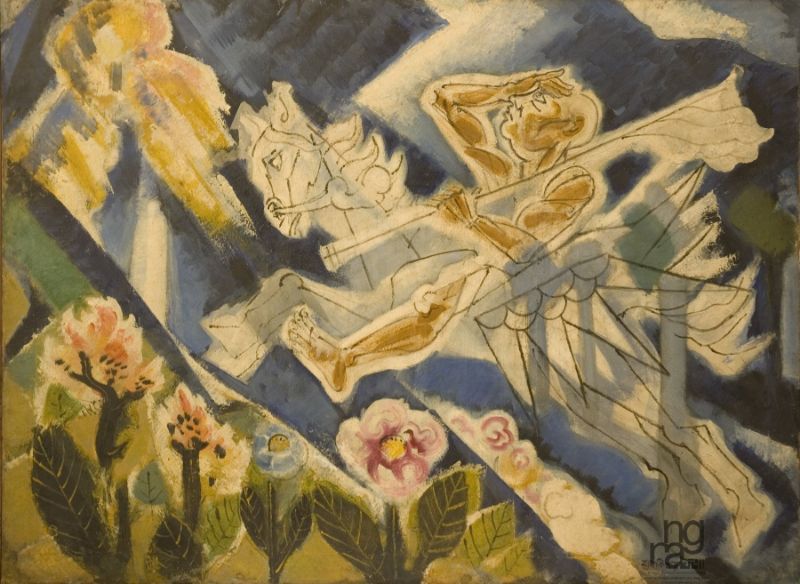 ×Ramkinkar was well aware of the post-industrial art or the modern movements in the western and eastern art scene and tried to incorporate the dynamics of such changes in his own work while keeping the Santiniketan aesthetic tradition in focus. In this oil painting, he has illustrated a scene from childrenís story book ĎFoot of the Arakaní, where a man is climbing a mountain on a horse. This has been rendered with fluid brush strokes in tonal variation adding depth in the composition.
×Ramkinkar was well aware of the post-industrial art or the modern movements in the western and eastern art scene and tried to incorporate the dynamics of such changes in his own work while keeping the Santiniketan aesthetic tradition in focus. In this oil painting, he has illustrated a scene from childrenís story book ĎFoot of the Arakaní, where a man is climbing a mountain on a horse. This has been rendered with fluid brush strokes in tonal variation adding depth in the composition. -
Abstract & Structural Composition
 ×Ramkinkar was well aware of the post-industrial art or the modern movements in the western and eastern art scene and tried to incorporate the dynamics of such changes in his own work while keeping the Santiniketan aesthetic tradition in focus. In this painting, he has depicted an illustration from the children story book series ĎAtomikaí, rendered with the shades of oil colours delineating the forms and adding depth in the composition.
×Ramkinkar was well aware of the post-industrial art or the modern movements in the western and eastern art scene and tried to incorporate the dynamics of such changes in his own work while keeping the Santiniketan aesthetic tradition in focus. In this painting, he has depicted an illustration from the children story book series ĎAtomikaí, rendered with the shades of oil colours delineating the forms and adding depth in the composition. -
Abstract & Structural Composition
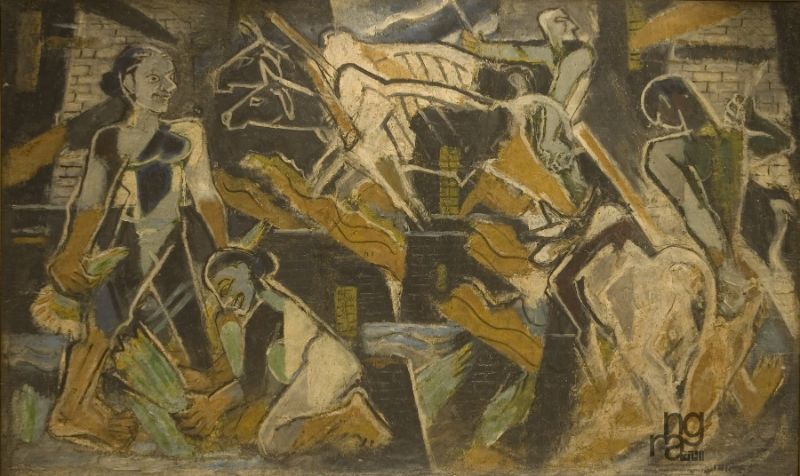 ×Ramkinkar was well aware of the post-industrial art or the modern movements in the western and eastern art scene and tried to incorporate the dynamics of such changes in his own work while keeping the Santiniketan aesthetic tradition in focus. In this painting titled ĎIn the castleí, he has illustrated a village scene with the shades of oil colours delineating the figures and adding depth in the composition.
×Ramkinkar was well aware of the post-industrial art or the modern movements in the western and eastern art scene and tried to incorporate the dynamics of such changes in his own work while keeping the Santiniketan aesthetic tradition in focus. In this painting titled ĎIn the castleí, he has illustrated a village scene with the shades of oil colours delineating the figures and adding depth in the composition.
-
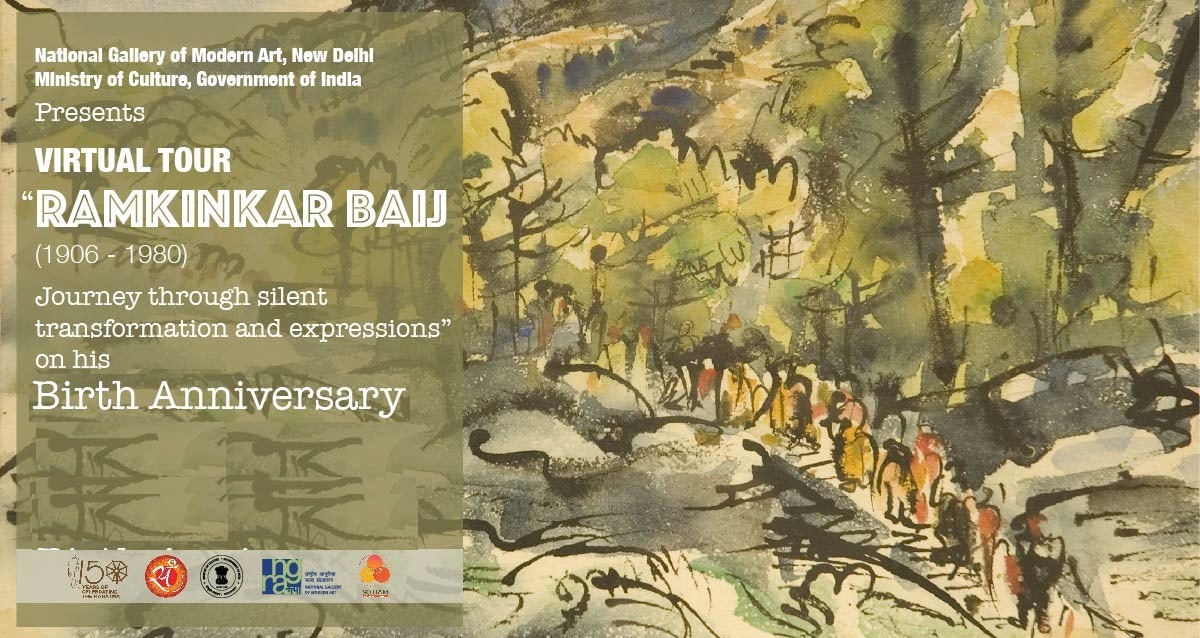 ××××
××××Concept Note
Virtual Tour
Ramkinkar Baij | Journey through silent transformation and expressions The Virtual Tour titled ďRamkinkar Baij | Journey through silent transformation and expressionsĒ is organized to commemorate the 115th Birth Anniversary of Ramkinkar Baij on 26th May 2020. Ramkinkar Baij, one of the most seminal artists of modern India, was an iconic sculptor, painter and graphic artist. In 1970, the Government of India honoured him with the Padma Bhushan for his irrefutable contribution to Indian art. Ramkinkar's monumental sculptures are established landmarks in public art. One of the earliest modernists in Indian art, he assimilated the idioms of the European modern visual language and yet was rooted in his own Indian ethos. He experimented restlessly with forms, moving freely from figurative to abstract and back to figurative, his themes were steeped in a deep sense of humanism and an instinctive understanding of the symbiotic relationship between man and nature. Both in his paintings and sculptures, he pushed the limits of experimentation and ventured into the use of new materials. For instance, his use of unconventional material, for the time, such as cement concrete for his monumental public sculptures set a new precedent for art practices. The NGMA takes pride in 639 works of art created by the iconic artist. This virtual tour presents the 520 works of art from the prominent artworks of Ramkinkar Baij from reserve collection of NGMA, grouped in a series of five different themes of (i) Portrait, (ii) Life Study, (iii) Abstract & Structural Composition, (iv) Nature Study & Landscape and (v) Sculptures. This virtual tour also showcases three sketch books from the collection of NGMA containing 182 works of art. I would urge our esteemed visitors to visit our web site to explore the complete works of art of Ramkinkar Baij through his silent transformation and expressions. I take pride of the tireless effort of our entire IT Cell to conceive and conceptualize the idea of launching Virtual Tours and designed and developed the same amidst lock down period to facilitate our esteemed visitors with the prestigious collection of NGMA. -
Nature Study & Landscape
 ×Ramkinkar deep felt love and oneness with nature could be seen in his vigorously painted and sculpted images of the animals, birds, flora and fauna in his surroundings. In this painting, he has depicted a landscape of Shillong, rendered with dabs and dashes of watercolour merging together in tonal variation and fluid strokes of ink delineating the forms.
×Ramkinkar deep felt love and oneness with nature could be seen in his vigorously painted and sculpted images of the animals, birds, flora and fauna in his surroundings. In this painting, he has depicted a landscape of Shillong, rendered with dabs and dashes of watercolour merging together in tonal variation and fluid strokes of ink delineating the forms. -
Nature Study & Landscape
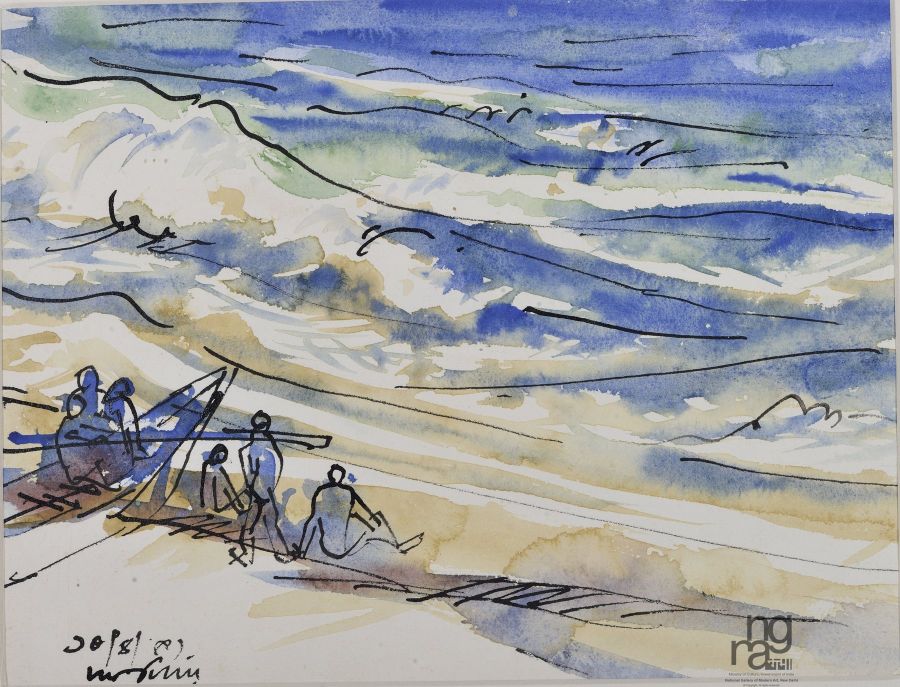 ×Ramkinkar deep felt love and oneness with nature could be seen in his vigorously painted and sculpted images of the animals, birds, flora and fauna in his surroundings. In this painting, he has depicted a seascape in which some people are sitting with a boat near seashore, rendered with dabs and dashes of watercolour merging together in tonal variation and fluid strokes of ink delineating the forms.
×Ramkinkar deep felt love and oneness with nature could be seen in his vigorously painted and sculpted images of the animals, birds, flora and fauna in his surroundings. In this painting, he has depicted a seascape in which some people are sitting with a boat near seashore, rendered with dabs and dashes of watercolour merging together in tonal variation and fluid strokes of ink delineating the forms. -
Nature Study & Landscape
 ×Ramkinkar Baij selected images for his sculptors and paintings from his rural surroundings. The poor and the downtrodden figured primarily as his subjects. His work is characterized by tremendous energy, dynamism and the use of earthy colours. In this sketch, the artist has depicted an imaginary scene, rendered with fluid, fine lines of pen and ink delineating the form.
×Ramkinkar Baij selected images for his sculptors and paintings from his rural surroundings. The poor and the downtrodden figured primarily as his subjects. His work is characterized by tremendous energy, dynamism and the use of earthy colours. In this sketch, the artist has depicted an imaginary scene, rendered with fluid, fine lines of pen and ink delineating the form. -
Nature Study & Landscape
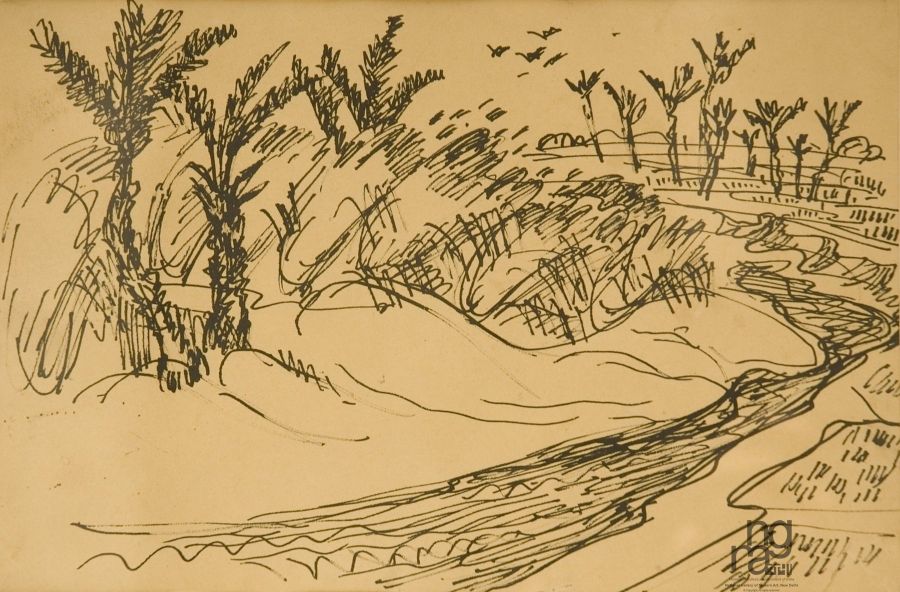 ×Ramkinkar Baijís artistic temperament was defined at Santiniketan an art institution known for providing an informed western modernistic environment to the students. Baij was immensely influenced by his austere surroundings, the ordinary people and nature that became the subject matter for painting and sculpture. In the above painting, the artist has depicted a landscape delineated with bold, thick ink†strokes articulating the curvy path surrounded with trees.†The treatment is intended to exemplify an energetic and lively artistic temperament.
×Ramkinkar Baijís artistic temperament was defined at Santiniketan an art institution known for providing an informed western modernistic environment to the students. Baij was immensely influenced by his austere surroundings, the ordinary people and nature that became the subject matter for painting and sculpture. In the above painting, the artist has depicted a landscape delineated with bold, thick ink†strokes articulating the curvy path surrounded with trees.†The treatment is intended to exemplify an energetic and lively artistic temperament. -
Nature Study & Landscape
 ×The first signs of progressing towards a more radical modernist language beyond post-impressionism can be seen in some of Ramkinkar's drawings from the late thirties and until the later years. Their general theme is landscape, and the motifs are primarily rows of trees and huts, interspersed at times with a few figures. In this particular painting, he has rendered a landscape with dabs and dashes of watercolour, with the individual forms harmoniously blending into each other.
×The first signs of progressing towards a more radical modernist language beyond post-impressionism can be seen in some of Ramkinkar's drawings from the late thirties and until the later years. Their general theme is landscape, and the motifs are primarily rows of trees and huts, interspersed at times with a few figures. In this particular painting, he has rendered a landscape with dabs and dashes of watercolour, with the individual forms harmoniously blending into each other. -
Nature Study & Landscape
 ×Ramkinkar Baij selected images for his sculptors and paintings from his rural surroundings. The poor and the downtrodden figured primarily as his subjects. Baij's watercolours mostly reflects his preoccupation with nature and the animal world. His work is characterized by tremendous energy, dynamism and the use of earthy colours. In the above painting, the artist has depicted a seascape with dabs and dashes of watercolour in tonal variation delineating the form.
×Ramkinkar Baij selected images for his sculptors and paintings from his rural surroundings. The poor and the downtrodden figured primarily as his subjects. Baij's watercolours mostly reflects his preoccupation with nature and the animal world. His work is characterized by tremendous energy, dynamism and the use of earthy colours. In the above painting, the artist has depicted a seascape with dabs and dashes of watercolour in tonal variation delineating the form. -
Nature Study & Landscape
 ×Ramkinkar Baij selected images for his sculptors and paintings from his rural surroundings. The poor and the downtrodden figured primarily as his subjects. Baij's watercolours mostly reflects his preoccupation with nature and the animal world. His work is characterized by tremendous energy, dynamism and the use of earthy colours. In the above painting, the artist has depicted a seascape with dabs and dashes of watercolour in tonal variation delineating the form.
×Ramkinkar Baij selected images for his sculptors and paintings from his rural surroundings. The poor and the downtrodden figured primarily as his subjects. Baij's watercolours mostly reflects his preoccupation with nature and the animal world. His work is characterized by tremendous energy, dynamism and the use of earthy colours. In the above painting, the artist has depicted a seascape with dabs and dashes of watercolour in tonal variation delineating the form. -
Nature Study & Landscape
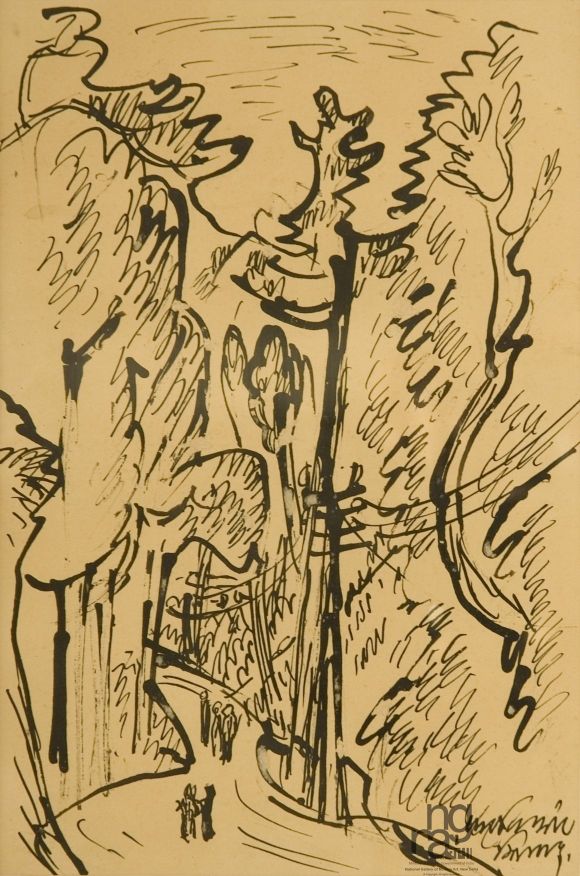 ×Ramkinkar Baij selected images for his sculptors and paintings from his rural surroundings. The poor and the downtrodden figured primarily as his subjects. His work is characterized by tremendous energy, dynamism and the use of earthy colours. In this sketch, the artist has depicted a landscape, rendered with fluid, fine lines of pen and ink delineating the form.
×Ramkinkar Baij selected images for his sculptors and paintings from his rural surroundings. The poor and the downtrodden figured primarily as his subjects. His work is characterized by tremendous energy, dynamism and the use of earthy colours. In this sketch, the artist has depicted a landscape, rendered with fluid, fine lines of pen and ink delineating the form. -
Nature Study & Landscape
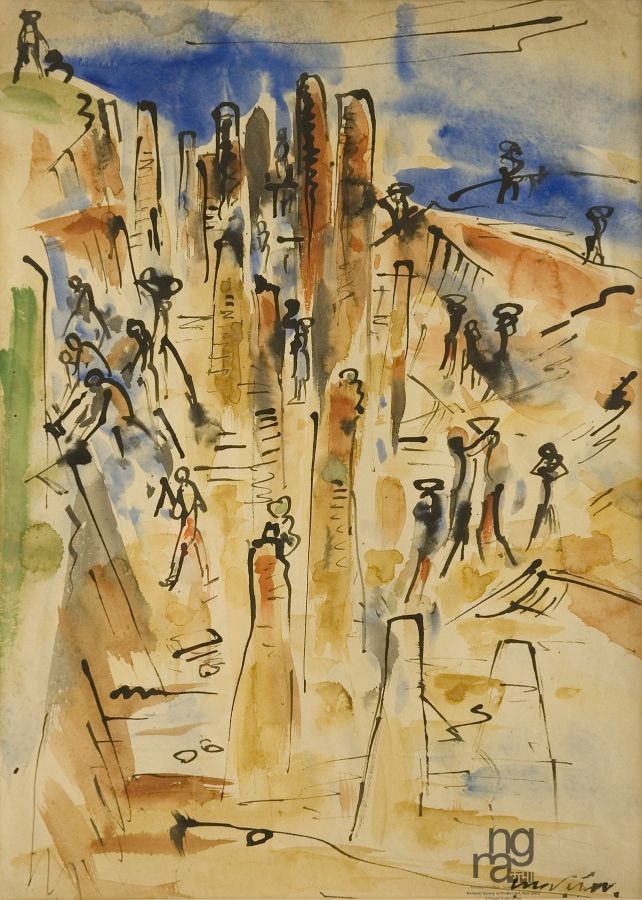 ×Ramkinkar Baij selected images for his sculptors and paintings from his rural surroundings. The poor and the downtrodden figured primarily as his subjects. Baij's watercolours mostly reflects his preoccupation with nature and the animal world. His work is characterized by tremendous energy, dynamism and the use of earthy colours. In the above painting, the artist has depicted canal diggers with dabs and dashes of watercolour in tonal variation delineating the form.
×Ramkinkar Baij selected images for his sculptors and paintings from his rural surroundings. The poor and the downtrodden figured primarily as his subjects. Baij's watercolours mostly reflects his preoccupation with nature and the animal world. His work is characterized by tremendous energy, dynamism and the use of earthy colours. In the above painting, the artist has depicted canal diggers with dabs and dashes of watercolour in tonal variation delineating the form. -
Nature Study & Landscape
 ×The first signs of progressing towards a more radical modernist language beyond post-impressionism can be seen in some of Ramkinkar's drawings from the late thirties and until the later years. Their general theme is landscape, and the motifs are primarily rows of trees and huts, interspersed at times with a few figures. In this particular painting, he has rendered a mountainous terrain with dabs and dashes of watercolour, with the individual forms harmoniously blending into each other.
×The first signs of progressing towards a more radical modernist language beyond post-impressionism can be seen in some of Ramkinkar's drawings from the late thirties and until the later years. Their general theme is landscape, and the motifs are primarily rows of trees and huts, interspersed at times with a few figures. In this particular painting, he has rendered a mountainous terrain with dabs and dashes of watercolour, with the individual forms harmoniously blending into each other. -
Nature Study & Landscape
 ×The first signs of progressing towards a more radical modernist language beyond post-impressionism can be seen in some of Ramkinkar's drawings from the late thirties and until the later years. Their general theme is landscape, and the motifs are primarily rows of trees and huts, interspersed at times with a few figures. In this particular painting, he has rendered a mountainous terrain with dabs and dashes of watercolour, with the individual forms harmoniously blending into each other.
×The first signs of progressing towards a more radical modernist language beyond post-impressionism can be seen in some of Ramkinkar's drawings from the late thirties and until the later years. Their general theme is landscape, and the motifs are primarily rows of trees and huts, interspersed at times with a few figures. In this particular painting, he has rendered a mountainous terrain with dabs and dashes of watercolour, with the individual forms harmoniously blending into each other. -
Nature Study & Landscape
 ×The first signs of progressing towards a more radical modernist language beyond post-impressionism can be seen in some of Ramkinkar's drawings from the late thirties and until the later years. Their general theme is landscape, and the motifs are primarily rows of trees and huts, interspersed at times with a few figures. In this particular painting, he has rendered a mountainous terrain with dabs and dashes of watercolour, with the individual forms harmoniously blending into each other.
×The first signs of progressing towards a more radical modernist language beyond post-impressionism can be seen in some of Ramkinkar's drawings from the late thirties and until the later years. Their general theme is landscape, and the motifs are primarily rows of trees and huts, interspersed at times with a few figures. In this particular painting, he has rendered a mountainous terrain with dabs and dashes of watercolour, with the individual forms harmoniously blending into each other. -
Nature Study & Landscape
 ×Ramkinkar Baijís artistic temperament was defined at Santiniketan an art institution known for providing an informed western modernistic environment to the students. Baij was immensely influenced by his austere surroundings, the ordinary people and nature that became the subject matter for painting and sculpture. In the above painting, the artist has depicted a woman resting under a tree. The composition is delineated with dabs and dashes of watercolour, outlined with black brush strokes articulating the figure. The treatment is intended to exemplify an energetic and lively artistic temperament.
×Ramkinkar Baijís artistic temperament was defined at Santiniketan an art institution known for providing an informed western modernistic environment to the students. Baij was immensely influenced by his austere surroundings, the ordinary people and nature that became the subject matter for painting and sculpture. In the above painting, the artist has depicted a woman resting under a tree. The composition is delineated with dabs and dashes of watercolour, outlined with black brush strokes articulating the figure. The treatment is intended to exemplify an energetic and lively artistic temperament. -
Nature Study & Landscape
 ×The first signs of progressing towards a more radical modernist language beyond post-impressionism can be seen in some of Ramkinkar's drawings from the late thirties and until the later years. Their general theme is landscape, and the motifs are primarily rows of trees and huts, interspersed at times with a few figures. In this particular painting, he has rendered a mother and child walking across a landscape with dabs and dashes of watercolour, with the individual forms harmoniously blending into each other.
×The first signs of progressing towards a more radical modernist language beyond post-impressionism can be seen in some of Ramkinkar's drawings from the late thirties and until the later years. Their general theme is landscape, and the motifs are primarily rows of trees and huts, interspersed at times with a few figures. In this particular painting, he has rendered a mother and child walking across a landscape with dabs and dashes of watercolour, with the individual forms harmoniously blending into each other. -
Nature Study & Landscape
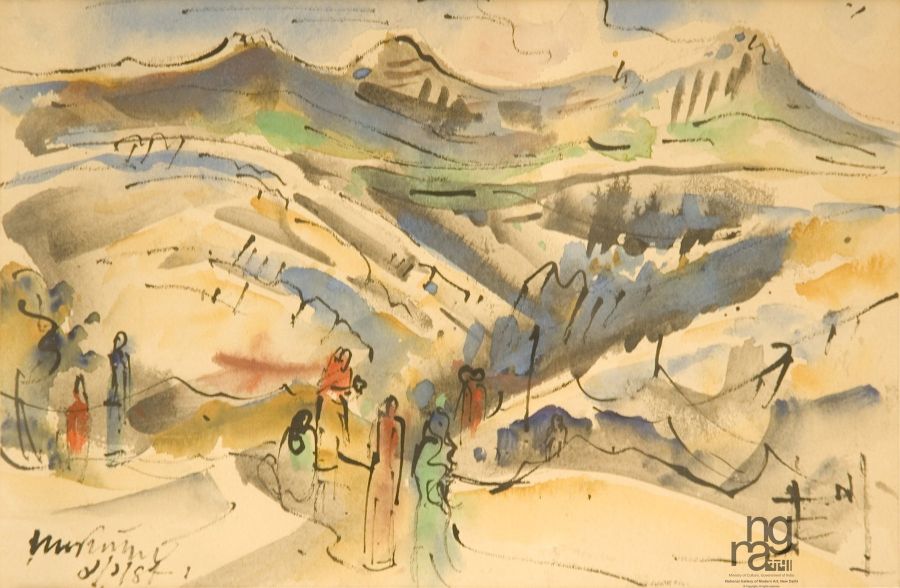 ×The first signs of progressing towards a more radical modernist language beyond post-impressionism can be seen in some of Ramkinkar's drawings from the late thirties and until the later years. Their general theme is landscape, and the motifs are primarily rows of trees and huts, interspersed at times with a few figures. In this particular painting, he has rendered a hilly terrain with dabs and dashes of watercolour, with the individual forms harmoniously blending into each other.
×The first signs of progressing towards a more radical modernist language beyond post-impressionism can be seen in some of Ramkinkar's drawings from the late thirties and until the later years. Their general theme is landscape, and the motifs are primarily rows of trees and huts, interspersed at times with a few figures. In this particular painting, he has rendered a hilly terrain with dabs and dashes of watercolour, with the individual forms harmoniously blending into each other. -
Nature Study & Landscape

Flower Study Acc. No. 3807 | Ink drawing
-
Nature Study & Landscape
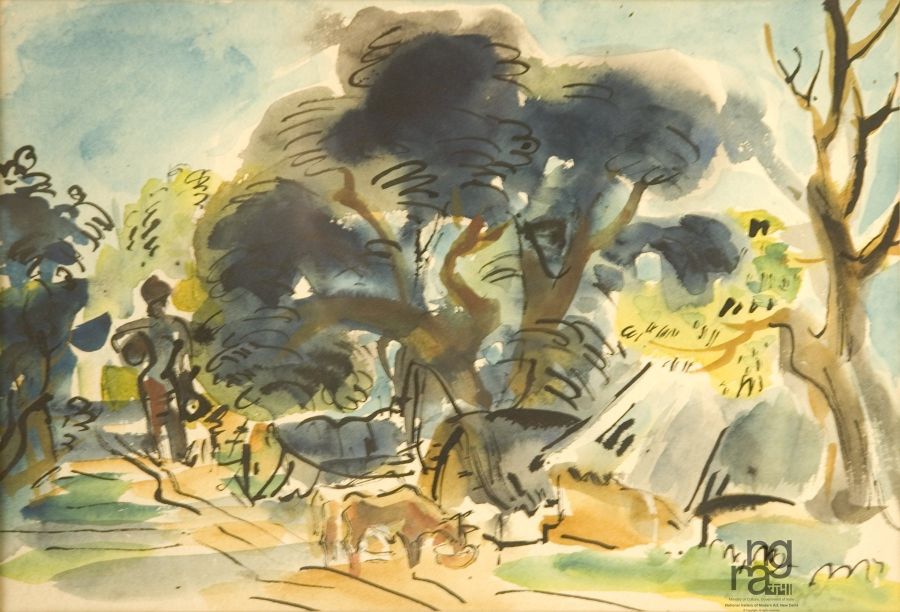 ×Ramkinkar Baijís artistic temperament was defined at Santiniketan an art institution known for providing an informed western modernistic environment to the students. Baij was immensely influenced by his austere surroundings, the ordinary people and nature that became the subject matter for painting and sculpture. In the above painting, the artist has depicted a village path delineated with dabs and dashes of watercolour, outlined with black strokes. The treatment is intended to exemplify an energetic and lively artistic temperament.
×Ramkinkar Baijís artistic temperament was defined at Santiniketan an art institution known for providing an informed western modernistic environment to the students. Baij was immensely influenced by his austere surroundings, the ordinary people and nature that became the subject matter for painting and sculpture. In the above painting, the artist has depicted a village path delineated with dabs and dashes of watercolour, outlined with black strokes. The treatment is intended to exemplify an energetic and lively artistic temperament. -
Nature Study & Landscape
 ×Ramkinkar Baijís artistic temperament was defined at Santinekitan an art institution known for providing an informed western modernistic environment to the students. Baij was immensely influenced by his austere surrounding, the ordinary people and the nature that it became its subject matter for painting and sculpture. In the above painting the artist, has depicted a landscape delineated with dabs and dashes of watercolour, outlined with black strokes. The treatment is intended to exemplify an energetic and lively artistic temperament.
×Ramkinkar Baijís artistic temperament was defined at Santinekitan an art institution known for providing an informed western modernistic environment to the students. Baij was immensely influenced by his austere surrounding, the ordinary people and the nature that it became its subject matter for painting and sculpture. In the above painting the artist, has depicted a landscape delineated with dabs and dashes of watercolour, outlined with black strokes. The treatment is intended to exemplify an energetic and lively artistic temperament. -
Nature Study & Landscape
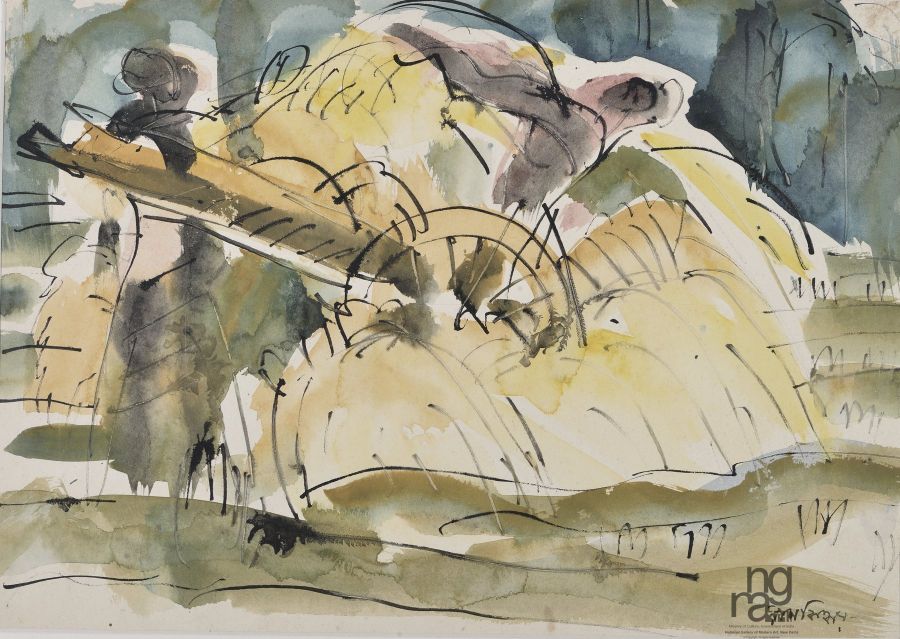 ×Ramkinkar Baij selected images for his sculptures and paintings from his rural surroundings. The poor and the downtrodden figured primarily as his subjects. Baij's watercolours mostly reflect his preoccupation with nature and the animal world. His work is characterized by tremendous energy, dynamism and the use of earthy colours. In the above painting, the artist has depicted two men loading crops on bullock cart with dabs and dashes of watercolour in tonal variation delineating the form.
×Ramkinkar Baij selected images for his sculptures and paintings from his rural surroundings. The poor and the downtrodden figured primarily as his subjects. Baij's watercolours mostly reflect his preoccupation with nature and the animal world. His work is characterized by tremendous energy, dynamism and the use of earthy colours. In the above painting, the artist has depicted two men loading crops on bullock cart with dabs and dashes of watercolour in tonal variation delineating the form. -
Nature Study & Landscape
 ×Ramkinkar Baij selected images for his sculptures and paintings from his rural surroundings. The poor and the downtrodden figured primarily as his subjects. Baij's watercolours mostly reflect his preoccupation with nature and the animal world. His work is characterized by tremendous energy, dynamism and the use of earthy colours. In the above painting, the artist has depicted two men loading crops on bullock cart with dabs and dashes of watercolour in tonal variation delineating the form.
×Ramkinkar Baij selected images for his sculptures and paintings from his rural surroundings. The poor and the downtrodden figured primarily as his subjects. Baij's watercolours mostly reflect his preoccupation with nature and the animal world. His work is characterized by tremendous energy, dynamism and the use of earthy colours. In the above painting, the artist has depicted two men loading crops on bullock cart with dabs and dashes of watercolour in tonal variation delineating the form. -
Nature Study & Landscape
 ×Ramkinker Baijís artistic temperament was defined at Santinekitan an art institution known for providing an informed western modernistic environment to the students. Baij was immensely influenced by his austere surrounding, the ordinary people and the nature that it became its subject matter for painting and sculpture. In the above painting the artist, has depicted a landscape delineated with dabs and dashes of watercolour, outlined with black strokes. The treatment is intended to exemplify an energetic and lively artistic temperament.
×Ramkinker Baijís artistic temperament was defined at Santinekitan an art institution known for providing an informed western modernistic environment to the students. Baij was immensely influenced by his austere surrounding, the ordinary people and the nature that it became its subject matter for painting and sculpture. In the above painting the artist, has depicted a landscape delineated with dabs and dashes of watercolour, outlined with black strokes. The treatment is intended to exemplify an energetic and lively artistic temperament. -
Nature Study & Landscape
 ×Ramkinkar's deep felt love and oneness with nature could be seen in his vigorously painted and sculpted images of the animals, birds, flora and fauna in his surroundings. In this painting, he has depicted two figures walking down a tree-laden path, rendered with dabs and dashes of watercolour merging together in tonal variations and fluid strokes of ink delineating the forms.
×Ramkinkar's deep felt love and oneness with nature could be seen in his vigorously painted and sculpted images of the animals, birds, flora and fauna in his surroundings. In this painting, he has depicted two figures walking down a tree-laden path, rendered with dabs and dashes of watercolour merging together in tonal variations and fluid strokes of ink delineating the forms. -
Nature Study & Landscape
 ×Ramkinkar Baij selected images for his sculptures and paintings from his rural surroundings. The poor and the downtrodden figured primarily as his subjects. Baij's watercolours mostly reflect his preoccupation with nature and the animal world. His work is characterised by tremendous energy, dynamism and the use of earthy colours. In the above painting, the artist has depicted a man bathing his buffaloes in the river, rendered with dabs and dashes of watercolour in tonal variations, delineating the forms.
×Ramkinkar Baij selected images for his sculptures and paintings from his rural surroundings. The poor and the downtrodden figured primarily as his subjects. Baij's watercolours mostly reflect his preoccupation with nature and the animal world. His work is characterised by tremendous energy, dynamism and the use of earthy colours. In the above painting, the artist has depicted a man bathing his buffaloes in the river, rendered with dabs and dashes of watercolour in tonal variations, delineating the forms. -
Nature Study & Landscape
 ×Ramkinkar's deep felt love and oneness with nature could be seen in his vigorously painted and sculpted images of the animals, birds, flora and fauna in his surroundings. In this painting, he has depicted a landscape rendered with dabs and dashes of watercolour merging together in tonal variations and fluid strokes of ink delineating the forms.
×Ramkinkar's deep felt love and oneness with nature could be seen in his vigorously painted and sculpted images of the animals, birds, flora and fauna in his surroundings. In this painting, he has depicted a landscape rendered with dabs and dashes of watercolour merging together in tonal variations and fluid strokes of ink delineating the forms. -
Nature Study & Landscape
 ×Ramkinkar deep felt love and oneness with nature could be seen in his vigorously painted and sculpted images of the animals, birds, flora and fauna in his surroundings. In this painting, he has depicted a serene landscape having trees and mountains with swift, fluid strokes of watercolour in tonal variation delineating the forms and adding grace in the composition.
×Ramkinkar deep felt love and oneness with nature could be seen in his vigorously painted and sculpted images of the animals, birds, flora and fauna in his surroundings. In this painting, he has depicted a serene landscape having trees and mountains with swift, fluid strokes of watercolour in tonal variation delineating the forms and adding grace in the composition. -
Nature Study & Landscape
 ×Ramkinkar Baijís artistic temperament was defined at Santiniketan, an art institution known for providing an informed western modernistic environment to the students. Baij was immensely influenced by his austere surroundings, the ordinary people and nature that became the subject matter for painting and sculpture. In this sketch, the artist has depicted Konark Waves, rendered with dabs and dashes of watercolour in tonal variations. The treatment is intended to exemplify an energetic and lively artistic temperament.
×Ramkinkar Baijís artistic temperament was defined at Santiniketan, an art institution known for providing an informed western modernistic environment to the students. Baij was immensely influenced by his austere surroundings, the ordinary people and nature that became the subject matter for painting and sculpture. In this sketch, the artist has depicted Konark Waves, rendered with dabs and dashes of watercolour in tonal variations. The treatment is intended to exemplify an energetic and lively artistic temperament. -
Nature Study & Landscape
 ×Ramkinkar Baij selected images for his sculptures and paintings from his rural surroundings. The poor and the downtrodden figured primarily as his subjects. His work is characterized by tremendous energy, dynamism and the use of earthy colours. In this sketch, the artist has depicted a landscape, rendered with fluid, fine lines of pen and ink delineating the form.
×Ramkinkar Baij selected images for his sculptures and paintings from his rural surroundings. The poor and the downtrodden figured primarily as his subjects. His work is characterized by tremendous energy, dynamism and the use of earthy colours. In this sketch, the artist has depicted a landscape, rendered with fluid, fine lines of pen and ink delineating the form. -
Nature Study & Landscape
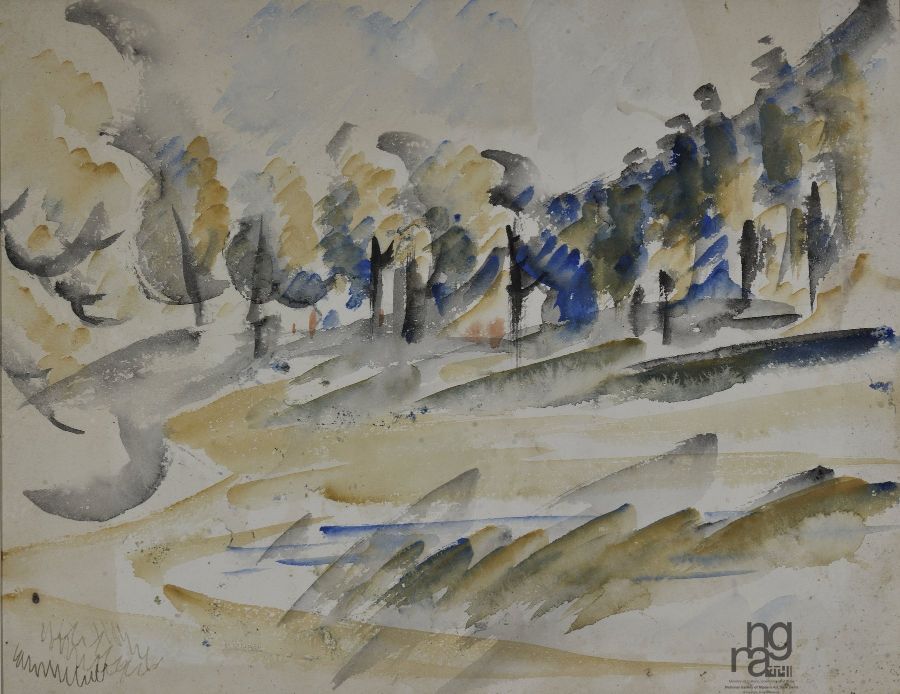 ×Ramkinkar's deep felt love and oneness with nature could be seen in his vigorously painted and sculpted images of the animals, birds, flora and fauna in his surroundings. In this painting, he has depicted a landscape, rendered with dabs and dashes of watercolour merging together in tonal variations and fluid strokes of ink delineating the forms.
×Ramkinkar's deep felt love and oneness with nature could be seen in his vigorously painted and sculpted images of the animals, birds, flora and fauna in his surroundings. In this painting, he has depicted a landscape, rendered with dabs and dashes of watercolour merging together in tonal variations and fluid strokes of ink delineating the forms. -
Nature Study & Landscape
 ×Ramkinkar Baij selected images for his sculptures and paintings from his rural surroundings. The poor and the downtrodden figured primarily as his subjects. His work is characterised by tremendous energy, dynamism and the use of earthy colours. In the above painting, the artist has depicted the study of a town in an idiom inspired from cubism, rendered with fluid, fine brush strokes delineating the forms.
×Ramkinkar Baij selected images for his sculptures and paintings from his rural surroundings. The poor and the downtrodden figured primarily as his subjects. His work is characterised by tremendous energy, dynamism and the use of earthy colours. In the above painting, the artist has depicted the study of a town in an idiom inspired from cubism, rendered with fluid, fine brush strokes delineating the forms. -
Nature Study & Landscape
 ×Ramkinkar's deep felt love and oneness with nature could be seen in his vigorously painted and sculpted images of the animals, birds, flora and fauna in his surroundings. In this painting, he has depicted thick, lush bamboo groves rendered with dabs and dashes of watercolour merging together in tonal variations and fluid strokes of ink delineating the forms.
×Ramkinkar's deep felt love and oneness with nature could be seen in his vigorously painted and sculpted images of the animals, birds, flora and fauna in his surroundings. In this painting, he has depicted thick, lush bamboo groves rendered with dabs and dashes of watercolour merging together in tonal variations and fluid strokes of ink delineating the forms. -
Nature Study & Landscape
 ×Ramkinkar Baijís artistic temperament was defined at Santiniketan, an art institution known for providing an informed western modernistic environment to the students. Baij was immensely influenced by his austere surroundings, the ordinary people and nature that became the subject matter for painting and sculpture. In this sketch, the artist has depicted a dam at Kharagpur, rendered with dabs and dashes of watercolour in tonal variations. The quick rendition was intended as a study of the architectural structure.
×Ramkinkar Baijís artistic temperament was defined at Santiniketan, an art institution known for providing an informed western modernistic environment to the students. Baij was immensely influenced by his austere surroundings, the ordinary people and nature that became the subject matter for painting and sculpture. In this sketch, the artist has depicted a dam at Kharagpur, rendered with dabs and dashes of watercolour in tonal variations. The quick rendition was intended as a study of the architectural structure. -
Nature Study & Landscape
 ×Ramkinkar deep felt love and oneness with nature could be seen in his vigorously painted and sculpted images of animals, birds, flora and fauna in his surroundings. In this painting, he has depicted the waves of a sea with dabs and dashes of watercolour merging together with fluid strokes of ink delineating its form.
×Ramkinkar deep felt love and oneness with nature could be seen in his vigorously painted and sculpted images of animals, birds, flora and fauna in his surroundings. In this painting, he has depicted the waves of a sea with dabs and dashes of watercolour merging together with fluid strokes of ink delineating its form. -
Nature Study & Landscape
 ×Ramkinkar Baijís artistic temperament was defined at Santiniketan, an art institution known for providing an informed western modernistic environment to the students. Baij was immensely influenced by his austere surroundings, the ordinary people and nature that became the subject matter for painting and sculpture. In this sketch, the artist has depicted flowering trees, rendered with dabs and dashes of watercolour in tonal variations. The treatment is intended to exemplify an energetic and lively artistic temperament.
×Ramkinkar Baijís artistic temperament was defined at Santiniketan, an art institution known for providing an informed western modernistic environment to the students. Baij was immensely influenced by his austere surroundings, the ordinary people and nature that became the subject matter for painting and sculpture. In this sketch, the artist has depicted flowering trees, rendered with dabs and dashes of watercolour in tonal variations. The treatment is intended to exemplify an energetic and lively artistic temperament. -
Nature Study & Landscape
 ×Ramkinkar's deep felt love and oneness with nature could be seen in his vigorously painted and sculpted images of the animals, birds, flora and fauna in his surroundings. In this painting, he has depicted a landscape, rendered with dabs and dashes of watercolour merging together in tonal variations and fluid strokes of ink delineating the forms.
×Ramkinkar's deep felt love and oneness with nature could be seen in his vigorously painted and sculpted images of the animals, birds, flora and fauna in his surroundings. In this painting, he has depicted a landscape, rendered with dabs and dashes of watercolour merging together in tonal variations and fluid strokes of ink delineating the forms. -
Nature Study & Landscape
 ×Ramkinkar's deep felt love and oneness with nature could be seen in his vigorously painted and sculpted images of the animals, birds, flora and fauna in his surroundings. In this painting, he has depicted a mountain landscape, rendered with dabs and dashes of watercolour merging together in tonal variations and fluid strokes of ink delineating the forms.
×Ramkinkar's deep felt love and oneness with nature could be seen in his vigorously painted and sculpted images of the animals, birds, flora and fauna in his surroundings. In this painting, he has depicted a mountain landscape, rendered with dabs and dashes of watercolour merging together in tonal variations and fluid strokes of ink delineating the forms. -
Nature Study & Landscape
 ×Ramkinkar's deep felt love and oneness with nature could be seen in his vigorously painted and sculpted images of the animals, birds, flora and fauna in his surroundings. In this painting, he has depicted a landscape, rendered with dabs and dashes of watercolour merging together in tonal variations and fluid strokes of ink delineating the forms.
×Ramkinkar's deep felt love and oneness with nature could be seen in his vigorously painted and sculpted images of the animals, birds, flora and fauna in his surroundings. In this painting, he has depicted a landscape, rendered with dabs and dashes of watercolour merging together in tonal variations and fluid strokes of ink delineating the forms. -
Nature Study & Landscape
 ×Ramkinkar's deep felt love and oneness with nature could be seen in his vigorously painted and sculpted images of the animals, birds, flora and fauna in his surroundings. In this painting, he has studied a dried tree, rendered with dabs and dashes of watercolour merging together in tonal variations and fluid strokes of ink delineating the forms.
×Ramkinkar's deep felt love and oneness with nature could be seen in his vigorously painted and sculpted images of the animals, birds, flora and fauna in his surroundings. In this painting, he has studied a dried tree, rendered with dabs and dashes of watercolour merging together in tonal variations and fluid strokes of ink delineating the forms. -
Nature Study & Landscape
 ×Ramkinkar's deep felt love and oneness with nature could be seen in his vigorously painted and sculpted images of the animals, birds, flora and fauna in his surroundings. In this painting, he has depicted a landscape, rendered with dabs and dashes of watercolour merging together in tonal variations and fluid strokes of ink delineating the forms.
×Ramkinkar's deep felt love and oneness with nature could be seen in his vigorously painted and sculpted images of the animals, birds, flora and fauna in his surroundings. In this painting, he has depicted a landscape, rendered with dabs and dashes of watercolour merging together in tonal variations and fluid strokes of ink delineating the forms. -
Nature Study & Landscape
 ×Ramkinker Baijís artistic temperament was defined at Santinekitan an art institution known for providing an informed western modernistic environment to the students. Baij was immensely influenced by his austere surrounding, the ordinary people and the nature that it became its subject matter for painting and sculpture. In the above painting the artist, has depicted a landscape delineated with dabs and dashes of watercolour, outlined with black strokes. The treatment is intended to exemplify an energetic and lively artistic temperament.
×Ramkinker Baijís artistic temperament was defined at Santinekitan an art institution known for providing an informed western modernistic environment to the students. Baij was immensely influenced by his austere surrounding, the ordinary people and the nature that it became its subject matter for painting and sculpture. In the above painting the artist, has depicted a landscape delineated with dabs and dashes of watercolour, outlined with black strokes. The treatment is intended to exemplify an energetic and lively artistic temperament. -
Nature Study & Landscape
 ×Ramkinkar deep felt love and oneness with nature could be seen in his vigorously painted and sculpted images of animals, birds, flora and fauna in his surroundings. In this painting, he has depicted a landscape with trees and mountains, rendered with fluid, swift strokes of watercolour in tonal variation delineating the forms and adding grace to the composition.
×Ramkinkar deep felt love and oneness with nature could be seen in his vigorously painted and sculpted images of animals, birds, flora and fauna in his surroundings. In this painting, he has depicted a landscape with trees and mountains, rendered with fluid, swift strokes of watercolour in tonal variation delineating the forms and adding grace to the composition. -
Nature Study & Landscape
 ×Ramkinkar deep felt love and oneness with nature could be seen in his vigorously painted and sculpted images of animals, birds, flora and fauna in his surroundings. In this painting, he has depicted a hay stalk with fluid, swift strokes of watercolour in tonal variation delineating the form.
×Ramkinkar deep felt love and oneness with nature could be seen in his vigorously painted and sculpted images of animals, birds, flora and fauna in his surroundings. In this painting, he has depicted a hay stalk with fluid, swift strokes of watercolour in tonal variation delineating the form. -
Nature Study & Landscape
 ×Ramkinkar's deep felt love and oneness with nature could be seen in his vigorously painted and sculpted images of the animals, birds, flora and fauna in his surroundings. In this painting, he has depicted a landscape, rendered with dabs and dashes of watercolour merging together in tonal variations and fluid strokes of ink delineating the forms.
×Ramkinkar's deep felt love and oneness with nature could be seen in his vigorously painted and sculpted images of the animals, birds, flora and fauna in his surroundings. In this painting, he has depicted a landscape, rendered with dabs and dashes of watercolour merging together in tonal variations and fluid strokes of ink delineating the forms. -
Nature Study & Landscape
 ×Ramkinkar Baij selected images for his sculptures and paintings from his rural surroundings. The poor and the downtrodden figured primarily as his subjects. Baij's watercolours mostly reflect his preoccupation with nature and the animal world. His work is characterized by tremendous energy, dynamism and the use of earthy colours. In the above painting, the artist has depicted a landscape with dabs and dashes of watercolour in tonal variation delineating the form.
×Ramkinkar Baij selected images for his sculptures and paintings from his rural surroundings. The poor and the downtrodden figured primarily as his subjects. Baij's watercolours mostly reflect his preoccupation with nature and the animal world. His work is characterized by tremendous energy, dynamism and the use of earthy colours. In the above painting, the artist has depicted a landscape with dabs and dashes of watercolour in tonal variation delineating the form. -
Nature Study & Landscape
 ×Ramkinkar Baij selected images for his sculptures and paintings from his rural surroundings. The poor and the downtrodden figured primarily as his subjects. Baij's watercolours mostly reflect his preoccupation with nature and the animal world. His work is characterised by tremendous energy, dynamism and the use of earthy colours. In the above painting, the artist has depicted a flowering tree, rendered with dabs and dashes of watercolour in tonal variations, delineating the form.
×Ramkinkar Baij selected images for his sculptures and paintings from his rural surroundings. The poor and the downtrodden figured primarily as his subjects. Baij's watercolours mostly reflect his preoccupation with nature and the animal world. His work is characterised by tremendous energy, dynamism and the use of earthy colours. In the above painting, the artist has depicted a flowering tree, rendered with dabs and dashes of watercolour in tonal variations, delineating the form. -
Nature Study & Landscape
 ×Ramkinkar's deep felt love and oneness with nature could be seen in his vigorously painted and sculpted images of the animals, birds, flora and fauna in his surroundings. In this painting, he has depicted a landscape, rendered with dabs and dashes of watercolour merging together in tonal variations and fluid strokes of ink delineating the forms.
×Ramkinkar's deep felt love and oneness with nature could be seen in his vigorously painted and sculpted images of the animals, birds, flora and fauna in his surroundings. In this painting, he has depicted a landscape, rendered with dabs and dashes of watercolour merging together in tonal variations and fluid strokes of ink delineating the forms. -
Nature Study & Landscape
 ×Ramkinkar deep felt love and oneness with nature could be seen in his vigorously painted and sculpted images of animals, birds, flora and fauna from his surroundings. In this sketch, he has depicted palm trees with dabs and dashes of watercolour in tonal variation and soft, fluid brush strokes of ink delineating the form.
×Ramkinkar deep felt love and oneness with nature could be seen in his vigorously painted and sculpted images of animals, birds, flora and fauna from his surroundings. In this sketch, he has depicted palm trees with dabs and dashes of watercolour in tonal variation and soft, fluid brush strokes of ink delineating the form. -
Nature Study & Landscape
 ×Ramkinkar felt deep†love and oneness with nature, that could be seen in his vigorously painted and sculpted images of the animals, birds, flora and fauna in his surroundings. In this painting, the artist has depicted a landscape at Kharagpur, rendered with dabs and dashes of watercolour. The colours are merged together in tonal variations with swift brush strokes to delineate the landscape and add grace to the composition.†
×Ramkinkar felt deep†love and oneness with nature, that could be seen in his vigorously painted and sculpted images of the animals, birds, flora and fauna in his surroundings. In this painting, the artist has depicted a landscape at Kharagpur, rendered with dabs and dashes of watercolour. The colours are merged together in tonal variations with swift brush strokes to delineate the landscape and add grace to the composition.† -
Nature Study & Landscape
 ×Ramkinkar deep felt love and oneness with nature could be seen in his vigorously painted and sculpted images of the animals, birds, flora and fauna in his surroundings. In this painting, the artist has depicted a village scene at Shillong, rendered with dabs and dashes of watercolour. The colours are merged together in tonal variations with swift brush strokes, to delineate the human habitat and add grace to the composition.
×Ramkinkar deep felt love and oneness with nature could be seen in his vigorously painted and sculpted images of the animals, birds, flora and fauna in his surroundings. In this painting, the artist has depicted a village scene at Shillong, rendered with dabs and dashes of watercolour. The colours are merged together in tonal variations with swift brush strokes, to delineate the human habitat and add grace to the composition. -
Nature Study & Landscape
 ×Ramkinkar Baij selected images for his sculptures and paintings from his rural surroundings. The poor and the downtrodden figured primarily as his subjects. Baij's watercolours mostly reflect his preoccupation with nature and the animal world. His work is characterized by tremendous energy, dynamism and the use of earthy colours. In the above painting, the artist has depicted trees with dabs and dashes of watercolour in tonal variation delineating the form.
×Ramkinkar Baij selected images for his sculptures and paintings from his rural surroundings. The poor and the downtrodden figured primarily as his subjects. Baij's watercolours mostly reflect his preoccupation with nature and the animal world. His work is characterized by tremendous energy, dynamism and the use of earthy colours. In the above painting, the artist has depicted trees with dabs and dashes of watercolour in tonal variation delineating the form. -
Nature Study & Landscape
 ×Ramkinkar Baijís artistic temperament was defined at Santiniketan an art institution known for providing an informed western modernistic environment to the students. Baij was immensely influenced by his austere surroundings, the ordinary people and nature that became the subject matter for painting and sculpture. In the above painting, the artist has depicted a landscape delineated with dabs and dashes of watercolour, outlined with black strokes. The treatment is intended to exemplify an energetic and lively artistic temperament.
×Ramkinkar Baijís artistic temperament was defined at Santiniketan an art institution known for providing an informed western modernistic environment to the students. Baij was immensely influenced by his austere surroundings, the ordinary people and nature that became the subject matter for painting and sculpture. In the above painting, the artist has depicted a landscape delineated with dabs and dashes of watercolour, outlined with black strokes. The treatment is intended to exemplify an energetic and lively artistic temperament. -
Nature Study & Landscape
 ×Ramkinkar Baijís artistic temperament was defined at Santiniketan an art institution known for providing an informed western modernistic environment to the students. Baij was immensely influenced by his austere surroundings, the ordinary people and nature that became the subject matter for painting and sculpture. In the above painting, the artist has depicted a landscape delineated with dabs and dashes of watercolour, outlined with black strokes. The treatment is intended to exemplify an energetic and lively artistic temperament.
×Ramkinkar Baijís artistic temperament was defined at Santiniketan an art institution known for providing an informed western modernistic environment to the students. Baij was immensely influenced by his austere surroundings, the ordinary people and nature that became the subject matter for painting and sculpture. In the above painting, the artist has depicted a landscape delineated with dabs and dashes of watercolour, outlined with black strokes. The treatment is intended to exemplify an energetic and lively artistic temperament. -
Nature Study & Landscape
 ×Ramkinkar Baijís artistic temperament was defined at Santiniketan an art institution known for providing an informed western modernistic environment to the students. Baij was immensely influenced by his austere surroundings, the ordinary people and nature that became the subject matter for painting and sculpture. In the above painting, the artist has depicted the landscape of Kopai delineated with dabs and dashes of watercolour, outlined with black strokes. The treatment is intended to exemplify an energetic and lively artistic temperament.
×Ramkinkar Baijís artistic temperament was defined at Santiniketan an art institution known for providing an informed western modernistic environment to the students. Baij was immensely influenced by his austere surroundings, the ordinary people and nature that became the subject matter for painting and sculpture. In the above painting, the artist has depicted the landscape of Kopai delineated with dabs and dashes of watercolour, outlined with black strokes. The treatment is intended to exemplify an energetic and lively artistic temperament. -
Nature Study & Landscape
 ×Ramkinkar felt deep love and oneness with nature, that could be seen in his vigorously painted and sculpted images of the animals, birds, flora and fauna in his surroundings. In this painting, the artist has depicted a serene landscape during the rains. The composition is rendered with dabs and dashes of watercolour merging together in tonal variations, delineating the forms and adding grace to the composition.
×Ramkinkar felt deep love and oneness with nature, that could be seen in his vigorously painted and sculpted images of the animals, birds, flora and fauna in his surroundings. In this painting, the artist has depicted a serene landscape during the rains. The composition is rendered with dabs and dashes of watercolour merging together in tonal variations, delineating the forms and adding grace to the composition. -
Nature Study & Landscape
 ×Ramkinkar's deep felt love and oneness with nature could be seen in his vigorously painted and sculpted images of the animals, birds, flora and fauna in his surroundings. In this painting, he has depicted a landscape, rendered with dabs and dashes of watercolour merging together in tonal variations and fluid strokes of ink delineating the forms.
×Ramkinkar's deep felt love and oneness with nature could be seen in his vigorously painted and sculpted images of the animals, birds, flora and fauna in his surroundings. In this painting, he has depicted a landscape, rendered with dabs and dashes of watercolour merging together in tonal variations and fluid strokes of ink delineating the forms. -
Nature Study & Landscape
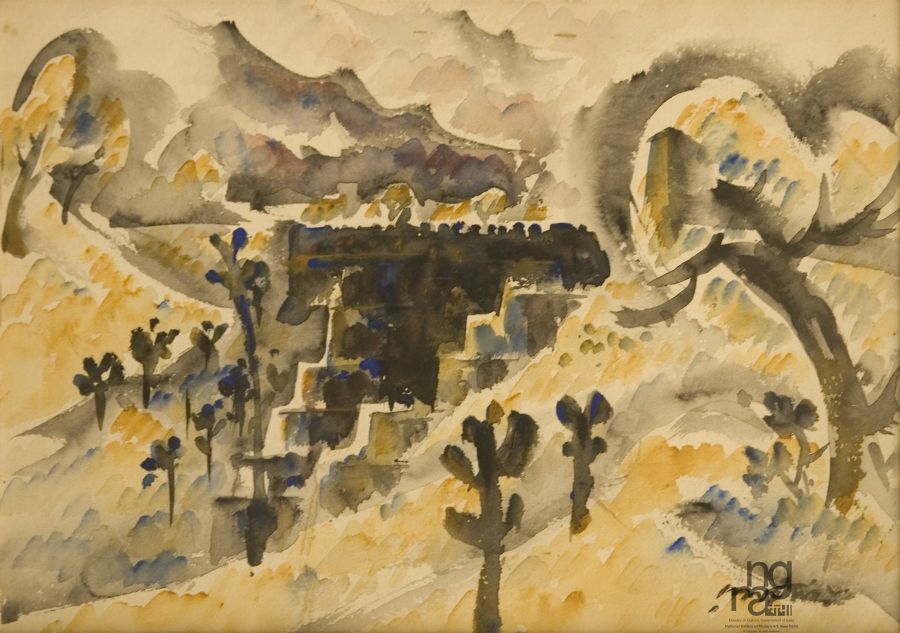 ×Ramkinkar Baijís artistic temperament was defined at Santiniketan an art institution known for providing an informed western modernistic environment to the students. Baij was immensely influenced by his austere surroundings, the ordinary people and nature that became the subject matter for painting and sculpture. In the above painting, the artist has depicted a dam, delineated with dabs and dashes of watercolour. The treatment is intended to exemplify an energetic and lively artistic temperament.
×Ramkinkar Baijís artistic temperament was defined at Santiniketan an art institution known for providing an informed western modernistic environment to the students. Baij was immensely influenced by his austere surroundings, the ordinary people and nature that became the subject matter for painting and sculpture. In the above painting, the artist has depicted a dam, delineated with dabs and dashes of watercolour. The treatment is intended to exemplify an energetic and lively artistic temperament. -
Nature Study & Landscape
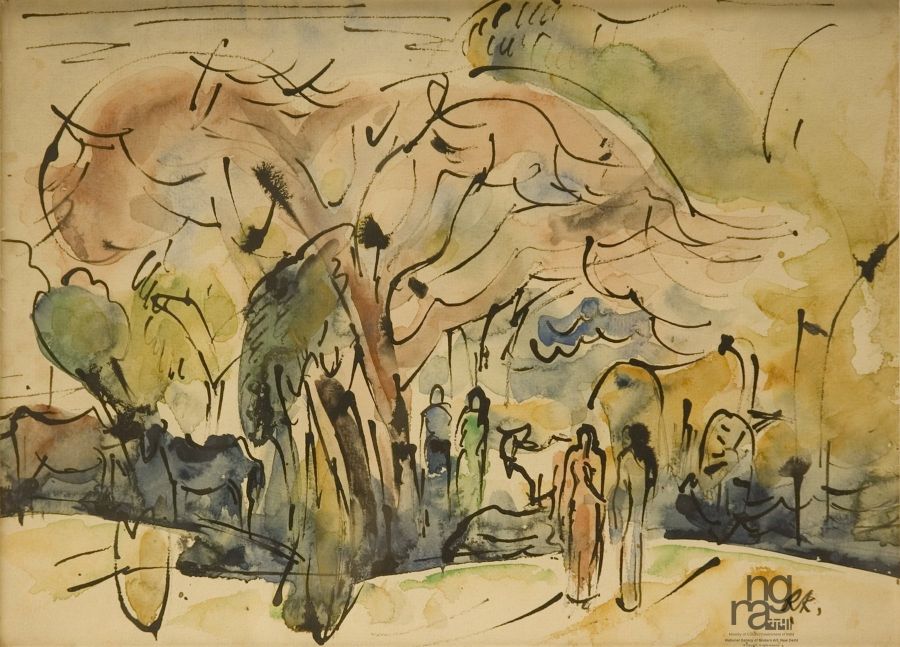 ×Ramkinkar Baijís artistic temperament was defined at Santiniketan an art institution known for providing an informed western modernistic environment to the students. Baij was immensely influenced by his austere surroundings, the ordinary people and nature that became the subject matter for painting and sculpture. In the above painting, the artist has depicted a village scene delineated with dabs and dashes of watercolour, outlined with black strokes. The treatment is intended to exemplify an energetic and lively artistic temperament.
×Ramkinkar Baijís artistic temperament was defined at Santiniketan an art institution known for providing an informed western modernistic environment to the students. Baij was immensely influenced by his austere surroundings, the ordinary people and nature that became the subject matter for painting and sculpture. In the above painting, the artist has depicted a village scene delineated with dabs and dashes of watercolour, outlined with black strokes. The treatment is intended to exemplify an energetic and lively artistic temperament. -
Nature Study & Landscape
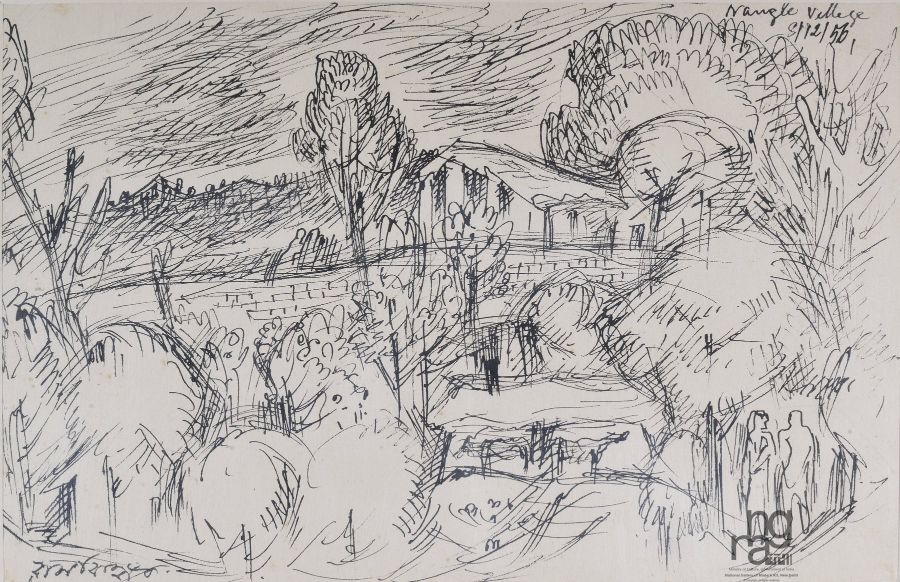 ×Ramkinkar Baijís artistic temperament was defined at Santiniketan, an art institution known for providing an informed western modernistic environment to the students. Baij was immensely influenced by his austere surroundings, the ordinary people and nature that became the subject matter for painting and sculpture. In the above drawing, the artist has depicted a settlement in the mountains with fine yet firm pen and ink strokes. The treatment is intended to exemplify an energetic and lively artistic temperament.
×Ramkinkar Baijís artistic temperament was defined at Santiniketan, an art institution known for providing an informed western modernistic environment to the students. Baij was immensely influenced by his austere surroundings, the ordinary people and nature that became the subject matter for painting and sculpture. In the above drawing, the artist has depicted a settlement in the mountains with fine yet firm pen and ink strokes. The treatment is intended to exemplify an energetic and lively artistic temperament. -
Nature Study & Landscape
 ×Ramkinkar deep felt love and oneness with nature, that could be seen in his vigorously painted and sculpted images of the animals, birds, flora and fauna in his surroundings. In this painting, the artist has depicted a few road builders at work, rendered with dabs and dashes of watercolour. The colours are merged together in tonal variations to delineate the forms and add grace to the composition.
×Ramkinkar deep felt love and oneness with nature, that could be seen in his vigorously painted and sculpted images of the animals, birds, flora and fauna in his surroundings. In this painting, the artist has depicted a few road builders at work, rendered with dabs and dashes of watercolour. The colours are merged together in tonal variations to delineate the forms and add grace to the composition. -
Nature Study & Landscape
 ×Ramkinkar Baijís artistic temperament was defined at Santiniketan an art institution known for providing an informed western modernistic environment to the students. Baij was immensely influenced by his austere surroundings, the ordinary people and nature that became the subject matter for painting and sculpture. In the above painting, the artist has depicted a landscape delineated with dabs and dashes of watercolour, outlined with black strokes. The treatment is intended to exemplify an energetic and lively artistic temperament.
×Ramkinkar Baijís artistic temperament was defined at Santiniketan an art institution known for providing an informed western modernistic environment to the students. Baij was immensely influenced by his austere surroundings, the ordinary people and nature that became the subject matter for painting and sculpture. In the above painting, the artist has depicted a landscape delineated with dabs and dashes of watercolour, outlined with black strokes. The treatment is intended to exemplify an energetic and lively artistic temperament. -
Nature Study & Landscape
 ×Ramkinkar Baijís artistic temperament was defined at Santiniketan an art institution known for providing an informed western modernistic environment to the students. Baij was immensely influenced by his austere surroundings, the ordinary people and nature that became the subject matter for painting and sculpture. The above landscape is delineated with dabs and dashes of watercolour†exemplifying†an energetic and lively artistic temperament of the artist.
×Ramkinkar Baijís artistic temperament was defined at Santiniketan an art institution known for providing an informed western modernistic environment to the students. Baij was immensely influenced by his austere surroundings, the ordinary people and nature that became the subject matter for painting and sculpture. The above landscape is delineated with dabs and dashes of watercolour†exemplifying†an energetic and lively artistic temperament of the artist. -
Nature Study & Landscape
 ×Ramkinkar felt deep love and oneness with nature, that could be seen in his vigorously painted and sculpted images of the animals, birds, flora and fauna in his surroundings. In this painting, the artist has depicted a man and a woman working in a paddy field, rendered with dabs and dashes of watercolour. The colours are merged together in tonal variations with swift brush strokes to delineate the forms and add grace to the composition.
×Ramkinkar felt deep love and oneness with nature, that could be seen in his vigorously painted and sculpted images of the animals, birds, flora and fauna in his surroundings. In this painting, the artist has depicted a man and a woman working in a paddy field, rendered with dabs and dashes of watercolour. The colours are merged together in tonal variations with swift brush strokes to delineate the forms and add grace to the composition. -
Nature Study & Landscape
 ×Ramkinkar Baijís artistic temperament was defined at Santiniketan an art institution known for providing an informed western modernistic environment to the students. Baij was immensely influenced by his austere surroundings, the ordinary people and nature that became the subject matter for painting and sculpture. In the above painting, the artist has depicted a landscape delineated with dabs and dashes of watercolour, outlined with black strokes. The treatment is intended to exemplify an energetic and lively artistic temperament.
×Ramkinkar Baijís artistic temperament was defined at Santiniketan an art institution known for providing an informed western modernistic environment to the students. Baij was immensely influenced by his austere surroundings, the ordinary people and nature that became the subject matter for painting and sculpture. In the above painting, the artist has depicted a landscape delineated with dabs and dashes of watercolour, outlined with black strokes. The treatment is intended to exemplify an energetic and lively artistic temperament. -
Nature Study & Landscape
 ×Ramkinkar Baij selected images for his sculptures and paintings from his rural surroundings. The poor and the downtrodden figured primarily as his subjects. Baij's watercolours mostly reflect his preoccupation with nature and the animal world. His work is characterised by tremendous energy, dynamism and the use of earthy colours. In the above painting, the artist has depicted trees, rendered with dabs and dashes of watercolour in tonal variations, delineating the forms.
×Ramkinkar Baij selected images for his sculptures and paintings from his rural surroundings. The poor and the downtrodden figured primarily as his subjects. Baij's watercolours mostly reflect his preoccupation with nature and the animal world. His work is characterised by tremendous energy, dynamism and the use of earthy colours. In the above painting, the artist has depicted trees, rendered with dabs and dashes of watercolour in tonal variations, delineating the forms. -
Nature Study & Landscape
 ×Ramkinkar Baij selected images for his sculptors and paintings from his rural surroundings. The poor and the downtrodden figured primarily as his subjects. Baij's watercolours mostly reflects his preoccupation with nature and the animal world. His work is characterized by tremendous energy, dynamism and the use of earthy colours. In the above painting, the artist has depicted a landscape with dabs and dashes of watercolour in tonal variation delineating the form.
×Ramkinkar Baij selected images for his sculptors and paintings from his rural surroundings. The poor and the downtrodden figured primarily as his subjects. Baij's watercolours mostly reflects his preoccupation with nature and the animal world. His work is characterized by tremendous energy, dynamism and the use of earthy colours. In the above painting, the artist has depicted a landscape with dabs and dashes of watercolour in tonal variation delineating the form. -
Nature Study & Landscape
 ×Ram kinkar Baij selected images for his sculptors and paintings from his rural surroundings. The poor and the downtrodden figured primarily as his subjects. Baij's watercolours mostly reflects his preoccupation with nature and the animal world. His work is characterized by tremendous energy, dynamism and the use of earthy colours. In the above painting, the artist depicts a landscape rendered with dabs and dashes of watercolour in tonal variation delineating the form.
×Ram kinkar Baij selected images for his sculptors and paintings from his rural surroundings. The poor and the downtrodden figured primarily as his subjects. Baij's watercolours mostly reflects his preoccupation with nature and the animal world. His work is characterized by tremendous energy, dynamism and the use of earthy colours. In the above painting, the artist depicts a landscape rendered with dabs and dashes of watercolour in tonal variation delineating the form. -
Nature Study & Landscape
 ×Ramkinkar Baij selected images for his sculptures and paintings from his rural surroundings. The poor and the downtrodden figured primarily as his subjects. Baij's watercolours mostly reflect his preoccupation with nature and the animal world. His work is characterized by tremendous energy, dynamism and the use of earthy colours. In the above painting, the artist has depicted a mountainscape with dabs and dashes of watercolour in tonal variation delineating the form.
×Ramkinkar Baij selected images for his sculptures and paintings from his rural surroundings. The poor and the downtrodden figured primarily as his subjects. Baij's watercolours mostly reflect his preoccupation with nature and the animal world. His work is characterized by tremendous energy, dynamism and the use of earthy colours. In the above painting, the artist has depicted a mountainscape with dabs and dashes of watercolour in tonal variation delineating the form. -
Nature Study & Landscape
 ×Ram kinkar Baij selected images for his sculptors and paintings from his rural surroundings. The poor and the downtrodden figured primarily as his subjects. Baij's watercolours mostly reflects his preoccupation with nature and the animal world. His work is characterized by tremendous energy, dynamism and the use of earthy colours. In the above painting, the artist has depicted huts in the background and tress in the foreground rendered with dabs and dashes of watercolour in tonal variation delineating the form.
×Ram kinkar Baij selected images for his sculptors and paintings from his rural surroundings. The poor and the downtrodden figured primarily as his subjects. Baij's watercolours mostly reflects his preoccupation with nature and the animal world. His work is characterized by tremendous energy, dynamism and the use of earthy colours. In the above painting, the artist has depicted huts in the background and tress in the foreground rendered with dabs and dashes of watercolour in tonal variation delineating the form. -
Nature Study & Landscape
 ×Ramkinkar deep felt love and oneness with nature could be seen in his vigorously painted and sculpted images of the animals, birds, flora and fauna in his surroundings. In this painting, he has depicted trees over a mountain, rendered with fluid, swift strokes of watercolour in tonal variation delineating the forms and adding grace to the composition.
×Ramkinkar deep felt love and oneness with nature could be seen in his vigorously painted and sculpted images of the animals, birds, flora and fauna in his surroundings. In this painting, he has depicted trees over a mountain, rendered with fluid, swift strokes of watercolour in tonal variation delineating the forms and adding grace to the composition. -
Nature Study & Landscape
 ×The first signs of progressing towards a more radical modernist language beyond post-impressionism can be seen in some of Ramkinkar's drawings from the late thirties and until the later years. Their general theme is landscape, and the motifs are primarily rows of trees and huts, interspersed at times with a few figures. In this particular painting, he has rendered a mountainous terrain with dabs and dashes of watercolour, with the individual forms harmoniously blending into each other.
×The first signs of progressing towards a more radical modernist language beyond post-impressionism can be seen in some of Ramkinkar's drawings from the late thirties and until the later years. Their general theme is landscape, and the motifs are primarily rows of trees and huts, interspersed at times with a few figures. In this particular painting, he has rendered a mountainous terrain with dabs and dashes of watercolour, with the individual forms harmoniously blending into each other. -
Nature Study & Landscape
 ×Ramkinkar's deep felt love and oneness with nature could be seen in his vigorously painted and sculpted images of the animals, birds, flora and fauna in his surroundings. In this painting, he has depicted a landscape, rendered with dabs and dashes of watercolour merging together in tonal variations and fluid strokes of ink delineating the forms.
×Ramkinkar's deep felt love and oneness with nature could be seen in his vigorously painted and sculpted images of the animals, birds, flora and fauna in his surroundings. In this painting, he has depicted a landscape, rendered with dabs and dashes of watercolour merging together in tonal variations and fluid strokes of ink delineating the forms. -
Nature Study & Landscape
 ×The first signs of progressing towards a more radical modernist language beyond post-impressionism can be seen in some of Ramkinkar's drawings from the late thirties and until the later years. Their general theme is landscape, and the motifs are primarily rows of trees and huts, interspersed at times with a few figures. In this particular painting, he has rendered a forest with dabs and dashes of watercolour, with the individual forms harmoniously blending into each other.
×The first signs of progressing towards a more radical modernist language beyond post-impressionism can be seen in some of Ramkinkar's drawings from the late thirties and until the later years. Their general theme is landscape, and the motifs are primarily rows of trees and huts, interspersed at times with a few figures. In this particular painting, he has rendered a forest with dabs and dashes of watercolour, with the individual forms harmoniously blending into each other. -
Nature Study & Landscape
 ×The first signs of progressing towards a more radical modernist language beyond post-impressionism can be seen in some of Ramkinkar's drawings from the late thirties and until the later years. Their general theme is landscape, and the motifs are primarily rows of trees and huts, interspersed at times with a few figures. In this particular painting, he has rendered a scene where workers can be seen constructing a railway line with dabs and dashes of watercolour, with the individual forms harmoniously blending into each other.
×The first signs of progressing towards a more radical modernist language beyond post-impressionism can be seen in some of Ramkinkar's drawings from the late thirties and until the later years. Their general theme is landscape, and the motifs are primarily rows of trees and huts, interspersed at times with a few figures. In this particular painting, he has rendered a scene where workers can be seen constructing a railway line with dabs and dashes of watercolour, with the individual forms harmoniously blending into each other. -
Nature Study & Landscape
 ×Ramkinkar Baij selected images for his sculptors and paintings from his rural surroundings. The poor and the downtrodden figured primarily as his subjects. Baij's watercolours mostly reflects his preoccupation with nature and the animal world. His work is characterized by tremendous energy, dynamism and the use of earthy colours. In the above painting, the artist has depicted a mountainscape with dabs and dashes of watercolour in tonal variation delineating the form.
×Ramkinkar Baij selected images for his sculptors and paintings from his rural surroundings. The poor and the downtrodden figured primarily as his subjects. Baij's watercolours mostly reflects his preoccupation with nature and the animal world. His work is characterized by tremendous energy, dynamism and the use of earthy colours. In the above painting, the artist has depicted a mountainscape with dabs and dashes of watercolour in tonal variation delineating the form. -
Nature Study & Landscape
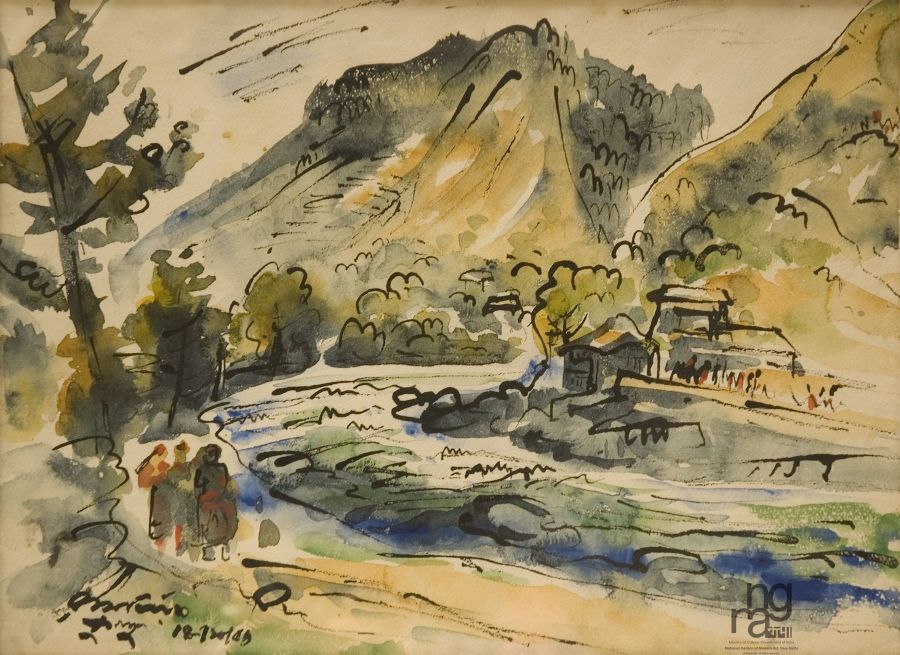 ×The first signs of progressing towards a more radical modernist language beyond post-impressionism can be seen in some of Ramkinkar's drawings from the late thirties and until the later years. Their general theme is landscape, and the motifs are primarily rows of trees and huts, interspersed at times with a few figures. In this particular painting, he has rendered a mountainous terrain with dabs and dashes of watercolour, with the individual forms harmoniously blending into each other.
×The first signs of progressing towards a more radical modernist language beyond post-impressionism can be seen in some of Ramkinkar's drawings from the late thirties and until the later years. Their general theme is landscape, and the motifs are primarily rows of trees and huts, interspersed at times with a few figures. In this particular painting, he has rendered a mountainous terrain with dabs and dashes of watercolour, with the individual forms harmoniously blending into each other. -
Nature Study & Landscape
 ×Ramkinkar Baij selected images for his sculptors and paintings from his rural surroundings. The poor and the downtrodden figured primarily as his subjects. Baij's watercolours mostly reflects his preoccupation with nature and the animal world. His work is characterized by tremendous energy, dynamism and the use of earthy colours. In the above painting, the artist has depicted a village scene with dabs and dashes of watercolour in tonal variation delineating the form.
×Ramkinkar Baij selected images for his sculptors and paintings from his rural surroundings. The poor and the downtrodden figured primarily as his subjects. Baij's watercolours mostly reflects his preoccupation with nature and the animal world. His work is characterized by tremendous energy, dynamism and the use of earthy colours. In the above painting, the artist has depicted a village scene with dabs and dashes of watercolour in tonal variation delineating the form. -
Nature Study & Landscape
 ×Ramkinkar deep felt love and oneness with nature could be seen in his vigorously painted and sculpted images of the animals, birds, flora and fauna in his surroundings. In this painting, he has depicted a tree having flowers, rendered with dabs and dashes of watercolour merging together in tonal variation and fluid strokes of ink delineating the forms and adding grace to the composition.
×Ramkinkar deep felt love and oneness with nature could be seen in his vigorously painted and sculpted images of the animals, birds, flora and fauna in his surroundings. In this painting, he has depicted a tree having flowers, rendered with dabs and dashes of watercolour merging together in tonal variation and fluid strokes of ink delineating the forms and adding grace to the composition. -
Nature Study & Landscape
 ×Ramkinkar Baij selected images for his sculptors and paintings from his rural surroundings. The poor and the downtrodden figured primarily as his subjects. Baij's watercolours mostly reflects his preoccupation with nature and the animal world. His work is characterized by tremendous energy, dynamism and the use of earthy colours. In the above painting, the artist has depicted grove of trees with dabs and dashes of watercolour in tonal variation delineating the form.
×Ramkinkar Baij selected images for his sculptors and paintings from his rural surroundings. The poor and the downtrodden figured primarily as his subjects. Baij's watercolours mostly reflects his preoccupation with nature and the animal world. His work is characterized by tremendous energy, dynamism and the use of earthy colours. In the above painting, the artist has depicted grove of trees with dabs and dashes of watercolour in tonal variation delineating the form. -
Nature Study & Landscape
 ×Ramkinkar's deep felt love and oneness with nature could be seen in his vigorously painted and sculpted images of the animals, birds, flora and fauna in his surroundings. In this painting, he has depicted a snow-covered peak, rendered with dabs and dashes of watercolour merging together in tonal variations and fluid strokes of ink delineating the forms.
×Ramkinkar's deep felt love and oneness with nature could be seen in his vigorously painted and sculpted images of the animals, birds, flora and fauna in his surroundings. In this painting, he has depicted a snow-covered peak, rendered with dabs and dashes of watercolour merging together in tonal variations and fluid strokes of ink delineating the forms. -
Nature Study & Landscape
 ×Ramkinkar deep felt love and oneness with nature could be seen in his vigorously painted and sculpted images of the animals, birds, flora and fauna in his surroundings. In this painting, he has depicted a landscape, rendered with dabs and dashes of watercolour merging together in tonal variation and fluid strokes of ink delineating the forms and adding grace to the composition.
×Ramkinkar deep felt love and oneness with nature could be seen in his vigorously painted and sculpted images of the animals, birds, flora and fauna in his surroundings. In this painting, he has depicted a landscape, rendered with dabs and dashes of watercolour merging together in tonal variation and fluid strokes of ink delineating the forms and adding grace to the composition. -
Nature Study & Landscape
 ×Ramkinkar deep felt love and oneness with nature could be seen in his vigorously painted and sculpted images of the animals, birds, flora and fauna in his surroundings. In this painting, he has depicted a tree having flowers, rendered with dabs and dashes of watercolour merging together in tonal variation and fluid strokes of ink delineating the forms and adding grace to the composition.
×Ramkinkar deep felt love and oneness with nature could be seen in his vigorously painted and sculpted images of the animals, birds, flora and fauna in his surroundings. In this painting, he has depicted a tree having flowers, rendered with dabs and dashes of watercolour merging together in tonal variation and fluid strokes of ink delineating the forms and adding grace to the composition. -
Nature Study & Landscape
 ×Ramkinkar Baij was immensely influenced by his austere surrounding, the ordinary people and the nature that became his subject matter for painting and sculpture. In this painting, he has depicted a serene landscape, rendered with swift strokes of watercolor delineating the forms.
×Ramkinkar Baij was immensely influenced by his austere surrounding, the ordinary people and the nature that became his subject matter for painting and sculpture. In this painting, he has depicted a serene landscape, rendered with swift strokes of watercolor delineating the forms. -
Nature Study & Landscape
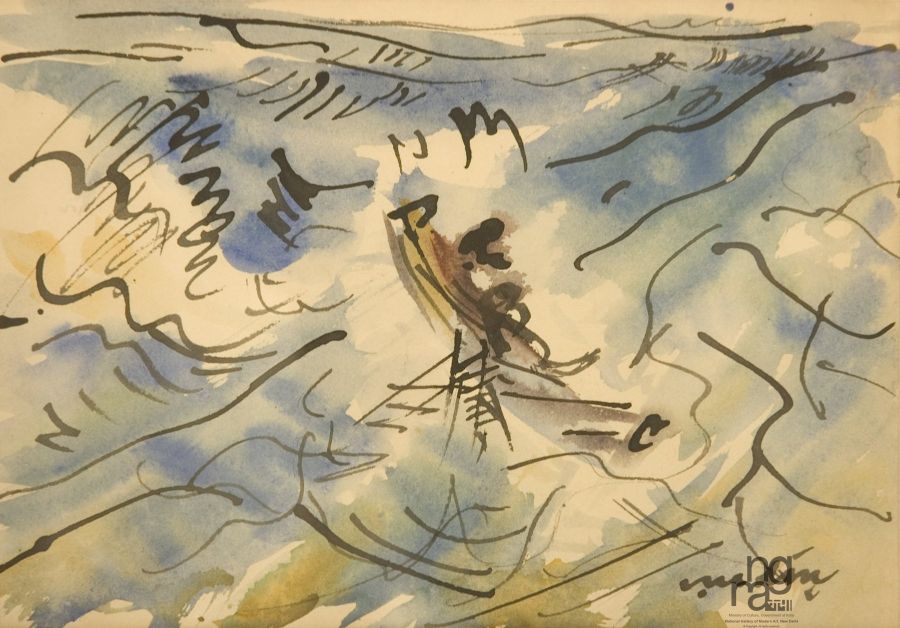 ×Ramkinkar Baij selected images for his sculptors and paintings from his rural surroundings. The poor and the downtrodden figured primarily as his subjects. Baij's watercolours mostly reflects his preoccupation with nature and the animal world. His work is characterized by tremendous energy, dynamism and the use of earthy colours. In the above painting, the artist has rendered a seascape with high waves and a boat with light washes of watercolour in tonal variation creating the natural form of the sea and adding depth in the composition.
×Ramkinkar Baij selected images for his sculptors and paintings from his rural surroundings. The poor and the downtrodden figured primarily as his subjects. Baij's watercolours mostly reflects his preoccupation with nature and the animal world. His work is characterized by tremendous energy, dynamism and the use of earthy colours. In the above painting, the artist has rendered a seascape with high waves and a boat with light washes of watercolour in tonal variation creating the natural form of the sea and adding depth in the composition. -
Nature Study & Landscape
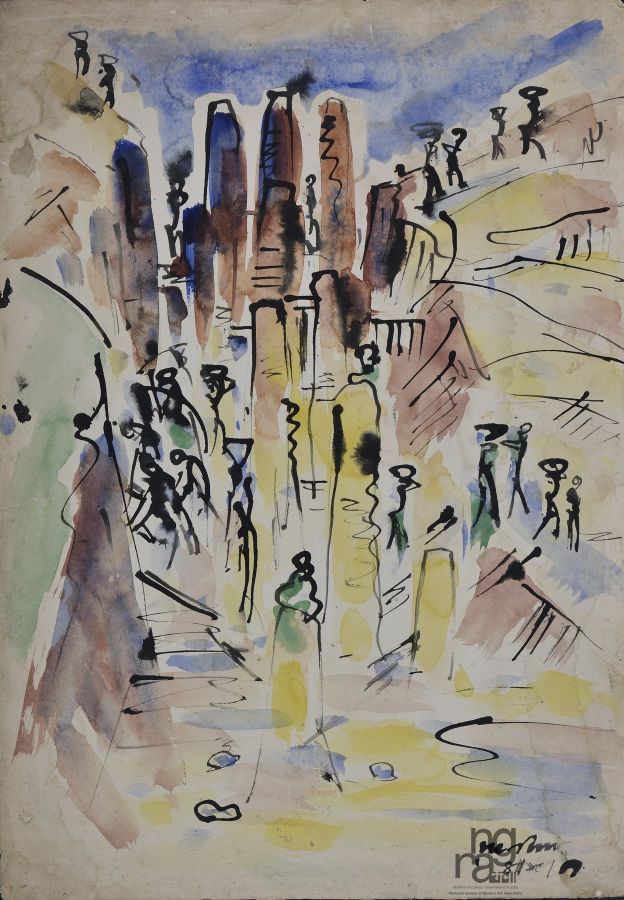 ×Ramkinkar Baij was a reclusive modernist artist who always remained on the fringes of the art market. He took a great interest in human figures, body language and in the general human drama. Modern Western art and pre and post-classical Indian art were his main points of reference. Although primarily known for his expressionistic sculpture, he was also a gifted painter. The sense of rhythm that his sculpture was noted for is manifested brilliantly in his paintings and sketches. His works in the Kalighat tradition interconnected with Cubism to achieve an unusual personal idiom. Both his sculpture and his paintings are unprompted and bold.
×Ramkinkar Baij was a reclusive modernist artist who always remained on the fringes of the art market. He took a great interest in human figures, body language and in the general human drama. Modern Western art and pre and post-classical Indian art were his main points of reference. Although primarily known for his expressionistic sculpture, he was also a gifted painter. The sense of rhythm that his sculpture was noted for is manifested brilliantly in his paintings and sketches. His works in the Kalighat tradition interconnected with Cubism to achieve an unusual personal idiom. Both his sculpture and his paintings are unprompted and bold. -
Nature Study & Landscape
 ×Ramkinkar deep felt love and oneness with nature could be seen in his vigorously painted and sculpted images of the animals, birds, flora and fauna in his surroundings. In this painting, he has depicted a lotus pond, rendered with dabs and dashes of watercolour merging together in tonal variation and fluid strokes of ink delineating the forms and adding grace to the composition.
×Ramkinkar deep felt love and oneness with nature could be seen in his vigorously painted and sculpted images of the animals, birds, flora and fauna in his surroundings. In this painting, he has depicted a lotus pond, rendered with dabs and dashes of watercolour merging together in tonal variation and fluid strokes of ink delineating the forms and adding grace to the composition. -
Nature Study & Landscape
 ×Ramkinkar Baij was a reclusive modernist artist who always remained on the fringes of the art market. He took a great interest in human figures, body language and in the general human drama. Modern Western art and pre and post-classical Indian art were his main points of reference. Although primarily known for his expressionistic sculpture, he was also a gifted painter. The sense of rhythm that his sculpture was noted for is manifested brilliantly in his paintings and sketches. His works in the Kalighat tradition interconnected with Cubism to achieve an unusual personal idiom. Both his sculpture and his paintings are unprompted and bold.
×Ramkinkar Baij was a reclusive modernist artist who always remained on the fringes of the art market. He took a great interest in human figures, body language and in the general human drama. Modern Western art and pre and post-classical Indian art were his main points of reference. Although primarily known for his expressionistic sculpture, he was also a gifted painter. The sense of rhythm that his sculpture was noted for is manifested brilliantly in his paintings and sketches. His works in the Kalighat tradition interconnected with Cubism to achieve an unusual personal idiom. Both his sculpture and his paintings are unprompted and bold. -
Nature Study & Landscape
 ×Ramkinkar Baij was a reclusive modernist artist who always remained on the fringes of the art market. He took a great interest in human figures, body language and in the general human drama. Modern Western art and pre and post-classical Indian art were his main points of reference. Although primarily known for his expressionistic sculpture, he was also a gifted painter. The sense of rhythm that his sculpture was noted for is manifested brilliantly in his paintings and sketches. His works in the Kalighat tradition interconnected with Cubism to achieve an unusual personal idiom. Both his sculpture and his paintings are unprompted and bold.
×Ramkinkar Baij was a reclusive modernist artist who always remained on the fringes of the art market. He took a great interest in human figures, body language and in the general human drama. Modern Western art and pre and post-classical Indian art were his main points of reference. Although primarily known for his expressionistic sculpture, he was also a gifted painter. The sense of rhythm that his sculpture was noted for is manifested brilliantly in his paintings and sketches. His works in the Kalighat tradition interconnected with Cubism to achieve an unusual personal idiom. Both his sculpture and his paintings are unprompted and bold. -
Nature Study & Landscape
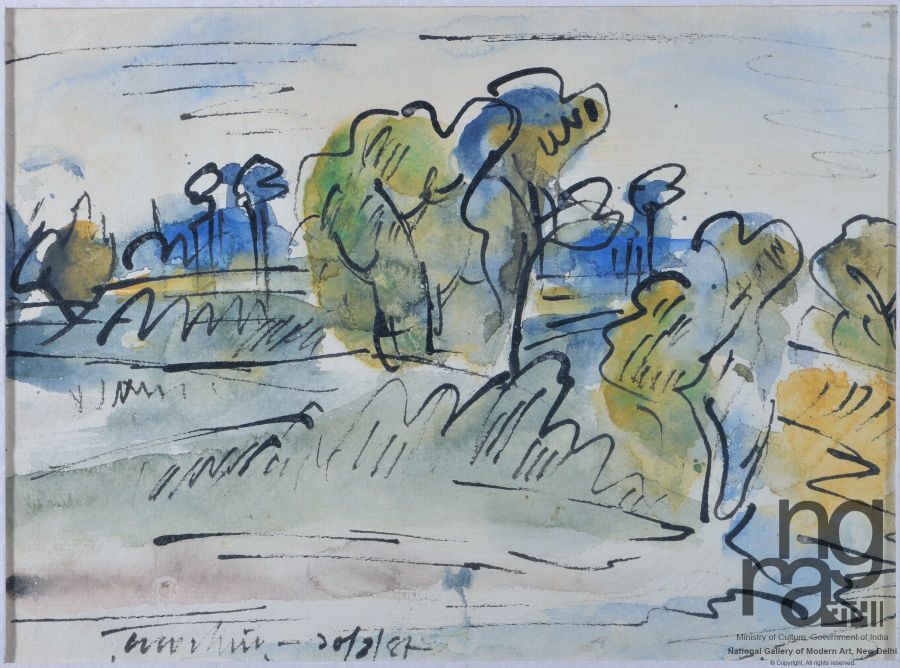 ×Ramkinker Baijís artistic temperament was defined at Santinekitan an art institution known for providing an informed western modernistic environment to the students. Baij was immensely influenced by his austere surrounding, the ordinary people and the nature that it became its subject matter for painting and sculpture. In the above painting the artist, has depicted a landscape delineated with dabs and dashes of watercolour, outlined with black strokes. The treatment is intended to exemplify an energetic and lively artistic temperament.
×Ramkinker Baijís artistic temperament was defined at Santinekitan an art institution known for providing an informed western modernistic environment to the students. Baij was immensely influenced by his austere surrounding, the ordinary people and the nature that it became its subject matter for painting and sculpture. In the above painting the artist, has depicted a landscape delineated with dabs and dashes of watercolour, outlined with black strokes. The treatment is intended to exemplify an energetic and lively artistic temperament. -
Nature Study & Landscape
 ×Ramkinkar deep felt love and oneness with nature could be seen in his vigorously painted and sculpted images of the animals, birds, flora and fauna in his surroundings. In this painting, he has depicted a landscape with huts and trees, rendered with dabs and dashes of watercolour merging together in tonal variation and fluid strokes of ink delineating the forms and adding grace to the composition.
×Ramkinkar deep felt love and oneness with nature could be seen in his vigorously painted and sculpted images of the animals, birds, flora and fauna in his surroundings. In this painting, he has depicted a landscape with huts and trees, rendered with dabs and dashes of watercolour merging together in tonal variation and fluid strokes of ink delineating the forms and adding grace to the composition. -
Nature Study & Landscape

A Boat and the Waves Acc. No. 4287 | Watercolor on Paper
-
Nature Study & Landscape
 ×Ramkinkar Baij was a reclusive modernist artist who always remained on the fringes of the art market. He took a great interest in human figures, body language and in the general human drama. Modern Western art and pre and post-classical Indian art were his main points of reference. Although primarily known for his expressionistic sculpture, he was also a gifted painter. The sense of rhythm that his sculpture was noted for is manifested brilliantly in his paintings and sketches. His works in the Kalighat tradition interconnected with Cubism to achieve an unusual personal idiom. Both his sculpture and his paintings are unprompted and bold.
×Ramkinkar Baij was a reclusive modernist artist who always remained on the fringes of the art market. He took a great interest in human figures, body language and in the general human drama. Modern Western art and pre and post-classical Indian art were his main points of reference. Although primarily known for his expressionistic sculpture, he was also a gifted painter. The sense of rhythm that his sculpture was noted for is manifested brilliantly in his paintings and sketches. His works in the Kalighat tradition interconnected with Cubism to achieve an unusual personal idiom. Both his sculpture and his paintings are unprompted and bold. -
Nature Study & Landscape
 ×Ramkinkar Baij was a reclusive modernist artist who always remained on the fringes of the art market. He took a great interest in human figures, body language and in the general human drama. Modern Western art and pre and post-classical Indian art were his main points of reference. Although primarily known for his expressionistic sculpture, he was also a gifted painter. The sense of rhythm that his sculpture was noted for is manifested brilliantly in his paintings and sketches. His works in the Kalighat tradition interconnected with Cubism to achieve an unusual personal idiom. Both his sculpture and his paintings are unprompted and bold.
×Ramkinkar Baij was a reclusive modernist artist who always remained on the fringes of the art market. He took a great interest in human figures, body language and in the general human drama. Modern Western art and pre and post-classical Indian art were his main points of reference. Although primarily known for his expressionistic sculpture, he was also a gifted painter. The sense of rhythm that his sculpture was noted for is manifested brilliantly in his paintings and sketches. His works in the Kalighat tradition interconnected with Cubism to achieve an unusual personal idiom. Both his sculpture and his paintings are unprompted and bold. -
Nature Study & Landscape
 ×Ramkinkar Baij was a reclusive modernist artist who always remained on the fringes of the art market. He took a great interest in human figures, body language and in the general human drama. Modern Western art and pre and post-classical Indian art were his main points of reference. Although primarily known for his expressionistic sculpture, he was also a gifted painter. The sense of rhythm that his sculpture was noted for is manifested brilliantly in his paintings and sketches. His works in the Kalighat tradition interconnected with Cubism to achieve an unusual personal idiom. Both his sculpture and his paintings are unprompted and bold.
×Ramkinkar Baij was a reclusive modernist artist who always remained on the fringes of the art market. He took a great interest in human figures, body language and in the general human drama. Modern Western art and pre and post-classical Indian art were his main points of reference. Although primarily known for his expressionistic sculpture, he was also a gifted painter. The sense of rhythm that his sculpture was noted for is manifested brilliantly in his paintings and sketches. His works in the Kalighat tradition interconnected with Cubism to achieve an unusual personal idiom. Both his sculpture and his paintings are unprompted and bold. -
Nature Study & Landscape
 ×Ramkinkar Baij was a reclusive modernist artist who always remained on the fringes of the art market. He took a great interest in human figures, body language and in the general human drama. Modern Western art and pre and post-classical Indian art were his main points of reference. Although primarily known for his expressionistic sculpture, he was also a gifted painter. The sense of rhythm that his sculpture was noted for is manifested brilliantly in his paintings and sketches. His works in the Kalighat tradition interconnected with Cubism to achieve an unusual personal idiom. Both his sculpture and his paintings are unprompted and bold.
×Ramkinkar Baij was a reclusive modernist artist who always remained on the fringes of the art market. He took a great interest in human figures, body language and in the general human drama. Modern Western art and pre and post-classical Indian art were his main points of reference. Although primarily known for his expressionistic sculpture, he was also a gifted painter. The sense of rhythm that his sculpture was noted for is manifested brilliantly in his paintings and sketches. His works in the Kalighat tradition interconnected with Cubism to achieve an unusual personal idiom. Both his sculpture and his paintings are unprompted and bold. -
Nature Study & Landscape
 ×Ramkinkar Baij selected images for his sculptors and paintings from his rural surroundings. The poor and the downtrodden figured primarily as his subjects. Baij's watercolours mostly reflects his preoccupation with nature and the animal world. His work is characterized by tremendous energy, dynamism and the use of earthy colours. In the above painting, the artist depicts a landscape rendered with dabs and dashes of watercolour in tonal variation delineating the form.
×Ramkinkar Baij selected images for his sculptors and paintings from his rural surroundings. The poor and the downtrodden figured primarily as his subjects. Baij's watercolours mostly reflects his preoccupation with nature and the animal world. His work is characterized by tremendous energy, dynamism and the use of earthy colours. In the above painting, the artist depicts a landscape rendered with dabs and dashes of watercolour in tonal variation delineating the form. -
Nature Study & Landscape
 ×Ramkinkar Baij selected images for his sculptors and paintings from his rural surroundings. The poor and the downtrodden figured primarily as his subjects. Baij's watercolours mostly reflect his preoccupation with nature and the animal world. His work is characterized by tremendous energy, dynamism and the use of earthy colours. In the above painting, the artist has depicted a grove of trees with dabs and dashes of watercolour in tonal variation delineating the form.
×Ramkinkar Baij selected images for his sculptors and paintings from his rural surroundings. The poor and the downtrodden figured primarily as his subjects. Baij's watercolours mostly reflect his preoccupation with nature and the animal world. His work is characterized by tremendous energy, dynamism and the use of earthy colours. In the above painting, the artist has depicted a grove of trees with dabs and dashes of watercolour in tonal variation delineating the form. -
Nature Study & Landscape
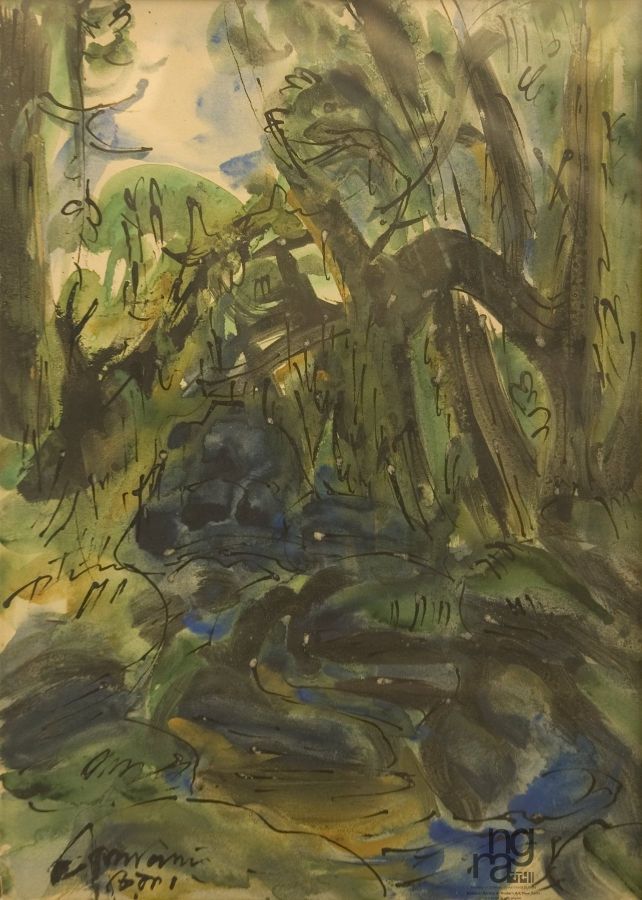 ×Ramkinkar Baij selected images for his sculptors and paintings from his rural surroundings. The poor and the downtrodden figured primarily as his subjects. Baij's watercolours mostly reflect his preoccupation with nature and the animal world. His work is characterized by tremendous energy, dynamism and the use of earthy colours. In the above painting, the artist has depicted a landscape with trees and rocks in the foreground with dabs and dashes of watercolour in tonal variation delineating the form.
×Ramkinkar Baij selected images for his sculptors and paintings from his rural surroundings. The poor and the downtrodden figured primarily as his subjects. Baij's watercolours mostly reflect his preoccupation with nature and the animal world. His work is characterized by tremendous energy, dynamism and the use of earthy colours. In the above painting, the artist has depicted a landscape with trees and rocks in the foreground with dabs and dashes of watercolour in tonal variation delineating the form. -
Nature Study & Landscape
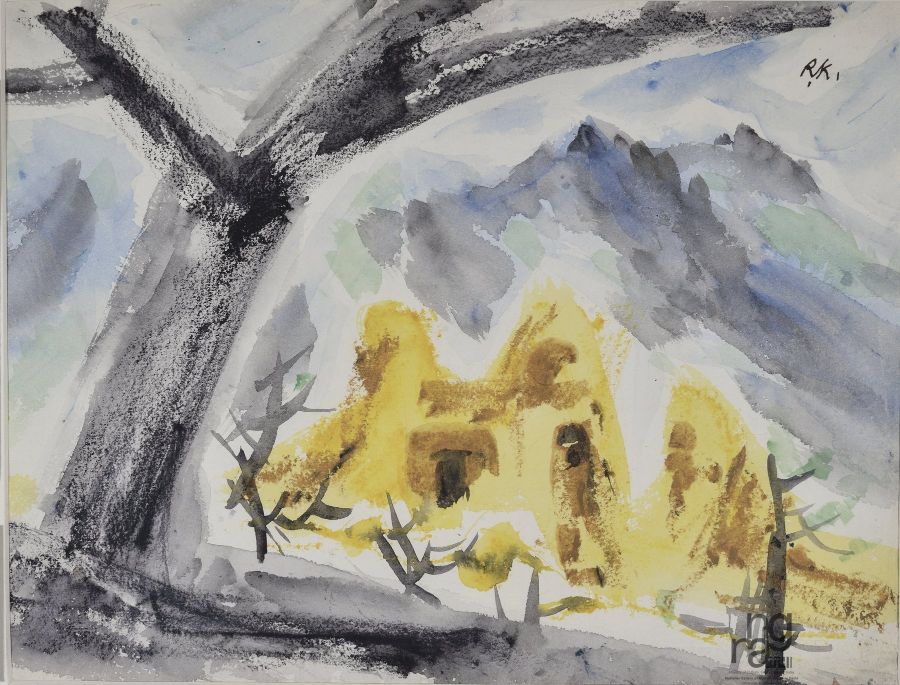 ×Ramkinkar deep felt love and oneness with nature could be seen in his vigorously painted and sculpted images of the animals, birds, flora and fauna in his surroundings. In this painting, he has depicted a landscape having trees and mountain, rendered with fluid, swift strokes of watercolour in tonal variation delineating the forms and adding grace to the composition.
×Ramkinkar deep felt love and oneness with nature could be seen in his vigorously painted and sculpted images of the animals, birds, flora and fauna in his surroundings. In this painting, he has depicted a landscape having trees and mountain, rendered with fluid, swift strokes of watercolour in tonal variation delineating the forms and adding grace to the composition. -
Nature Study & Landscape
 ×Ramkinkar Baij selected images for his sculptors and paintings from his rural surroundings. The poor and the downtrodden figured primarily as his subjects. Baij's watercolours mostly reflect his preoccupation with nature and the animal world. His work is characterized by tremendous energy, dynamism and the use of earthy colours. In the above painting, the artist has depicted a landscape with dabs and dashes of watercolour in tonal variation delineating the form.
×Ramkinkar Baij selected images for his sculptors and paintings from his rural surroundings. The poor and the downtrodden figured primarily as his subjects. Baij's watercolours mostly reflect his preoccupation with nature and the animal world. His work is characterized by tremendous energy, dynamism and the use of earthy colours. In the above painting, the artist has depicted a landscape with dabs and dashes of watercolour in tonal variation delineating the form. -
Nature Study & Landscape
 ×Ramkinkar deep felt love and oneness with nature could be seen in his vigorously painted and sculpted images of the animals, birds, flora and fauna in his surroundings. In this painting, he has depicted a landscape, rendered with dabs and dashes of watercolour merging together in tonal variation and fluid strokes of ink delineating the forms and adding grace to the composition.
×Ramkinkar deep felt love and oneness with nature could be seen in his vigorously painted and sculpted images of the animals, birds, flora and fauna in his surroundings. In this painting, he has depicted a landscape, rendered with dabs and dashes of watercolour merging together in tonal variation and fluid strokes of ink delineating the forms and adding grace to the composition. -
Nature Study & Landscape
 ×Ramkinkar deep felt love and oneness with nature could be seen in his vigorously painted and sculpted images of the animals, birds, flora and fauna in his surroundings. In this painting, he has depicted a landscape, rendered with dabs and dashes of watercolour merging together in tonal variation and fluid strokes of ink delineating the forms and adding grace to the composition.
×Ramkinkar deep felt love and oneness with nature could be seen in his vigorously painted and sculpted images of the animals, birds, flora and fauna in his surroundings. In this painting, he has depicted a landscape, rendered with dabs and dashes of watercolour merging together in tonal variation and fluid strokes of ink delineating the forms and adding grace to the composition. -
Nature Study & Landscape
 ×Ramkinkar Baij selected images for his sculptures and paintings from his rural surroundings. The poor and the downtrodden figured primarily as his subjects. Baij's watercolours mostly reflect his preoccupation with nature and the animal world. His work is characterized by tremendous energy, dynamism and the use of earthy colours. In the above painting, the artist has depicted a flowering tree with dabs and dashes of watercolour in tonal variation delineating the form.
×Ramkinkar Baij selected images for his sculptures and paintings from his rural surroundings. The poor and the downtrodden figured primarily as his subjects. Baij's watercolours mostly reflect his preoccupation with nature and the animal world. His work is characterized by tremendous energy, dynamism and the use of earthy colours. In the above painting, the artist has depicted a flowering tree with dabs and dashes of watercolour in tonal variation delineating the form. -
Nature Study & Landscape
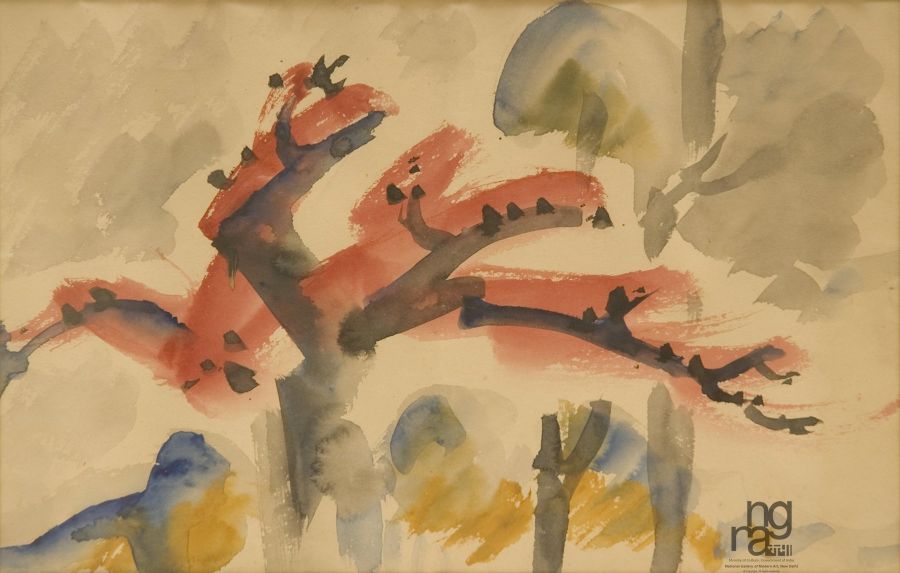 ×Ramkinkar Baij selected images for his sculptors and paintings from his rural surroundings. The poor and the downtrodden figured primarily as his subjects. Baij's watercolours mostly reflects his preoccupation with nature and the animal world. His work is characterized by tremendous energy, dynamism and the use of earthy colours. In the above painting, the artist has depicted a flowering tree with dabs and dashes of watercolour in tonal variation delineating the form.
×Ramkinkar Baij selected images for his sculptors and paintings from his rural surroundings. The poor and the downtrodden figured primarily as his subjects. Baij's watercolours mostly reflects his preoccupation with nature and the animal world. His work is characterized by tremendous energy, dynamism and the use of earthy colours. In the above painting, the artist has depicted a flowering tree with dabs and dashes of watercolour in tonal variation delineating the form. -
Nature Study & Landscape
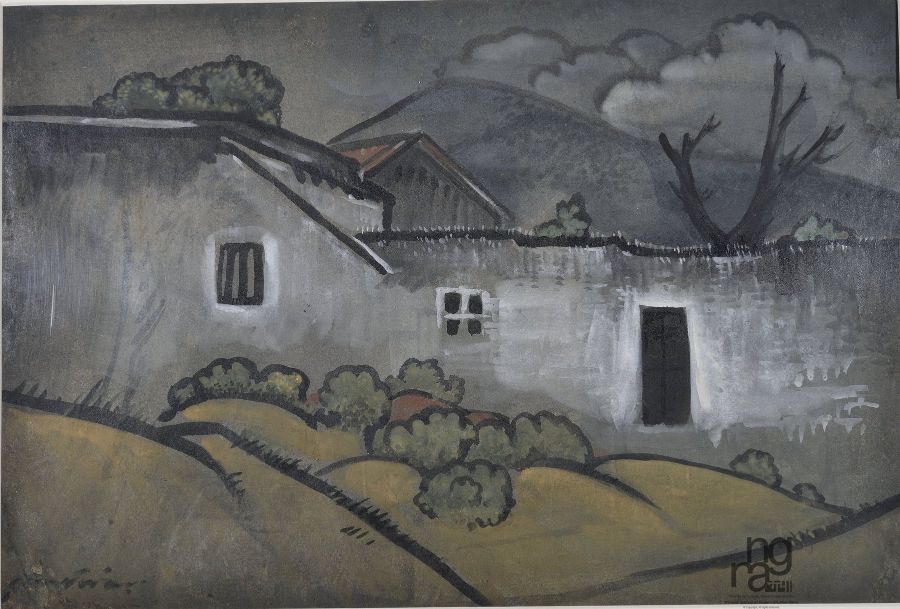 ×Ramkinkar was well aware of the post-industrial art or modern art movements in the western and eastern art worlds and tried to incorporate the dynamics of such changes in his own work while keeping the aesthetic tradition of Santiniketan in focus. In the above painting, he has depicted a house in a village setting, rendered with the use of earthen colours in tonal variation delineating the forms and adding depth in the composition.
×Ramkinkar was well aware of the post-industrial art or modern art movements in the western and eastern art worlds and tried to incorporate the dynamics of such changes in his own work while keeping the aesthetic tradition of Santiniketan in focus. In the above painting, he has depicted a house in a village setting, rendered with the use of earthen colours in tonal variation delineating the forms and adding depth in the composition. -
Nature Study & Landscape
 ×Ramkinkar Baij was a reclusive modernist artist who always remained on the fringes of the art market. He took a great interest in human figures, body language and in the general human drama. Modern Western art and pre and post-classical Indian art were his main points of reference. Although primarily known for his expressionistic sculpture, he was also a gifted painter. The sense of rhythm that his sculpture was noted for is manifested brilliantly in his paintings and sketches. His works in the Kalighat tradition interconnected with Cubism to achieve an unusual personal idiom. Both his sculpture and his paintings are unprompted and bold.
×Ramkinkar Baij was a reclusive modernist artist who always remained on the fringes of the art market. He took a great interest in human figures, body language and in the general human drama. Modern Western art and pre and post-classical Indian art were his main points of reference. Although primarily known for his expressionistic sculpture, he was also a gifted painter. The sense of rhythm that his sculpture was noted for is manifested brilliantly in his paintings and sketches. His works in the Kalighat tradition interconnected with Cubism to achieve an unusual personal idiom. Both his sculpture and his paintings are unprompted and bold. -
Nature Study & Landscape
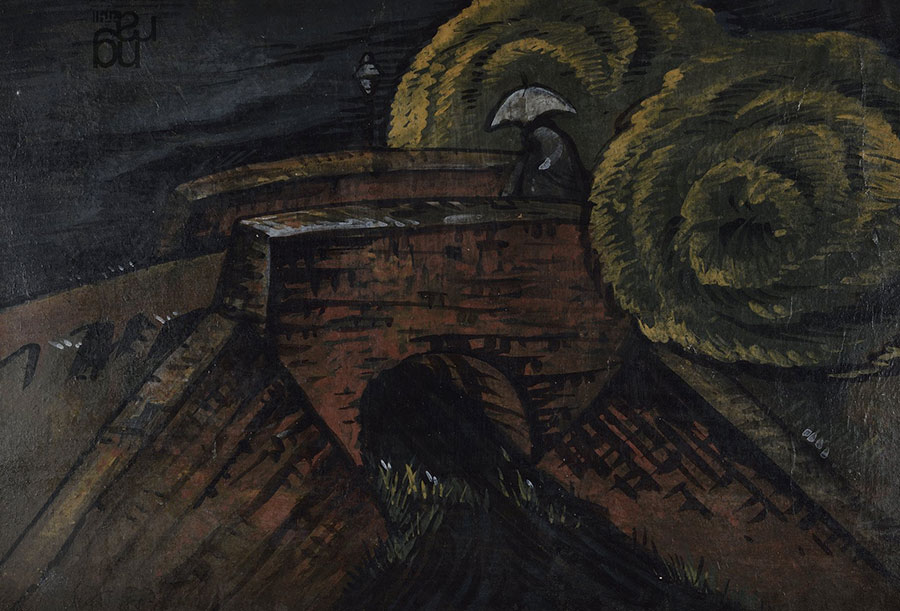 ×Ramkinkar was well aware of the post-industrial art or modern art movements in the western and eastern art worlds and tried to incorporate the dynamics of such changes in his own work while keeping the aesthetic tradition of Santiniketan in focus. In the above painting, he has depicted a man walking on the bridge, rendered with the use of earthen colours in tonal variation delineating the forms and adding depth in the composition.
×Ramkinkar was well aware of the post-industrial art or modern art movements in the western and eastern art worlds and tried to incorporate the dynamics of such changes in his own work while keeping the aesthetic tradition of Santiniketan in focus. In the above painting, he has depicted a man walking on the bridge, rendered with the use of earthen colours in tonal variation delineating the forms and adding depth in the composition. -
Nature Study & Landscape
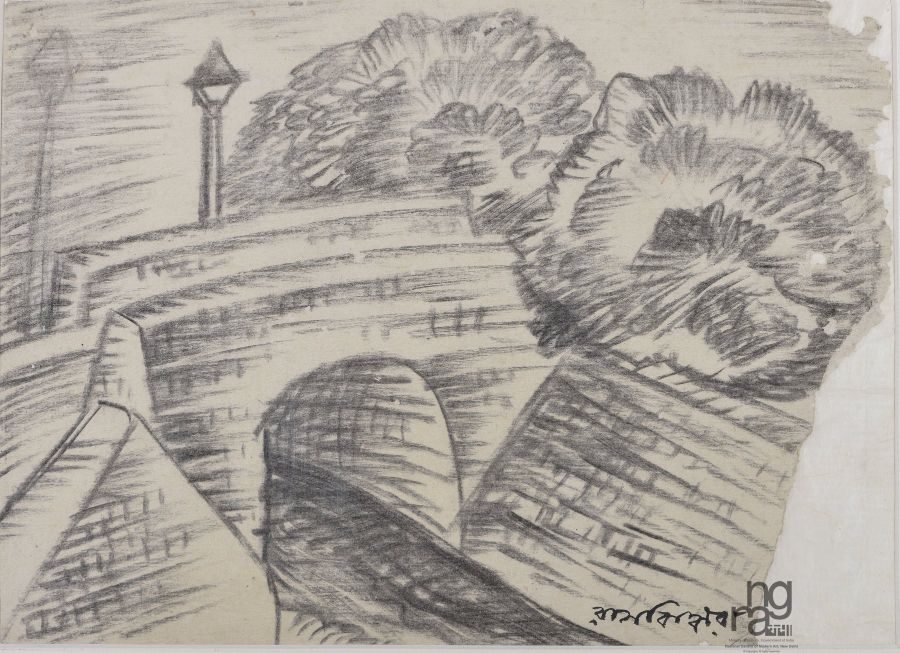 ×Ramkinkar Baij selected images for his sculptures and paintings from his rural surroundings. The poor and the downtrodden figured primarily as his subjects. Baij's watercolours mostly reflect his preoccupation with nature and the animal world. His work is characterized by tremendous energy, dynamism and the use of earthy colours. In the above painting, the artist has depicted a bridge with dabs and dashes of watercolour in tonal variation delineating the form.
×Ramkinkar Baij selected images for his sculptures and paintings from his rural surroundings. The poor and the downtrodden figured primarily as his subjects. Baij's watercolours mostly reflect his preoccupation with nature and the animal world. His work is characterized by tremendous energy, dynamism and the use of earthy colours. In the above painting, the artist has depicted a bridge with dabs and dashes of watercolour in tonal variation delineating the form. -
Nature Study & Landscape
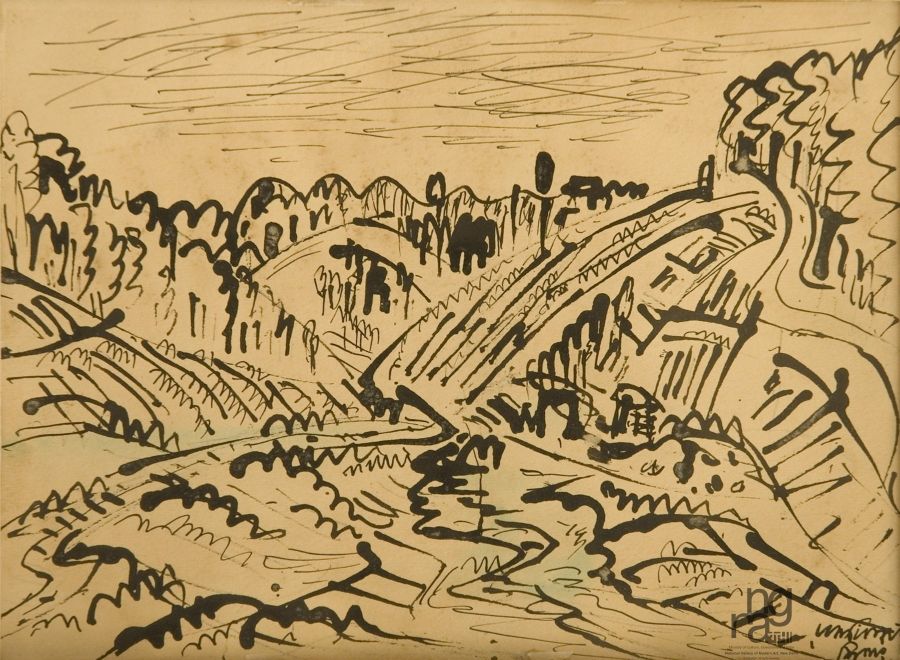 ×Ramkinkar Baij selected images for his sculptors and paintings from his rural surroundings. The poor and the downtrodden figured primarily as his subjects. His work is characterized by tremendous energy, dynamism and the use of earthy colours. In this sketch, the artist has depicted a landscape, rendered with fluid, fine lines of pen and ink delineating the form.
×Ramkinkar Baij selected images for his sculptors and paintings from his rural surroundings. The poor and the downtrodden figured primarily as his subjects. His work is characterized by tremendous energy, dynamism and the use of earthy colours. In this sketch, the artist has depicted a landscape, rendered with fluid, fine lines of pen and ink delineating the form. -
Nature Study & Landscape
 ×Ramkinkar Baijís artistic temperament was defined at Santiniketan an art institution known for providing an informed western modernistic environment to the students. Baij was immensely influenced by his austere surroundings, the ordinary people and nature that became the subject matter for painting, sculpture and printmaking. The above print depicts a man walking on a street. The composition is rendered with linear, firm yet fluid strokes incised on to a metal sheet. The lines are then transferred on the plain surface with the help of ink delineating the contours and suggesting the demeanour of the subject.
×Ramkinkar Baijís artistic temperament was defined at Santiniketan an art institution known for providing an informed western modernistic environment to the students. Baij was immensely influenced by his austere surroundings, the ordinary people and nature that became the subject matter for painting, sculpture and printmaking. The above print depicts a man walking on a street. The composition is rendered with linear, firm yet fluid strokes incised on to a metal sheet. The lines are then transferred on the plain surface with the help of ink delineating the contours and suggesting the demeanour of the subject. -
Nature Study & Landscape
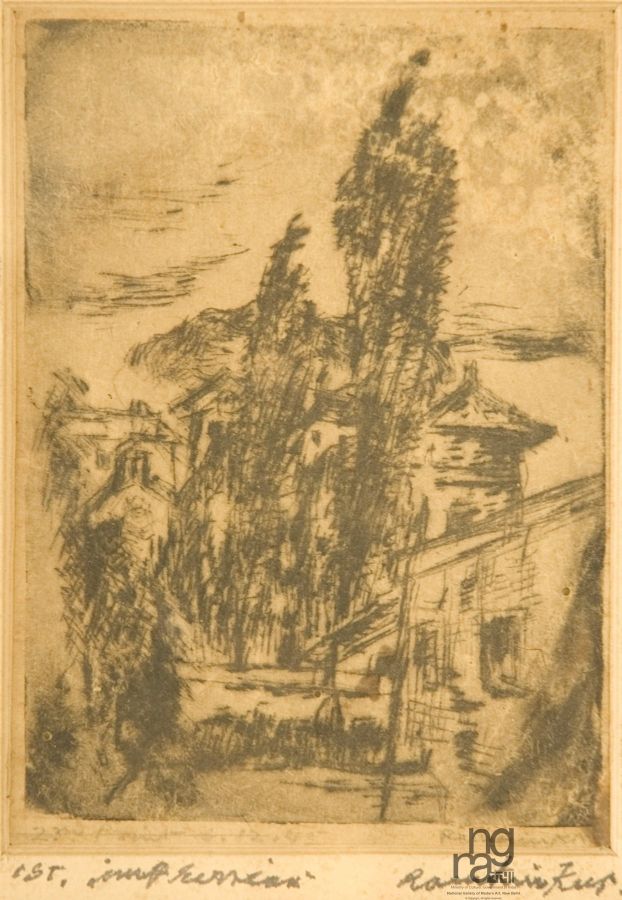 ×Ramkinkar Baijís artistic temperament was defined at Santiniketan an art institution known for providing an informed western modernistic environment to the students. Baij was immensely influenced by his austere surroundings, the ordinary people and nature that became the subject matter for painting, sculpture and printmaking. The above print depicts a hill town, rendered with linear, firm yet fluid strokes incised on to a metal sheet. The lines are then transferred on the plain surface with the help of ink delineating the hills.
×Ramkinkar Baijís artistic temperament was defined at Santiniketan an art institution known for providing an informed western modernistic environment to the students. Baij was immensely influenced by his austere surroundings, the ordinary people and nature that became the subject matter for painting, sculpture and printmaking. The above print depicts a hill town, rendered with linear, firm yet fluid strokes incised on to a metal sheet. The lines are then transferred on the plain surface with the help of ink delineating the hills. -
Nature Study & Landscape
 ×Ramkinkar Baijís artistic temperament was defined at Santiniketan an art institution known for providing an informed western modernistic environment to the students. Baij was immensely influenced by his austere surroundings, the ordinary people and nature that became the subject matter for painting, sculpture and printmaking. The above print depicts bushes behind the fence. The composition is rendered with linear, firm yet fluid strokes incised on to a metal sheet. The lines are then transferred on the plain surface with the help of ink delineating the forms and suggesting the demeanour of the subject.
×Ramkinkar Baijís artistic temperament was defined at Santiniketan an art institution known for providing an informed western modernistic environment to the students. Baij was immensely influenced by his austere surroundings, the ordinary people and nature that became the subject matter for painting, sculpture and printmaking. The above print depicts bushes behind the fence. The composition is rendered with linear, firm yet fluid strokes incised on to a metal sheet. The lines are then transferred on the plain surface with the help of ink delineating the forms and suggesting the demeanour of the subject. -
Nature Study & Landscape
 ×Ramkinkar Baij was a reclusive modernist artist who always remained on the fringes of the art market. He took a great interest in human figures, body language and in the general human drama. Modern Western art and pre and post-classical Indian art were his main points of reference. Although primarily known for his expressionistic sculpture, he was also a gifted painter. The sense of rhythm that his sculpture was noted for is manifested brilliantly in his paintings and sketches. His works in the Kalighat tradition interconnected with Cubism to achieve an unusual personal idiom. Both his sculpture and his paintings are unprompted and bold.
×Ramkinkar Baij was a reclusive modernist artist who always remained on the fringes of the art market. He took a great interest in human figures, body language and in the general human drama. Modern Western art and pre and post-classical Indian art were his main points of reference. Although primarily known for his expressionistic sculpture, he was also a gifted painter. The sense of rhythm that his sculpture was noted for is manifested brilliantly in his paintings and sketches. His works in the Kalighat tradition interconnected with Cubism to achieve an unusual personal idiom. Both his sculpture and his paintings are unprompted and bold. -
Nature Study & Landscape
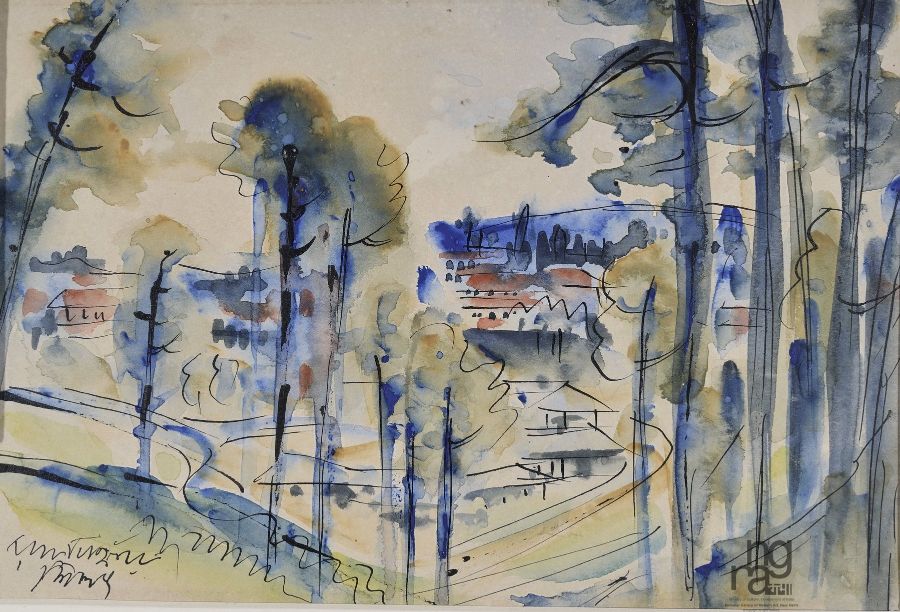 ×Ramkinkar Baij selected images for his sculptures and paintings from his rural surroundings. The poor and the downtrodden figured primarily as his subjects. Baij's watercolours mostly reflect his preoccupation with nature and the animal world. His work is characterized by tremendous energy, dynamism and the use of earthy colours. In the above painting, the artist has depicted a landscape with dabs and dashes of watercolour in tonal variation delineating the form.
×Ramkinkar Baij selected images for his sculptures and paintings from his rural surroundings. The poor and the downtrodden figured primarily as his subjects. Baij's watercolours mostly reflect his preoccupation with nature and the animal world. His work is characterized by tremendous energy, dynamism and the use of earthy colours. In the above painting, the artist has depicted a landscape with dabs and dashes of watercolour in tonal variation delineating the form. -
Nature Study & Landscape
 ×Ramkinkar Baij was immensely influenced by his austere surrounding, the ordinary people and the nature that became his subject matter for painting and sculpture. In this painting, he has depicted a rice mill, rendered with swift strokes of watercolor delineating the forms.
×Ramkinkar Baij was immensely influenced by his austere surrounding, the ordinary people and the nature that became his subject matter for painting and sculpture. In this painting, he has depicted a rice mill, rendered with swift strokes of watercolor delineating the forms. -
Nature Study & Landscape
 ×Ramkinkar deep felt love and oneness with nature could be seen in his vigorously painted and sculpted images of the animals, birds, flora and fauna in his surroundings. In this painting, he has depicted a landscape having trees over a mountain, rendered with fluid, swift strokes of watercolour in tonal variation delineating the forms and adding grace to the composition.
×Ramkinkar deep felt love and oneness with nature could be seen in his vigorously painted and sculpted images of the animals, birds, flora and fauna in his surroundings. In this painting, he has depicted a landscape having trees over a mountain, rendered with fluid, swift strokes of watercolour in tonal variation delineating the forms and adding grace to the composition. -
Nature Study & Landscape
 ×Ramkinkar Baij was immensely influenced by his austere surrounding, the ordinary people and the nature that became his subject matter for painting and sculpture. In this painting, he has depicted a serene landscape, rendered with swift strokes of watercolor delineating the forms.
×Ramkinkar Baij was immensely influenced by his austere surrounding, the ordinary people and the nature that became his subject matter for painting and sculpture. In this painting, he has depicted a serene landscape, rendered with swift strokes of watercolor delineating the forms. -
Nature Study & Landscape
 ×Ramkinkar Baij was a reclusive modernist artist who always remained on the fringes of the art market. He took a great interest in human figures, body language and in the general human drama. Modern Western art and pre and post-classical Indian art were his main points of reference. Although primarily known for his expressionistic sculpture, he was also a gifted painter. The sense of rhythm that his sculpture was noted for is manifested brilliantly in his paintings and sketches. His works in the Kalighat tradition interconnected with Cubism to achieve an unusual personal idiom. Both his sculpture and his paintings are unprompted and bold.
×Ramkinkar Baij was a reclusive modernist artist who always remained on the fringes of the art market. He took a great interest in human figures, body language and in the general human drama. Modern Western art and pre and post-classical Indian art were his main points of reference. Although primarily known for his expressionistic sculpture, he was also a gifted painter. The sense of rhythm that his sculpture was noted for is manifested brilliantly in his paintings and sketches. His works in the Kalighat tradition interconnected with Cubism to achieve an unusual personal idiom. Both his sculpture and his paintings are unprompted and bold.
-
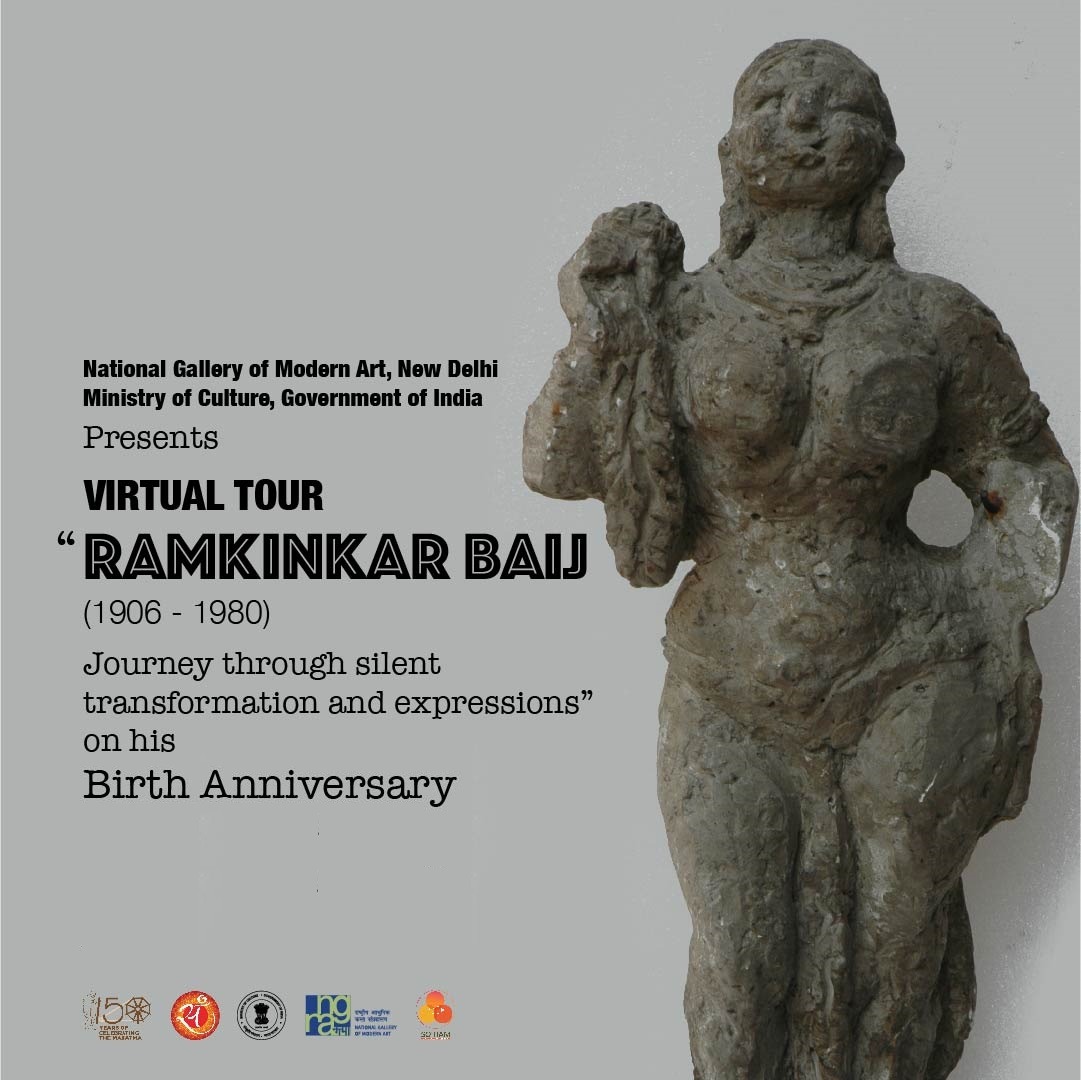 ××××
××××Concept Note
Virtual Tour
Ramkinkar Baij | Journey through silent transformation and expressions The Virtual Tour titled ďRamkinkar Baij | Journey through silent transformation and expressionsĒ is organized to commemorate the 115th Birth Anniversary of Ramkinkar Baij on 26th May 2020. Ramkinkar Baij, one of the most seminal artists of modern India, was an iconic sculptor, painter and graphic artist. In 1970, the Government of India honoured him with the Padma Bhushan for his irrefutable contribution to Indian art. Ramkinkar's monumental sculptures are established landmarks in public art. One of the earliest modernists in Indian art, he assimilated the idioms of the European modern visual language and yet was rooted in his own Indian ethos. He experimented restlessly with forms, moving freely from figurative to abstract and back to figurative, his themes were steeped in a deep sense of humanism and an instinctive understanding of the symbiotic relationship between man and nature. Both in his paintings and sculptures, he pushed the limits of experimentation and ventured into the use of new materials. For instance, his use of unconventional material, for the time, such as cement concrete for his monumental public sculptures set a new precedent for art practices. The NGMA takes pride in 639 works of art created by the iconic artist. This virtual tour presents the 520 works of art from the prominent artworks of Ramkinkar Baij from reserve collection of NGMA, grouped in a series of five different themes of (i) Portrait, (ii) Life Study, (iii) Abstract & Structural Composition, (iv) Nature Study & Landscape and (v) Sculptures. This virtual tour also showcases three sketch books from the collection of NGMA containing 182 works of art. I would urge our esteemed visitors to visit our web site to explore the complete works of art of Ramkinkar Baij through his silent transformation and expressions. I take pride of the tireless effort of our entire IT Cell to conceive and conceptualize the idea of launching Virtual Tours and designed and developed the same amidst lock down period to facilitate our esteemed visitors with the prestigious collection of NGMA. -
Sculpture
 ×Ramkinker Baij's sculptures as well as paintings have a expressionist tendency. For his sculptures he used local materials generously and worked with the technique of modelling and carving. His work are characterised by tremendous energy. This zeal of his is reflected in all his works, be it any medium. His studies of sculpture are interesting too, reflecting his techniques and zeal. This sculpture in bronze shows a mother carrying a child in a perambulator.
×Ramkinker Baij's sculptures as well as paintings have a expressionist tendency. For his sculptures he used local materials generously and worked with the technique of modelling and carving. His work are characterised by tremendous energy. This zeal of his is reflected in all his works, be it any medium. His studies of sculpture are interesting too, reflecting his techniques and zeal. This sculpture in bronze shows a mother carrying a child in a perambulator. -
Sculpture
 ×The sculpture cast in bronze depicts the winnower in action, a modernist portrayal of indigenous life.
×The sculpture cast in bronze depicts the winnower in action, a modernist portrayal of indigenous life. -
Sculpture
 ×A bronze sculpture in his signature style depicting an amorous theme.
×A bronze sculpture in his signature style depicting an amorous theme. -
Sculpture
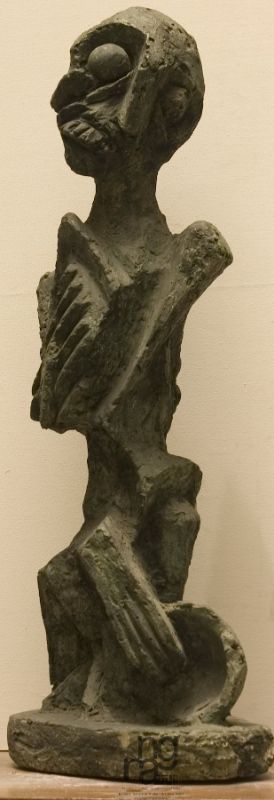 ×Ramkinker Baij's sculptures as well as paintings have a expressionist tendency. For his sculptures he used local materials generously and worked with the technique of modelling and carving. His work are characterised by tremendous energy. This zeal of his is reflected in all his works, be it any medium. His sculptures reflect and abstraction in form, a distorted anatomy, but highlights the characteristics defining the form, with a three dimensional quality given to it for the viewer to enjoy it from any given angle. This sculpture, very cubist in style, reflects the famine through the portrayal of the skeletal figure.
×Ramkinker Baij's sculptures as well as paintings have a expressionist tendency. For his sculptures he used local materials generously and worked with the technique of modelling and carving. His work are characterised by tremendous energy. This zeal of his is reflected in all his works, be it any medium. His sculptures reflect and abstraction in form, a distorted anatomy, but highlights the characteristics defining the form, with a three dimensional quality given to it for the viewer to enjoy it from any given angle. This sculpture, very cubist in style, reflects the famine through the portrayal of the skeletal figure. -
Sculpture
 ×Ramkinker Baij as sculptures as well as paintings have a expressionist tendency. For his sculptures he used local materials generously and worked with the technique of modelling and carving. His work are characterised by tremendous energy. This zeal of his is reflected in all his works, be it any medium. His sculptures reflect and abstraction in form, a distorted anatomy, but highlights the characteristics defining the form, with a three dimensional quality given to it for the viewer to enjoy it from any given angle. This sculpture made in cement, depicts the study of a 'coolie mother' in the characteristic style of Baij.
×Ramkinker Baij as sculptures as well as paintings have a expressionist tendency. For his sculptures he used local materials generously and worked with the technique of modelling and carving. His work are characterised by tremendous energy. This zeal of his is reflected in all his works, be it any medium. His sculptures reflect and abstraction in form, a distorted anatomy, but highlights the characteristics defining the form, with a three dimensional quality given to it for the viewer to enjoy it from any given angle. This sculpture made in cement, depicts the study of a 'coolie mother' in the characteristic style of Baij. -
Sculpture
 ×Ramkinker Baijís sculptures as well as paintings have a expressionist tendency. For his sculptures he used local materials generously and worked with the technique of modelling and carving. His work are characterised by tremendous energy. This zeal of his is reflected in all his works, be it any medium. His sculptures reflect and abstraction in form, a distorted anatomy, but highlights the characteristics defining the form, with a three dimensional quality given to it for the viewer to enjoy it from any given angle. This sculpture is a study of the couple entwined together.
×Ramkinker Baijís sculptures as well as paintings have a expressionist tendency. For his sculptures he used local materials generously and worked with the technique of modelling and carving. His work are characterised by tremendous energy. This zeal of his is reflected in all his works, be it any medium. His sculptures reflect and abstraction in form, a distorted anatomy, but highlights the characteristics defining the form, with a three dimensional quality given to it for the viewer to enjoy it from any given angle. This sculpture is a study of the couple entwined together. -
Sculpture
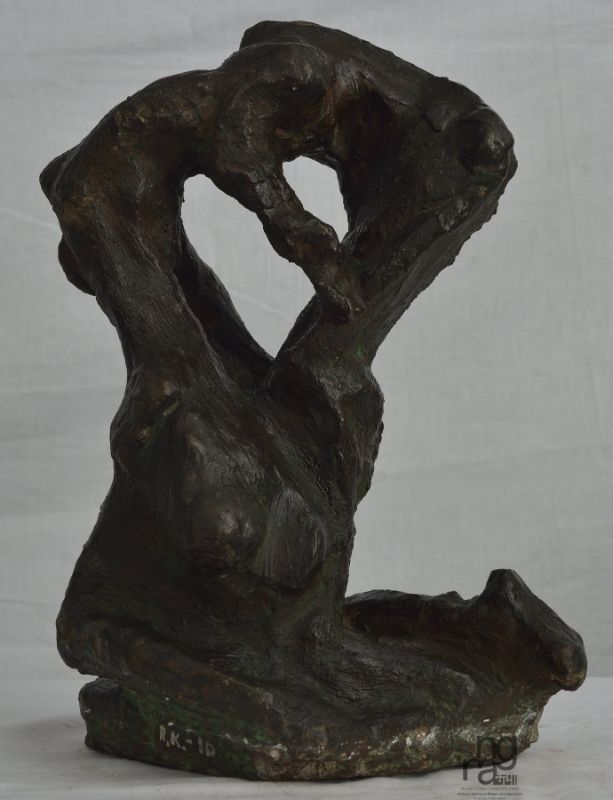 ×A cement study in his signature style depicting an amorous theme.
×A cement study in his signature style depicting an amorous theme. -
Sculpture
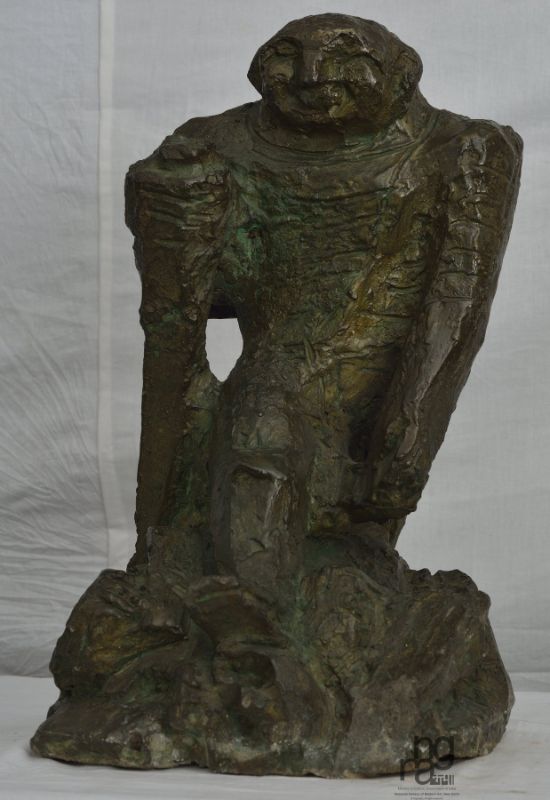 ×A cement study for sculpture depicting the Mahatma in his famous Dandi March stand, also called the Salt March.
×A cement study for sculpture depicting the Mahatma in his famous Dandi March stand, also called the Salt March. -
Sculpture
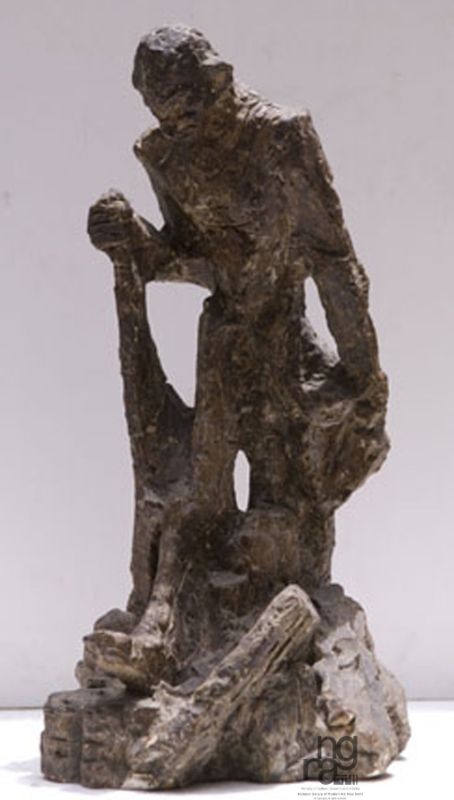 ×Ramkinker Baijís sculptures as well as paintings have a expressionist tendency. For his sculptures he used local materials generously and worked with the technique of modelling and carving. His work are characterised by tremendous energy. This zeal of his is reflected in all his works, be it any medium. His sculptures reflect and abstraction in form, a distorted anatomy, but highlights the characteristics defining the form, with a three dimensional quality given to it for the viewer to enjoy it from any given angle. This sculpture similarly depicts the iconic pose of Mahatma Gandhi on the Dandi March.
×Ramkinker Baijís sculptures as well as paintings have a expressionist tendency. For his sculptures he used local materials generously and worked with the technique of modelling and carving. His work are characterised by tremendous energy. This zeal of his is reflected in all his works, be it any medium. His sculptures reflect and abstraction in form, a distorted anatomy, but highlights the characteristics defining the form, with a three dimensional quality given to it for the viewer to enjoy it from any given angle. This sculpture similarly depicts the iconic pose of Mahatma Gandhi on the Dandi March. -
Sculpture
 ×A plaster cast depicting Netaji Subhash Chandra Bose on a magnificent steed.
×A plaster cast depicting Netaji Subhash Chandra Bose on a magnificent steed. -
Sculpture
 ×Ramkinker Baijís sculptures as well as paintings have a expressionist tendency. For his sculptures he used local materials generously and worked with the technique of modelling and carving. His work are characterised by tremendous energy. This zeal of his is reflected in all his works, be it any medium. His sculptures reflect and abstraction in form, a distorted anatomy, but highlights the characteristics defining the form, with a three dimensional quality given to it for the viewer to enjoy it from any given angle. This sculpture is a beautiful depiction with the spiraling form of the couple in Mithuna.
×Ramkinker Baijís sculptures as well as paintings have a expressionist tendency. For his sculptures he used local materials generously and worked with the technique of modelling and carving. His work are characterised by tremendous energy. This zeal of his is reflected in all his works, be it any medium. His sculptures reflect and abstraction in form, a distorted anatomy, but highlights the characteristics defining the form, with a three dimensional quality given to it for the viewer to enjoy it from any given angle. This sculpture is a beautiful depiction with the spiraling form of the couple in Mithuna. -
Sculpture
 ×A study for design of a fountain in cement to be realized later.
×A study for design of a fountain in cement to be realized later. -
Sculpture
 ×Ramkinker Baijís sculptures as well as paintings have a expressionist tendency. For his sculptures he used local materials generously and worked with the technique of modelling and carving. His work are characterised by tremendous energy. This zeal of his is reflected in all his works, be it any medium. His sculptures reflect and abstraction in form, a distorted anatomy, but highlights the characteristics defining the form, with a three dimensional quality given to it for the viewer to enjoy it from any given angle. This sculpture depicts the representation of a mother and child.
×Ramkinker Baijís sculptures as well as paintings have a expressionist tendency. For his sculptures he used local materials generously and worked with the technique of modelling and carving. His work are characterised by tremendous energy. This zeal of his is reflected in all his works, be it any medium. His sculptures reflect and abstraction in form, a distorted anatomy, but highlights the characteristics defining the form, with a three dimensional quality given to it for the viewer to enjoy it from any given angle. This sculpture depicts the representation of a mother and child. -
Sculpture
 ×Ramkinker Baijís sculptures as well as paintings have a expressionist tendency. For his sculptures he used local materials generously and worked with the technique of modelling and carving. His work are characterised by tremendous energy. This zeal of his is reflected in all his works, be it any medium. His sculptures reflect and abstraction in form, a distorted anatomy, but highlights the characteristics defining the form, with a three dimensional quality given to it for the viewer to enjoy it from any given angle. This sculpture similarly depicts the knife sharpener at his task.
×Ramkinker Baijís sculptures as well as paintings have a expressionist tendency. For his sculptures he used local materials generously and worked with the technique of modelling and carving. His work are characterised by tremendous energy. This zeal of his is reflected in all his works, be it any medium. His sculptures reflect and abstraction in form, a distorted anatomy, but highlights the characteristics defining the form, with a three dimensional quality given to it for the viewer to enjoy it from any given angle. This sculpture similarly depicts the knife sharpener at his task. -
Sculpture
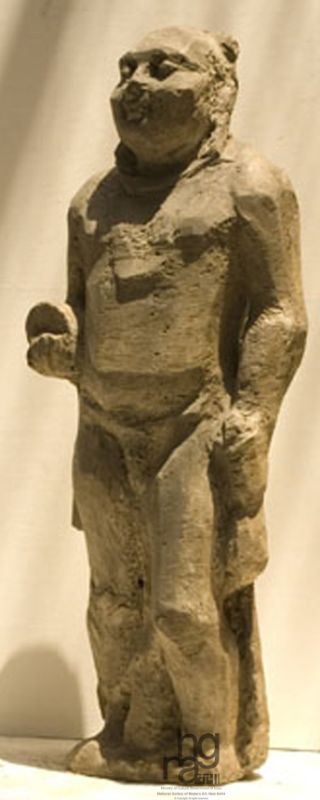 ×Ramkinker Baijís work are characterised by tremendous energy. His sculptures as well as paintings have a expressionist tendency. For his sculptures he used local materials generously and worked with the technique of modelling and carving. Ramkinder Baij was selected as a sculptor for the idea of making the sculptures of Yaksha and Yakshi at the RBI building in New delhi. He made varies studies in plaster† prior to the original sculptures in stone. This sculpture study in plaster depicts a Yaksha form.†
×Ramkinker Baijís work are characterised by tremendous energy. His sculptures as well as paintings have a expressionist tendency. For his sculptures he used local materials generously and worked with the technique of modelling and carving. Ramkinder Baij was selected as a sculptor for the idea of making the sculptures of Yaksha and Yakshi at the RBI building in New delhi. He made varies studies in plaster† prior to the original sculptures in stone. This sculpture study in plaster depicts a Yaksha form.† -
Sculpture
 ×Ramkinker Baij's work are characterised by tremendous energy. His sculptures as well as paintings have a expressionist tendency. For his sculptures he used local materials generously and worked with the technique of modelling and carving. Ramkinder Baij was selected as a sculptor for the idea of making the sculptures of Yaksha and Yakshi at the RBI building in New delhi. He made varies studies in different mediums prior to the original sculptures in stone.† This sculpture is a study depicting a Yakshi.
×Ramkinker Baij's work are characterised by tremendous energy. His sculptures as well as paintings have a expressionist tendency. For his sculptures he used local materials generously and worked with the technique of modelling and carving. Ramkinder Baij was selected as a sculptor for the idea of making the sculptures of Yaksha and Yakshi at the RBI building in New delhi. He made varies studies in different mediums prior to the original sculptures in stone.† This sculpture is a study depicting a Yakshi. -
Sculpture
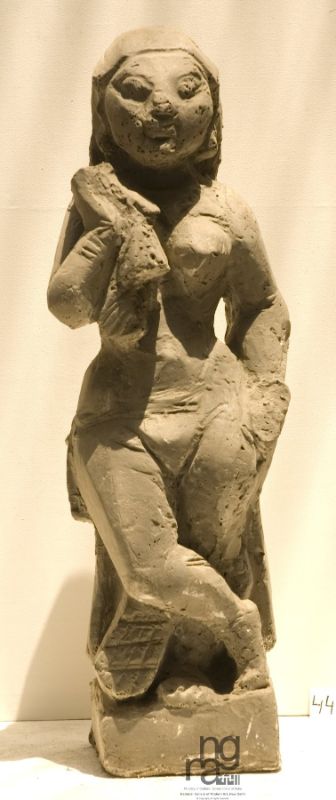 ×Ramkinker Baij's work are characterised by tremendous energy. His sculptures as well as paintings have a expressionist tendency. For his sculptures he used local materials generously and worked with the technique of modelling and carving. Ramkinder Baij was selected as a sculptor for the idea of making the sculptures of Yaksha and Yakshi at the RBI building in New Delhi. He made varies studies in plaster† prior to the original sculptures in stone.† This sculpture is a study depicting a Yakshi.
×Ramkinker Baij's work are characterised by tremendous energy. His sculptures as well as paintings have a expressionist tendency. For his sculptures he used local materials generously and worked with the technique of modelling and carving. Ramkinder Baij was selected as a sculptor for the idea of making the sculptures of Yaksha and Yakshi at the RBI building in New Delhi. He made varies studies in plaster† prior to the original sculptures in stone.† This sculpture is a study depicting a Yakshi. -
Sculpture
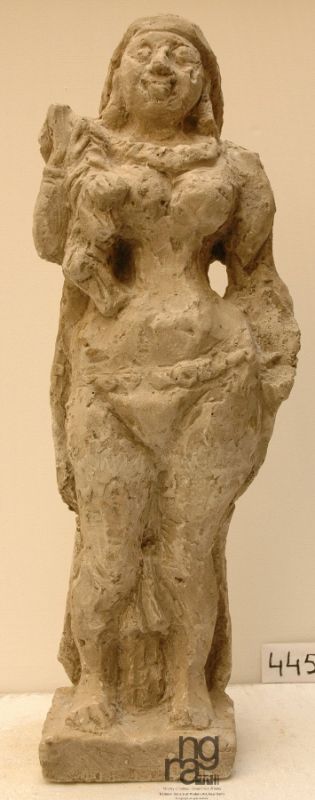 ×Ramkinker Baijís work are characterised by tremendous energy. His sculptures as well as paintings have a expressionist tendency. For his sculptures he used local materials generously and worked with the technique of modelling and carving. Ramkinder Baij was selected as a sculptor for the idea of making the sculptures of Yaksha and Yakshi at the RBI building in New delhi. He made varies studies in plaster† prior to the original sculptures in stone.† This sculpture study in Plaster depicts a Yakshi.†
×Ramkinker Baijís work are characterised by tremendous energy. His sculptures as well as paintings have a expressionist tendency. For his sculptures he used local materials generously and worked with the technique of modelling and carving. Ramkinder Baij was selected as a sculptor for the idea of making the sculptures of Yaksha and Yakshi at the RBI building in New delhi. He made varies studies in plaster† prior to the original sculptures in stone.† This sculpture study in Plaster depicts a Yakshi.† -
Sculpture
 ×Ramkinker Baij's work are characterised by tremendous energy. His sculptures as well as paintings have a expressionist tendency. For his sculptures he used local materials generously and worked with the technique of modelling and carving. Ramkinder Baij was selected as a sculptor for the idea of making the sculptures of Yaksha and Yakshi at the RBI building in New Delhi. He made varies studies in various materials prior to the original sculptures in stone.† This sculpture in plaster is a study depicting a Yakshi.
×Ramkinker Baij's work are characterised by tremendous energy. His sculptures as well as paintings have a expressionist tendency. For his sculptures he used local materials generously and worked with the technique of modelling and carving. Ramkinder Baij was selected as a sculptor for the idea of making the sculptures of Yaksha and Yakshi at the RBI building in New Delhi. He made varies studies in various materials prior to the original sculptures in stone.† This sculpture in plaster is a study depicting a Yakshi. -
Sculpture
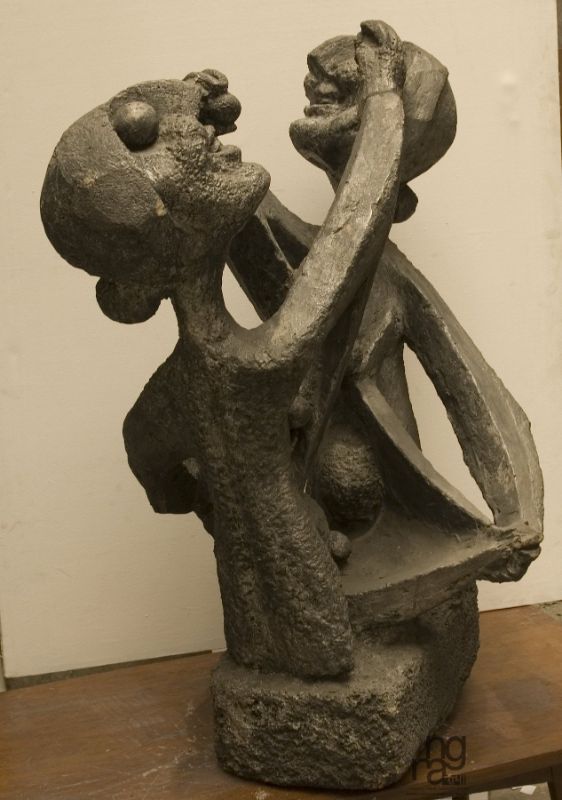 ×Ramkinker Baij's sculptures as well as paintings have a expressionist tendency. For his sculptures he used local materials generously and worked with the technique of modelling and carving. His work are characterised by tremendous energy. This zeal of his is reflected in all his works, be it any medium. His sculptures reflect and abstraction in form, a distorted anatomy, but highlights the characteristics defining the form, with a three dimensional quality given to it for the viewer to enjoy it from any given angle. This sculpture similarly depicts the act of the fruit gatherers.
×Ramkinker Baij's sculptures as well as paintings have a expressionist tendency. For his sculptures he used local materials generously and worked with the technique of modelling and carving. His work are characterised by tremendous energy. This zeal of his is reflected in all his works, be it any medium. His sculptures reflect and abstraction in form, a distorted anatomy, but highlights the characteristics defining the form, with a three dimensional quality given to it for the viewer to enjoy it from any given angle. This sculpture similarly depicts the act of the fruit gatherers. -
Sculpture
 ×Ramkinker Baij's work are characterised by tremendous energy. His sculptures as well as paintings have a expressionist tendency. For his sculptures he used local materials generously and worked with the technique of modelling and carving. Ramkinder Baij was selected as a sculptor for the idea of making the sculptures of Yaksha and Yakshi at the RBI building in New Delhi. He made varies studies in different materials prior to the original sculptures in stone.† This sculpture is a study depicting a Yaksha.†
×Ramkinker Baij's work are characterised by tremendous energy. His sculptures as well as paintings have a expressionist tendency. For his sculptures he used local materials generously and worked with the technique of modelling and carving. Ramkinder Baij was selected as a sculptor for the idea of making the sculptures of Yaksha and Yakshi at the RBI building in New Delhi. He made varies studies in different materials prior to the original sculptures in stone.† This sculpture is a study depicting a Yaksha.† -
Sculpture
 ×A model or study of the Yakshi in plaster to be realized into the future final colossal sculpture for Reserve Bank of India.
×A model or study of the Yakshi in plaster to be realized into the future final colossal sculpture for Reserve Bank of India. -
Sculpture
 ×Ramkinker Baij's work are characterised by tremendous energy. His sculptures as well as paintings have a expressionist tendency. For his sculptures he used local materials generously and worked with the technique of modelling and carving. Ramkinder Baij was selected as a sculptor for the idea of making the sculptures of Yaksha and Yakshi at the RBI building in New delhi. He made varies studies in plaster† prior to the original sculptures in stone,† This sculpture study depicts a Yaksha form.†
×Ramkinker Baij's work are characterised by tremendous energy. His sculptures as well as paintings have a expressionist tendency. For his sculptures he used local materials generously and worked with the technique of modelling and carving. Ramkinder Baij was selected as a sculptor for the idea of making the sculptures of Yaksha and Yakshi at the RBI building in New delhi. He made varies studies in plaster† prior to the original sculptures in stone,† This sculpture study depicts a Yaksha form.† -
Sculpture
 ×Ramkinker Baij's work are characterised by tremendous energy. His sculptures as well as paintings have a expressionist tendency. For his sculptures he used local materials generously and worked with the technique of modelling and carving,† This sculpture depicts a Yakshi bearing a child.† Very rounded in its form, the artist uses plaster to execute it.
×Ramkinker Baij's work are characterised by tremendous energy. His sculptures as well as paintings have a expressionist tendency. For his sculptures he used local materials generously and worked with the technique of modelling and carving,† This sculpture depicts a Yakshi bearing a child.† Very rounded in its form, the artist uses plaster to execute it. -
Sculpture
 ×Ramkinker Baij's sculptures as well as paintings have a expressionist tendency. For his sculptures he used local materials generously and worked with the technique of modelling and carving. His work are characterised by tremendous energy. This zeal of his is reflected in all his works, be it any medium. His studies of sculpture are interesting too, reflecting his techniques and zeal. This relief sculpture, showing the influence of the European composition and technique depicts the birth of Fire.
×Ramkinker Baij's sculptures as well as paintings have a expressionist tendency. For his sculptures he used local materials generously and worked with the technique of modelling and carving. His work are characterised by tremendous energy. This zeal of his is reflected in all his works, be it any medium. His studies of sculpture are interesting too, reflecting his techniques and zeal. This relief sculpture, showing the influence of the European composition and technique depicts the birth of Fire. -
Sculpture
 ×Ramkinker Baij's sculptures as well as paintings have a expressionist tendency. For his sculptures he used local materials generously and worked with the technique of modelling and carving. His work are characterised by tremendous energy. This zeal of his is reflected in all his works, be it any medium. His studies of sculpture are interesting too, reflecting his techniques and zeal. This clay Maquette is a study of a female figure.
×Ramkinker Baij's sculptures as well as paintings have a expressionist tendency. For his sculptures he used local materials generously and worked with the technique of modelling and carving. His work are characterised by tremendous energy. This zeal of his is reflected in all his works, be it any medium. His studies of sculpture are interesting too, reflecting his techniques and zeal. This clay Maquette is a study of a female figure. -
Sculpture
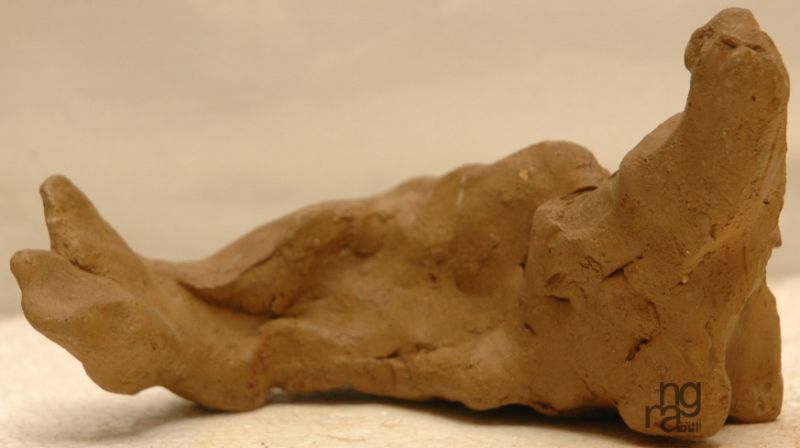 ×Ramkinker Baij's sculptures as well as paintings have a expressionist tendency. For his sculptures he used local materials generously and worked with the technique of modelling and carving. His work are characterised by tremendous energy. This zeal of his is reflected in all his works, be it any medium. His studies of sculpture are interesting too, reflecting his techniques and zeal. This clay Maquette shows a study a zoomorphic form.
×Ramkinker Baij's sculptures as well as paintings have a expressionist tendency. For his sculptures he used local materials generously and worked with the technique of modelling and carving. His work are characterised by tremendous energy. This zeal of his is reflected in all his works, be it any medium. His studies of sculpture are interesting too, reflecting his techniques and zeal. This clay Maquette shows a study a zoomorphic form. -
Sculpture
 ×Ramkinker Baij's sculptures as well as paintings have a expressionist tendency. For his sculptures he used local materials generously and worked with the technique of modelling and carving. His work are characterised by tremendous energy. This zeal of his is reflected in all his works, be it any medium. His studies of sculpture are interesting too, reflecting his techniques and zeal. This Clay maquette is a study of organic Integrated human forms.
×Ramkinker Baij's sculptures as well as paintings have a expressionist tendency. For his sculptures he used local materials generously and worked with the technique of modelling and carving. His work are characterised by tremendous energy. This zeal of his is reflected in all his works, be it any medium. His studies of sculpture are interesting too, reflecting his techniques and zeal. This Clay maquette is a study of organic Integrated human forms. -
Sculpture
 ×Ramkinker Baijís sculptures as well as paintings have a expressionist tendency. For his sculptures he used local materials generously and worked with the technique of modelling and carving. His work are characterised by tremendous energy. This zeal of his is reflected in all his works, be it any medium. His sculptures reflect and abstraction in form, a distorted anatomy, but highlights the characteristics defining the form, with a three dimensional quality given to it for the viewer to enjoy it from any given angle. This sculpture depicts the form of a sitting woman.
×Ramkinker Baijís sculptures as well as paintings have a expressionist tendency. For his sculptures he used local materials generously and worked with the technique of modelling and carving. His work are characterised by tremendous energy. This zeal of his is reflected in all his works, be it any medium. His sculptures reflect and abstraction in form, a distorted anatomy, but highlights the characteristics defining the form, with a three dimensional quality given to it for the viewer to enjoy it from any given angle. This sculpture depicts the form of a sitting woman. -
Sculpture
 ×Ramkinker Baij's sculptures as well as paintings have a expressionist tendency. For his sculptures he used local materials generously and worked with the technique of modelling and carving. His work are characterised by tremendous energy. This zeal of his is reflected in all his works, be it any medium. His studies of sculpture are interesting too, reflecting his techniques and zeal.
×Ramkinker Baij's sculptures as well as paintings have a expressionist tendency. For his sculptures he used local materials generously and worked with the technique of modelling and carving. His work are characterised by tremendous energy. This zeal of his is reflected in all his works, be it any medium. His studies of sculpture are interesting too, reflecting his techniques and zeal. -
Sculpture
 ×Ramkinker Baij's sculptures as well as paintings have a expressionist tendency. For his sculptures he used local materials generously and worked with the technique of modelling and carving. His work are characterised by tremendous energy. This zeal of his is reflected in all his works, be it any medium. His studies of sculpture are interesting too, reflecting his techniques and zeal. This clay Maquette shows a study of Mother and Child.
×Ramkinker Baij's sculptures as well as paintings have a expressionist tendency. For his sculptures he used local materials generously and worked with the technique of modelling and carving. His work are characterised by tremendous energy. This zeal of his is reflected in all his works, be it any medium. His studies of sculpture are interesting too, reflecting his techniques and zeal. This clay Maquette shows a study of Mother and Child. -
Sculpture
 ×Ramkinker Baij's sculptures as well as paintings have a expressionist tendency. For his sculptures he used local materials generously and worked with the technique of modelling and carving. His work are characterised by tremendous energy. This zeal of his is reflected† in all his works,† be it any medium.† His studies of sculpture are interesting too, reflecting his techniques and zeal. This clay Maquette†shows a study of the fish.
×Ramkinker Baij's sculptures as well as paintings have a expressionist tendency. For his sculptures he used local materials generously and worked with the technique of modelling and carving. His work are characterised by tremendous energy. This zeal of his is reflected† in all his works,† be it any medium.† His studies of sculpture are interesting too, reflecting his techniques and zeal. This clay Maquette†shows a study of the fish. -
Sculpture
 ×Ramkinker Baij's sculptures as well as paintings have a expressionist tendency. For his sculptures he used local materials generously and worked with the technique of modelling and carving. His work are characterised by tremendous energy. This zeal of his is reflected† in all his works,† be it any medium.† In this clay Marquette† showing an animal form too,† his technique and zeal is reflected.
×Ramkinker Baij's sculptures as well as paintings have a expressionist tendency. For his sculptures he used local materials generously and worked with the technique of modelling and carving. His work are characterised by tremendous energy. This zeal of his is reflected† in all his works,† be it any medium.† In this clay Marquette† showing an animal form too,† his technique and zeal is reflected. -
Sculpture
 ×Ramkinker Baij's sculptures as well as paintings have a expressionist tendency. For his sculptures he used local materials generously and worked with the technique of modelling and carving. his work are characterised by tremendous energy.† This zeal of his is reflected in all his works be it any medium. This clay Marquette showing an organic form reflects his technique and zeal.
×Ramkinker Baij's sculptures as well as paintings have a expressionist tendency. For his sculptures he used local materials generously and worked with the technique of modelling and carving. his work are characterised by tremendous energy.† This zeal of his is reflected in all his works be it any medium. This clay Marquette showing an organic form reflects his technique and zeal.





